

History of Phuket
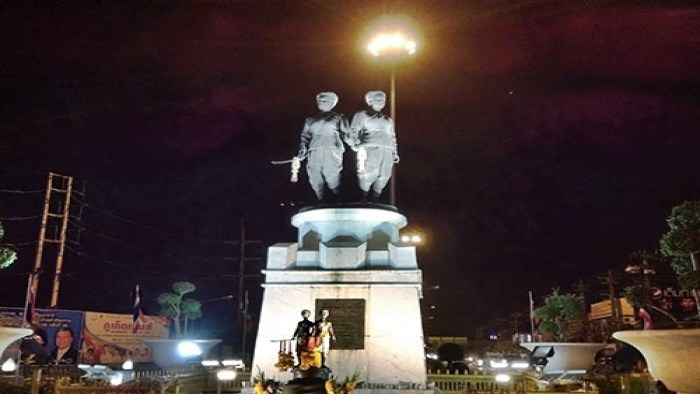
Early History
Located on trading routes between India and China, Phuket was subjected to foreign influences long before many other parts of Thailand. Ships would anchor in the safe harbours of Phuket and wait for the northeast monsoon winds which would allow them to proceed to India.
The interior jungle was inhabited by indigenous tribes until they were displaced in the 19th century by tin miners. The coastal areas were inhabited by Chao Leh , sea-gypsies who made their living through piracy and fishing for pearls. Although threatened by development, Chao Leh villages can still be found along the coast of Phuket and neighbouring islands.
Phuket first became part of a Thai state during the thirteenth century when Thai armies from Sukhothai wrestled control of the island from the Sirivijaya Empire based in Sumatra.
Tin & Rubber
Phuket is first mentioned as a major source of tin in the sixteenth century when the island became an important source of revenue for the Thai kingdom at Ayutthaya , as well as an important trading post. It was also during this period that the first Europeans arrived on Phuket.
Due to Phuket’s abundant supply of tin and its importance as a trading port, the island’s economy continued to prosper. The British secured a tin mining concession and nearly claimed Phuket as part of the British Empire, opting instead for Penang due to its safer harbours. Phuket’s streets were lined with handsome buildings constructed in the Sino-Portuguese style by the tin-barons, many of which can still be seen in older quarters of the town.
At the end of the nineteenth century, the island’s interior still remained relatively untouched. Much of it was still covered in ancient rainforest . However, at the beginning of the twentieth century, large areas of the island were cleared to make way for rubber plantations , irreparably altering the landscape of the island.
Tourism began on the island in the 1970s with the first beach bungalows at Patong beach . During this time Phuket was a haven for backpackers . Phuket’s idyllic tropical beaches and clear warm waters attracted travellers from all over the world to the island. This was facilitated by the building of an airport in the mid-1970s.
Today, tourism is by far the island’s biggest industry with over 3 million tourists visiting the island annually, making Phuket one of the most popular travel destinations in South-East Asia.
Origin of the Name “Phuket”
The name Phuket is derived from the Malay word bukit , meaning hill. The island was previously named Junk Ceylon on European charts, a corruption of the Malay Tanjung Salang meaning Cape Salang. Later it became known as Thalang , after the name of the main town on the island. The island did not come to be known as Phuket until quite late in its history when the administrative centre was moved to a mining town in the centre of the island called Phuket.
The Battle of Thalang

The most celebrated moment in Phuket’s history is when the people of Phuket (then called Thalang), drove away Burmese invaders who were laying siege to the island.
In 1785, Phuket was attacked by the Burmese as part of a wider campaign to invade Thailand (then called Siam). The wife of the recently deceased governor, Lady Chan , along with her sister Lady Muk , rallied the people and broke the Burmese siege.
On hearing of these valiant deeds, the king bestowed honorific titles on these two heroines . Today, their statues can be seen atop a monument at the roundabout a few kilometres north of Phuket City.
To learn more about the history of Phuket a visit to the Thalang National Museum is highly recommended.
You may also like
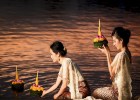
Where to Attend the Loy Krathong Events in Phuket 2023
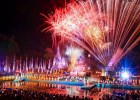
Loy Krathong in Phuket: A Festival of Lights and Water

Phuket Vegetarian Festival: Eat, Pray and Pierce

Events & Festivals

Phuket Vegetarian Festival

Celebrating Songkran Festival in Phuket
Subscribe to our newsletter.
And reach over 3,000 visitors a day.

Phuket Province
Phuket Province: Where History, Culture, and Natural Beauty Converge
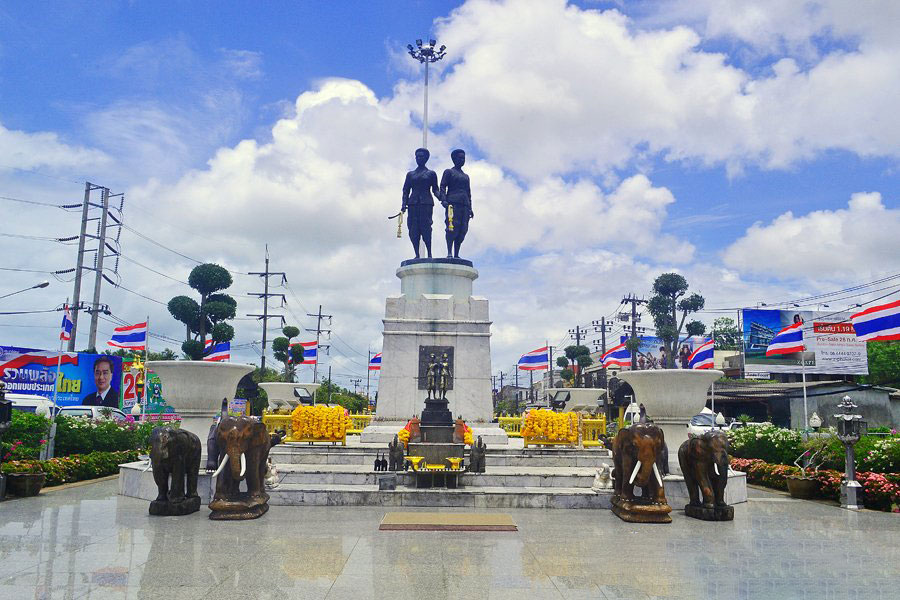
The History of Phuket Province: From Settlement to Tourism
Phuket Province, nestled in the exquisite landscapes of southern Thailand, is renowned for its picturesque beaches, vibrant culture, and thriving tourism industry. But beneath its idyllic façade lies a captivating history that has shaped this tropical paradise into what it is today. Join us on a journey through time as we unveil the intriguing story of Phuket, tracing its origins from ancient settlements to its emergence as a world-class tourism destination.
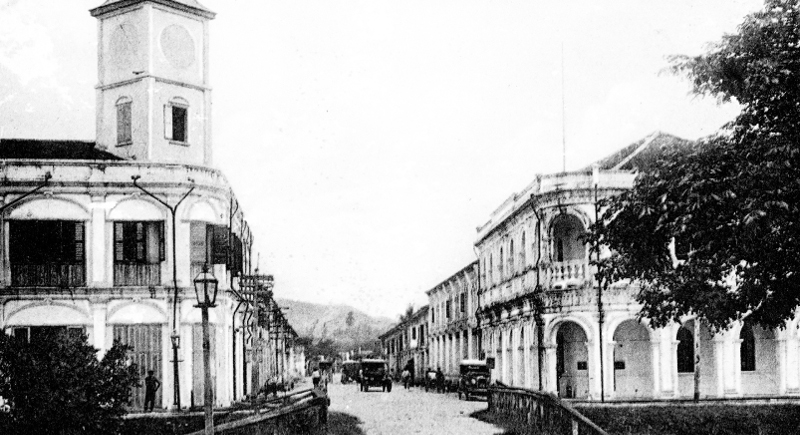
Ancient Beginnings: Phuket’s history can be traced back thousands of years, when it served as a pivotal trading hub in the Andaman Sea. Archaeological findings provide evidence of Phuket’s significance as a bustling seaport, attracting traders from China, India, Arabia, and Europe. These early interactions fostered the exchange of cultures, religions, and ideas, contributing to the island’s unique identity.
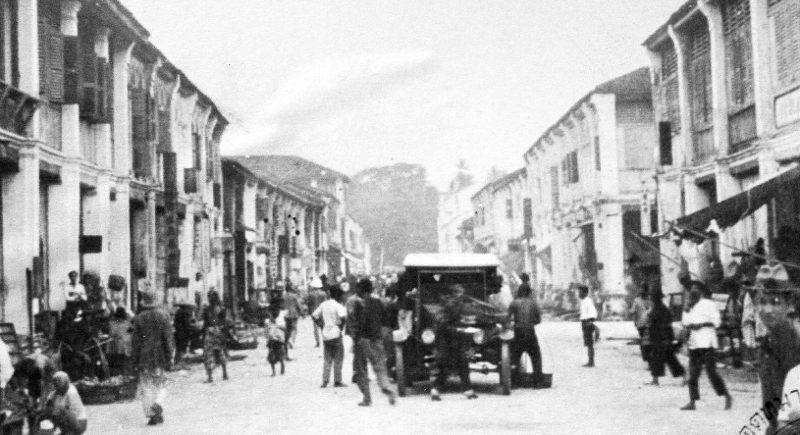
Settlement and Growth: The name “ Phuket ” itself is derived from the Malay word “ Bukit ,” which means hill. This name aptly describes the island’s captivating topography, characterized by verdant hills and breathtaking landscapes. Phuket’s development gained momentum during the 16th century, when it became a refuge for tin miners escaping the oppressive rule of neighboring Sultanates. This influx of settlers laid the foundation for the island’s future prosperity.
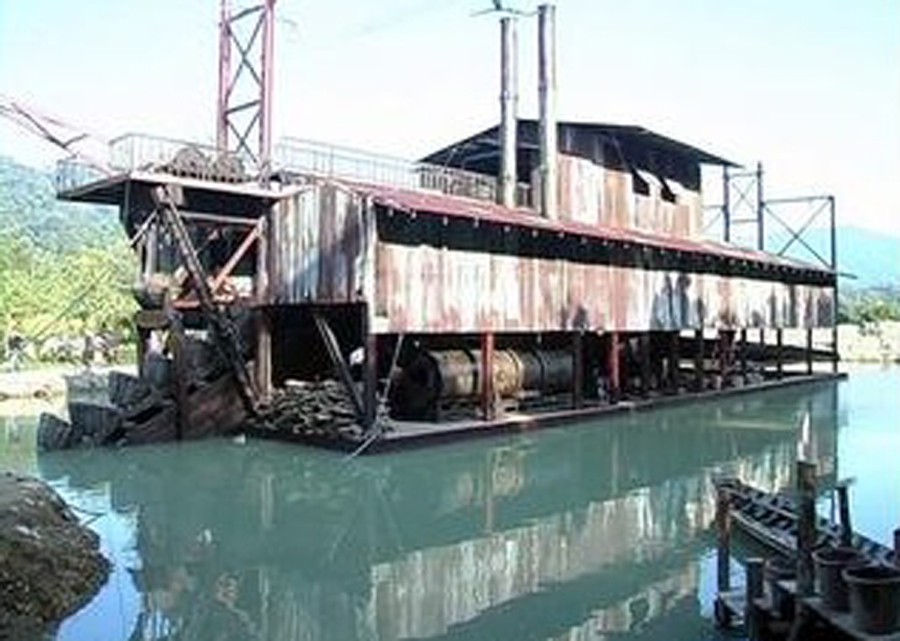
Thriving Tin Industry : During the 18th and 19th centuries, Phuket experienced an unprecedented boom in its tin mining industry. The abundance of tin deposits attracted foreign investors, primarily from China and Europe, who capitalized on this valuable resource. The economic growth fueled by the tin industry led to the establishment of towns, infrastructure development, and an influx of migrants seeking employment opportunities. As a result, Phuket’s population expanded, and its cultural diversity flourished.
Cultural Fusion and Heritage : Phuket’s rich history is deeply intertwined with its multicultural heritage. The influx of immigrants from various regions created a melting pot of cultures, blending Thai, Chinese, Malay, and European influences. This fusion is prominently showcased in Phuket’s architecture, cuisine, traditions, and festivals. The old town of Phuket, with its well-preserved Sino-Portuguese buildings, stands as a testament to this vibrant cultural heritage.
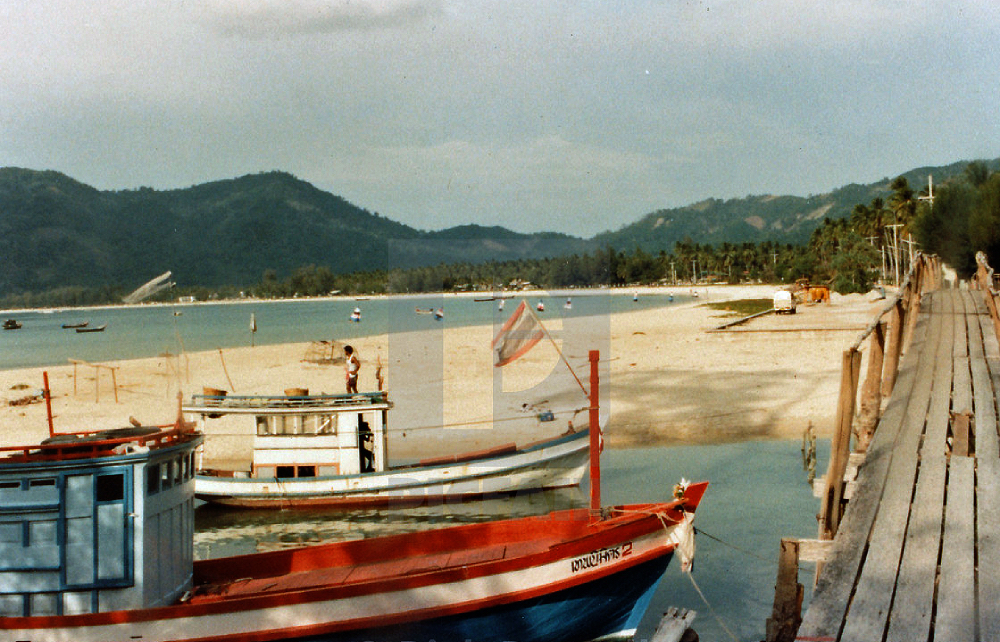
Emergence of Tourism : The turning point in Phuket’s history came with the rise of tourism in the latter half of the 20th century. The island’s pristine beaches, crystal-clear waters, and lush landscapes captivated the imaginations of travelers from around the globe. Recognizing the potential of tourism, the local government and entrepreneurs invested in infrastructure, hotels, and attractions, transforming Phuket into a world-class destination. Today, Phuket attracts millions of tourists annually, offering a plethora of activities, from water sports and island hopping to indulging in Thai hospitality and exploring cultural landmarks.
Sustainable Development and Future Prospects : Phuket’s success as a tourism hotspot has come with its own set of challenges. Balancing the demands of sustainable development and preserving the natural and cultural heritage has become a priority for the local authorities. Initiatives promoting eco-tourism, community-based tourism, and responsible travel have emerged, ensuring that Phuket’s natural beauty and cultural riches are safeguarded for future generations.
Conclusion: The history of Phuket Province is a tapestry woven with ancient trade routes, cultural exchange, and economic transformations. From its humble beginnings as a trading port to its current status as a world-renowned tourism destination, Phuket has evolved while preserving its charm and allure. Whether you visit for its stunning beaches, vibrant culture, or historical landmarks, Phuket offers a captivating experience that combines relaxation, adventure, and a glimpse into its storied past. As you explore this tropical paradise, take a moment to appreciate the layers of history that have shaped Phuket into the remarkable destination it is today.
Remember, whether you’re savoring the flavors of authentic Thai cuisine, marveling at the architectural wonders of Old Phuket Town, or immersing yourself in the local traditions and festivals, you are treading on the footsteps of ancient traders and pioneers who once called this island home. The history of Phuket Province is a testament to the resilience, adaptability, and enduring allure of this remarkable corner of the world.
So, pack your bags, embark on a journey through time, and discover the captivating history that lies beneath the surface of Phuket’s stunning landscapes. Immerse yourself in the rich tapestry of cultures, traditions, and stories that have shaped this vibrant destination. From its humble beginnings as a trading port to its rise as a global tourism hub, Phuket’s history is a testament to the indomitable spirit of its people and the irresistible allure of its natural and cultural treasures. Experience the enchantment of Phuket and create your own unforgettable memories in this tropical paradise.

Phuket, Thailand: Cultural fusion forges connections
Discover the distinctive Peranakan Chinese culture that shaped Thailand’s largest island.
Phuket, Thailand’s lush and mountainous island, glimmers like a polished emerald in the Andaman Sea. Thousands of years before vacationers discovered the sugar-sand beaches ringing the shoreline, the southern Thailand island was home to ancient tribes. Phuket’s next chapter of human history was written by sea-faring traders, gypsies, sailors, and laborers drawn to the island from India, Portugal, England, China, and other far-flung locations. From there, economic opportunity on the island drew people from across Thailand and from neighboring Malaysia, Indonesia, and Myanmar.
This cultural fusion spread across the centuries makes Phuket unlike any other place in Thailand. For worldly travelers, fully experiencing the enchanting island today means delving into its extraordinary past. Facilitating such in-depth exploration is a specialty of InterContinental ® Hotels & Resorts , the pioneer of global luxury travel with more than 70 years of amassed insider experience. Guests at the beachside InterContinental ® Phuket Resort , for example, benefit from the cultural wisdom of the expert hotel staff whose extensive knowledge of Phuket history and traditions inspires discovery.

Enjoy a stunning sunset at the InterContinental® Phuket Resort, while savoring bites such as sea bass, lobster, or pata negra.
One particularly fascinating aspect of Phuket’s multicultural mix is Baba Yaya , or Phuket Baba, the colloquial term used to describe the island’s Peranakan Chinese community. Originating from enterprising Hokkien Chinese laborers and merchants who arrived on the Malay Peninsula hundreds of years ago, Phuket Baba is a distinctive, living culture blending Chinese, Thai, and European influences. In Malay, male Peranakan (descendants of the Chinese immigrants who married local Malay women) are called Baba and female Peranakan are Nyonya .
During Phuket’s 19th-century tin-mining heyday, multicultural Peranakan Chinese from across Southeast Asia and immigrants from mainland China descended upon the island to work in the mining industry, on rubber plantations, and as traders and fishermen. From this influx grew a tight-knit and increasingly prosperous community of Phuket Baba, whose influence permeates Phuket culture, cuisine, and even architecture. The wealthiest of these merchants and families built elaborate Sino-Portuguese-style mansions and shophouses in Phuket Town, the capital and largest town of Phuket province. One of the original Peranakan businesses, the medicinal herb shop Nguan Choon Tong, opened in 1905 and is run today by a descendant of the founder.
Dozens of other original Peranakan structures—long, narrow buildings with ornate wooden doors adorned with delicate Chinese fretwork carvings—remain in the compact Old Town district. Many of the buildings have been restored and reborn as shops, restaurants, and guesthouses with facades painted in a rainbow of colors from pale yellow to bright blue. One of the most photogenic collections of colorful buildings is on Soi Romanee, a short, connector street formerly famous for its opium dens, brothels, and other colorful enterprises. The reimagining and repurposing of Old Town heritage sites embodies the ever-evolving fusion of cultures that makes Phuket such an extraordinary and interconnected place.

In the area called Chinatown, a part of Phuket town, find streets build with Portugese style architecture.

Bright vintage Sino-Portuguese architecture dot the streets of Phuket town. These old buildings of European and Chinese styles were constructed more than hundred years ago.
To help visitors gain a deeper understanding of Sino-Portuguese architecture, the island’s enduring Peranakan Chinese heritage, and the captivating history of Old Town, the InterContinental ® Phuket Resort partners with the expert local guides of Old Phuket Tour for private, half-day, and full-day tours of Phuket that include a guided walk through Old Town. Phuket Baba heritage stops on an Old Town tour include the Phuket Thai Hua Museum and Peranakanitat Museum .
Both museums are housed in restored Sino-Portuguese-style buildings, the first in a former Chinese school built in 1934 and the second in a stately, corner bank building. Though small, the museums share the impressive story of Chinese migration and the Phuket Baba community through photographs, artifacts, and exhibits about prominent Peranakan civic leaders, and Peranakan cuisine and traditional attire.
On holidays and special occasions, it’s not uncommon to see modern Phuket Baba women wearing the traditional fashion, called Phuket Nyonya . Typified by long floral skirts, lace tops, and vibrant colors, the regal-looking attire is bedecked with detailed beadwork, embroidered shapes, and decorative brooches.

Nyonya fashion refers to traditional Peranakan clothing. Many women wear Nyonya for weddings or special occasions.
One of the most impressive displays of Nyonya fashion can be seen each June at the annual Phuket Baba Wedding, hosted by the Thai Peranakan Association and its local Phuket partners. The cultural tourism festival, celebrating its tenth year in 2020, welcomes couples from around the world to be married in a traditional Baba wedding, complete with authentic Peranakan wedding attire to wear during the ceremony.
Indubitably the best way to immerse oneself in Phuket Baba culture is through its food, which, like Phuket, is unlike any other fare found in Thailand. Peranakan dishes regularly feature pork, and blend Chinese and local cooking influences and ingredients. At Old Town market stalls, truly adventurous eaters can try the local favorite Phuket street food, Loba —snout-to-tail pork parts braised in a potent five-spice blend and lightly fried to chewy perfection. For more refined Peranakan fare, try Moo Hong, a slow-cooked and aromatic pork belly stew. Two atmospheric Old Town eateries specializing in the dish are Raya and The Charm , both located in restored Sino-Portuguese shophouses.

Reservations are required for the four-course Peranakan feast served at The Blue Elephant Phuket . The internationally acclaimed restaurant and cooking school, housed in a meticulously restored Sino-Portuguese Phuket Town mansion, specializes in Thai fare, but offers a separate Peranakan menu. Choose from a variety of Phuket-style heritage dishes, such as Sam Bai Kor Leang (deep-sea tiger prawns cooked with Thai organic garlic, Red Holy Basil, and coconut milk) and Tubo, a sharable Phuketian dessert made with Adzuki beans, sweet potato, taro, gingko, and coconut cream and served in a coconut shell.
As demonstrated through its distinctive cuisine, architecture, and traditions, Phuket’s Peranakan roots and evolving multicultural identity reinforce how something truly magical happens when diverse people come together to create community. That’s what makes Phuket such an inspiring and life-affirming place for discerning travelers seeking to forge meaningful connections between cultures.
Learn how you can continue fueling your fascination for discovering new places by becoming an InterContinental ® Ambassador .
- Terms of Use
- Privacy Policy
- Your US State Privacy Rights
- Children's Online Privacy Policy
- Interest-Based Ads
- About Nielsen Measurement
- Do Not Sell or Share My Personal Information
- Nat Geo Home
- Attend a Live Event
- Book a Trip
- Inspire Your Kids
- Shop Nat Geo
- Visit the D.C. Museum
- Learn About Our Impact
- Support Our Mission
- Advertise With Us
- Customer Service
- Renew Subscription
- Manage Your Subscription
- Work at Nat Geo
- Sign Up for Our Newsletters
- Contribute to Protect the Planet
Copyright © 1996-2015 National Geographic Society Copyright © 2015-2024 National Geographic Partners, LLC. All rights reserved

A Short History of Phuket Island in Thailand
Phuket is a beautiful and vibrant island in southern Thailand, famous for its beaches, culture, and hospitality. However, beneath its modern façade lies a rich and complex history that has shaped the island’s identity and character. In this article, we will take a journey through Phuket’s past, from its early settlement to its rise as a global tourist destination.
Early Settlement and Maritime Trade
Phuket has a long and rich history that dates back to ancient times. The island was originally inhabited by the sea-faring Mon people who arrived in the 1st century AD. The Mon established a prosperous trading network with neighboring regions, including China, India, and the Malay Peninsula, which contributed to the island’s early economic growth.
In the 7th century, Phuket came under the influence of the Srivijaya Empire, which was a powerful maritime kingdom that dominated trade routes in Southeast Asia. The Srivijaya brought with them Theravada Buddhism, which became the dominant religion on the island and can still be seen in the many temples and monasteries scattered throughout Phuket.
During the 13th century, Phuket became part of the Thai kingdom of Sukhothai, which brought further development to the island. Sukhothai’s rulers encouraged the growth of agriculture, trade, and commerce, which led to the expansion of Phuket’s markets and industries. This period also saw the construction of several important landmarks, such as the Wat Phra Thong temple, which is famous for its half-buried Buddha statue.
Phuket’s strategic location and abundant resources, including tin, rubber, and timber, made it an important trading center in the region. By the 16th century, Phuket had become a major stopover for European traders, including the Portuguese, Dutch, and British, who were drawn to the island’s wealth and natural beauty. This period of foreign influence and trade brought new technologies, ideas, and cultures to Phuket and contributed to the island’s cosmopolitan character.
The early settlement and maritime trade in Phuket played a vital role in shaping the island’s history and culture. The interactions between different cultures and civilizations laid the foundation for Phuket’s future development and contributed to its reputation as a hub of trade, commerce, and hospitality.
Thai Kingdoms and Chinese Influence
In the 13th century, Phuket fell under the influence of the Thai kingdom of Sukhothai, which brought Theravada Buddhism to the island. The arrival of Buddhism had a profound impact on the island’s culture and social fabric, as it became the dominant religion of the local people. The island’s strategic location and natural resources, such as tin and rubber, made it an important trading center in the region. By the 16th century, Phuket had become a major stopover for European traders, including the Portuguese, Dutch, and British.
In the late 18th century, Phuket became part of the Thai kingdom of Thonburi, which was succeeded by the current Chakri dynasty in the early 19th century. The new rulers encouraged Chinese immigrants to settle on the island and engage in tin mining and trading. The Chinese community, which is still prominent in Phuket, brought their own cultural and architectural influences to the island, including their language, food, religion, and festivals.
The Chinese immigrants in Phuket came from different regions of China, such as Fujian, Guangdong, and Hainan, and brought with them their unique customs and traditions. They established their own neighborhoods, called “jui tui” in the Hokkien dialect, which served as centers of commerce, religion, and social activities. The jui tui were characterized by their colorful and ornate architecture, which combined Chinese and European styles and featured intricate carvings, murals, and tile work.
The Chinese community also introduced their religious practices to Phuket, including Taoism, Confucianism, and Mahayana Buddhism. They built many temples and shrines, such as the Jui Tui Shrine and the Put Jaw Temple, which are still popular tourist attractions today. The Chinese festivals, such as the Vegetarian Festival and the Hungry Ghost Festival, are also an integral part of Phuket’s cultural calendar, and attract visitors from all over the world.
The Chinese influence on Phuket’s history and culture is a testament to the island’s diversity and openness to different cultures. The Chinese immigrants have contributed to the island’s economy, architecture, religion, and cuisine, and have left an indelible mark on Phuket’s identity. Today, the Chinese community is an important part of Phuket’s social fabric and continues to preserve and celebrate their heritage.
Tin Mining and Sino-Portuguese Architecture
Tin mining was a major industry in Phuket during the 19th and early 20th centuries, which attracted many foreign investors and laborers. The tin deposits in Phuket were some of the richest in the world, and they provided a valuable source of income for the local population.
As the tin industry grew, so did the demand for housing and infrastructure for the miners and their families. This led to the emergence of a new architectural style, known as Sino-Portuguese, which blended European and Chinese elements and can still be seen in Phuket Old Town.
The Sino-Portuguese architecture in Phuket is characterized by its ornate facades, bright colors, and decorative details such as ceramic tiles, plaster reliefs, and wooden shutters. The style reflects the fusion of Chinese, European, and local influences, which was a hallmark of Phuket’s cosmopolitan culture.
Many of the Sino-Portuguese buildings in Phuket have been restored and converted into shops, cafes, and galleries, which add to the island’s cultural and historical appeal. Walking through the narrow streets and alleys of Phuket Old Town, visitors can admire the architectural diversity and discover the hidden gems of the past.
In addition to the Sino-Portuguese architecture, Phuket also has several other historic landmarks and attractions that showcase its rich heritage, including the Thalang National Museum, the Phuket Thai Hua Museum, and the Jui Tui Shrine.
Overall, the tin mining industry in Phuket had a profound impact on the island’s economy, culture, and architecture, and it helped to shape the identity of the local people. Today, the Sino-Portuguese buildings stand as a testament to Phuket’s past and a source of inspiration for its future.
Phuket’s Post War Transformation
The Second World War had a profound impact on Phuket’s economy and society, as it did on many other parts of the world. Thailand was one of the few countries in Southeast Asia that managed to avoid direct military occupation during the war, but it was not spared the effects of the conflict. The Japanese occupation of Thailand from 1941 to 1945 brought significant changes to the country’s political and economic landscape, which affected Phuket in many ways.
Before the war, Phuket was a small and remote island with a mainly agricultural economy. Its main export was tin, which was extracted from the rich deposits found in the hills and shipped to other countries. The island was also a center of rubber production, fishing, and farming. Phuket was home to a diverse population of people from different ethnic backgrounds, including Thai, Chinese, and Malay.
During the war, Phuket’s economy suffered greatly from the disruption of trade and the scarcity of resources. The Japanese military authorities requisitioned most of the island’s tin output for their war effort, which led to a sharp decline in the local mining industry. The shortage of food and other essential supplies also caused widespread hardship and deprivation among the local population.
The end of the war in 1945 brought a new set of challenges and opportunities for Phuket . With the defeat of Japan and the restoration of Thailand’s independence, the country had to reorient its economy and political system to meet the demands of the postwar world. The Thai government adopted a policy of economic nationalism and industrialization, which aimed to modernize the country and reduce its dependence on foreign powers.
Phuket played a key role in this process of modernization and transformation. The island’s natural resources, including its strategic location, rich deposits of tin and rubber, and abundant marine life, made it an ideal site for development. The Thai government launched a series of programs and initiatives to promote economic growth and social welfare in Phuket, which attracted new investors, businesses, and settlers to the island.
One of the most significant changes that occurred during this period was the expansion of the tourist industry in Phuket. With its stunning beaches, crystal-clear waters, and tropical climate, Phuket became a popular destination for domestic and international travelers . The Thai government invested in infrastructure, such as roads, airports, and hotels, to support the growth of the tourism sector, which generated thousands of jobs and boosted the local economy.
The postwar transformation of Phuket also brought about changes in its society and culture. The influx of new people, ideas, and influences from different parts of Thailand and the world created a more cosmopolitan and diverse community on the island. Phuket became a melting pot of different cultures, with people from different ethnic and religious backgrounds living and working together in harmony.
However, the postwar transformation of Phuket was not without its challenges and setbacks. The rapid expansion of tourism and development also had negative impacts on the environment, social cohesion, and cultural heritage of the island. The local authorities had to balance the benefits of economic growth with the need to preserve the natural and cultural assets of Phuket, and ensure that the benefits of development were shared by all.
Phuket’s postwar transformation was a complex and multifaceted process that involved many different actors and forces. The island underwent significant changes in its economy, society, and culture, which had lasting impacts on its identity and character. Today, Phuket is a vibrant and dynamic place that continues to evolve and adapt to the changing global landscape, while also preserving its rich heritage and natural beauty .
Thai Regional Dominance
One of the earliest kingdoms to exert its influence over Phuket was the Srivijaya Empire, a powerful maritime kingdom that dominated trade routes in Southeast Asia. The Srivijaya brought with them Theravada Buddhism, which became the dominant religion on the island and can still be seen in the many temples and monasteries scattered throughout Phuket.
Phuket’s strategic location and abundant resources, including tin, rubber, and timber, made it an important trading center in the region. By the 16th century, Phuket had become a major stopover for European traders, including the Portuguese, Dutch, and British, who were drawn to the island’s wealth and natural beauty.
Phuket’s location in southern Thailand has also made it a cultural crossroads, where different regional influences meet and merge. The southern region of Thailand, which includes Phuket, has its own distinct dialect, cuisine, and traditions that set it apart from the rest of the country. The southern region has a long history of resistance to central authority and has often been a site of political unrest and conflict.
Today, Phuket is one of the most popular tourist destinations in the world, attracting millions of visitors from all over the globe. The island’s economy is largely driven by tourism, which has brought about significant changes to its culture and way of life. While tourism has provided many benefits to Phuket, it has also posed many challenges, including environmental degradation, overcrowding, and rising costs of living.
The history of Phuket Island history is closely intertwined with the regional dominance that has shaped the landscape of southern Thailand. The island has been shaped by the interplay of different cultures, religions, and regional powers, creating a unique identity and character that is still evident today. As Phuket continues to evolve and adapt to the changing global landscape, it will be important to strike a balance between economic development and cultural preservation, in order to ensure a sustainable and vibrant future for the island and its people.
Tourism and Globalization: The Evolution of Phuket’s Economy and Culture
In the late 20th century, Phuket’s economy underwent a significant transformation from tin mining to tourism. The opening of the Phuket International Airport in 1985 marked the beginning of a new era of growth and development for the island, as it became more accessible to international travelers.
The tourism industry in Phuket has grown rapidly over the past few decades, with millions of visitors from all over the world flocking to the island each year. Tourists are drawn to Phuket’s beautiful beaches , clear waters, tropical climate, and diverse cultural offerings.
As the tourism industry grew, it also brought about significant changes to Phuket’s economy and culture. New hotels, resorts, restaurants, and entertainment venues sprung up across the island, creating thousands of jobs and driving local economic growth.
However, the rapid expansion of tourism also posed many challenges for Phuket, including environmental degradation, overcrowding, and rising costs of living. In recent years, the local authorities have taken steps to address these issues by promoting sustainable tourism practices and implementing measures to protect the island’s natural resources.
In addition to its economic impact, tourism has also had a profound cultural influence on Phuket. The island has become a melting pot of different cultures, with visitors and expats from around the world bringing their own customs, beliefs, and languages. This diversity has enriched Phuket’s cultural offerings, with a wide range of festivals, events, and activities that celebrate the island’s multicultural heritage.
However, tourism has also posed challenges to Phuket’s traditional way of life, with some locals feeling marginalized by the influx of foreign influence and values. There have been efforts to preserve and promote Phuket’s traditional arts, crafts, and practices, while also embracing new and innovative ideas.
The growth of tourism and globalization has had a profound impact on Phuket’s economy and culture. While the tourism industry has brought many benefits to the island, it has also posed many challenges that require careful management and planning. As Phuket continues to evolve and adapt to the changing global landscape, it will be important to strike a balance between economic development and cultural preservation, in order to ensure a sustainable and vibrant future for the island and its people.
The History of Phuket Summary
- Phuket has a long and rich history dating back to ancient times, when it was inhabited by the Mon people who established a prosperous trade network with neighboring regions.
- In the 13th century, Phuket became part of the Thai kingdom of Sukhothai, which brought further development to the island and the expansion of its markets and industries.
- The Chinese immigrants, who settled on the island in the late 18th century and engaged in tin mining and trading, brought their own cultural and architectural influences to Phuket.
- The Sino-Portuguese architecture, which blends European and Chinese elements, emerged during the 19th and early 20th centuries as a result of the growing tin mining industry.
- The opening of the Phuket International Airport in 1985 marked a significant transformation of Phuket’s economy from tin mining to tourism, which has become the island’s main industry.
- The tourism industry has brought about significant changes to Phuket’s economy and culture, and contributed to the island’s diversity and openness to different cultures.
- However, the rapid expansion of tourism also posed many challenges for Phuket, including environmental degradation, overcrowding, and rising costs of living.
- Phuket has been striving to balance economic development and cultural preservation, promoting sustainable tourism practices and implementing measures to protect the island’s natural resources.
https://phuketislandguide.com/phuket-guides/understanding-the-population-of-phuket-a-look-at-demographics-and-trends/
https://phuketislandguide.com/phuket-guides/exploring-the-colorful-culture-and-traditions-in-phuket/

Lisa Boonmee
Unwind on the sand: the ultimate list of phuket resorts on the beach, understanding the population of phuket: a look at demographics and trends.
- City Guides
- Events & Festivals
- Family Vacation Ideas
- Leisure Activities
Social Links

A Brief History of Phuket
An overview of phuket's historical appeal.
- December 1, 2023
- Catalina Forbes
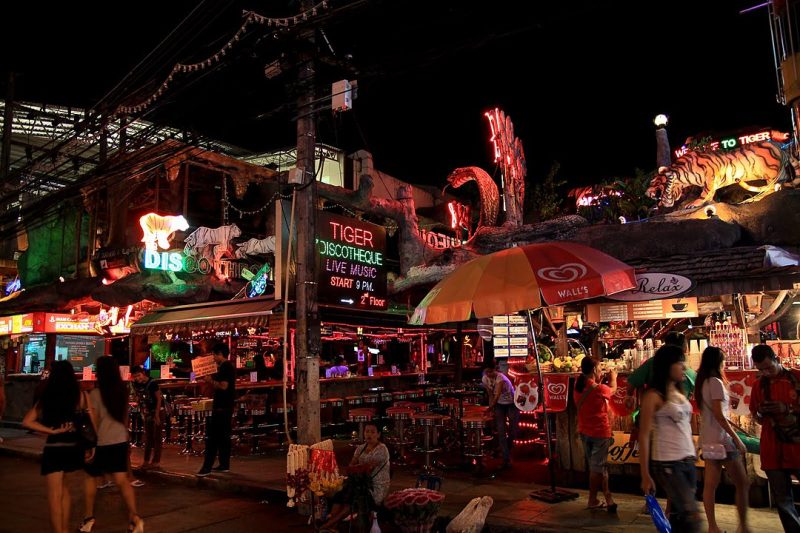
Phuket, Thailand’s largest island, holds a history as vibrant as its tropical landscapes. Take a practical journey through time to unravel the simplicity of Phuket’s past.
Early Roots and Indigenous Settlements
Phuket’s history begins with indigenous communities, predominantly sea-dwelling tribes. The island’s strategic location in the Andaman Sea attracted early settlers who thrived on fishing and maritime trade, laying the foundation for Phuket’s maritime significance.
Influences of Chinese Migration
The simplicity of Phuket’s history took a turn with the arrival of Chinese migrants in the 19th century. Drawn by the island’s economic prospects, the Chinese played a pivotal role in shaping Phuket’s culture, architecture, and commerce, leaving an indelible mark that is still evident today.
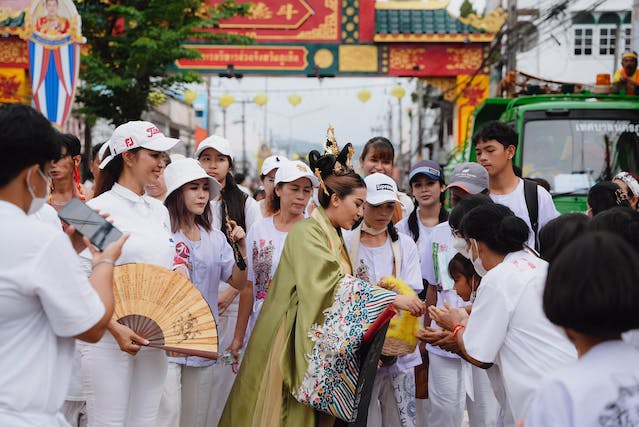
Tin Mining Boom
The late 19th century witnessed a tin mining boom, propelling Phuket into an economic hub. The straightforward allure of tin attracted foreign investors, amplifying the island’s prosperity. The legacy of this era is visible in the historic buildings and cultural influences that dot Phuket’s landscape.
Tourism Transformation
Phuket’s modern history took a significant turn in the latter half of the 20th century with the rise of tourism. The simplicity of the island’s natural beauty attracted global attention, turning Phuket into a renowned tourist destination with the help of the likes of Anantara Mai Khao Phuket Villas . Today, the island’s history unfolds through its bustling streets, vibrant markets, and diverse cultural celebrations that you can enjoy while holidaying at Phuket resorts .
Related Topics
- Anantara Mai Khao Phuket Villas
- Phuket Resorts
Uncover the lesser-known wildlife safaris in Zanzibar – wild creatures
- November 30, 2023

A Handy Guide to Mui Ne, Vietnam
- December 2, 2023
You May Also Like
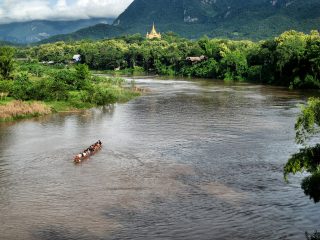
A Guide to Chiang Rai
- April 9, 2024
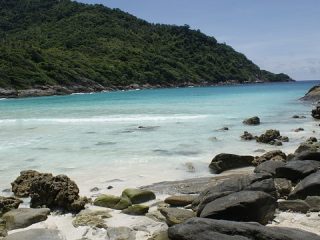
Exploring Paradise
- April 6, 2024
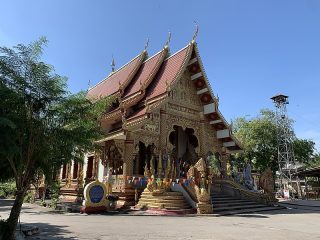
- Attractions
The Must Visit Temples of Phuket
- March 19, 2024
- Lavinia Woolf
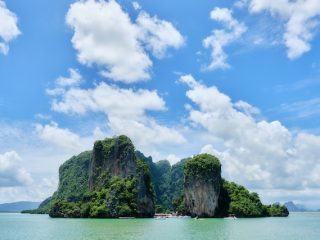
Sustainable Travel Tips for travellers heading to Koh Samui
- December 31, 2023
- Fritzjames Stephen
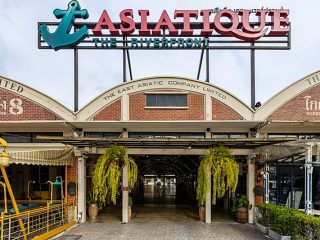
Riverside Bangkok
- December 14, 2023
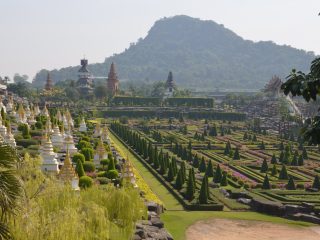
Pattaya Unveiled
- December 7, 2023
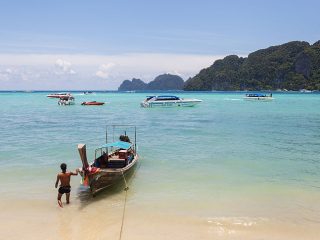
Island-hopping through Phuket
- December 4, 2023
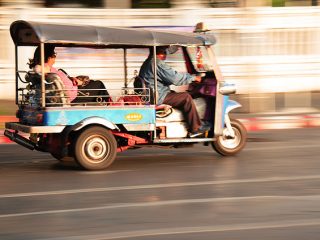
Ensuring a Smooth Vacation in Thailand
- December 3, 2023
Input your search keywords and press Enter.
We Love Phuket
Phuket travel guide & tourist information.
- Accommodation
- Bars & Clubs
- Getting Around
- Travel Insurance
- Restaurants
- Things To Do
Phuket History
Phuket history is a tapestry woven with the threads of diverse cultures, bustling trade routes, and significant historical events. Let’s dive into the fascinating Phuket history!
Early Settlements and Indigenous Peoples
Phuket, a captivating island in Thailand, boasts a rich and fascinating history that stretches back over a thousand years. This ancient land has witnessed the rise and fall of numerous civilizations, leaving behind a tapestry of stories and cultural heritage. From the earliest settlements to the interactions with indigenous peoples, Phuket’s past is a captivating journey through time. Centuries ago, the enchanting island we know today was home to a fascinating community of indigenous sea gypsies called the Chao Leh. These resourceful people thrived by harnessing the bounties of the sea, relying on fishing and engaging in vibrant coastal trade. Their presence on the island adds a rich historical tapestry to its captivating story.
Trades and Maritime Routes
Phuket, a captivating island nestled in the Andaman Sea , holds a fascinating past as a crucial hub along the ancient trade routes connecting India, China, and Southeast Asia. Its strategic location made it an irresistible stop for maritime traders, who would dock their ships here to restock supplies, exchange goods, and immerse themselves in the vibrant local culture. Situated at the crossroads of these bustling trade routes, Phuket became a melting pot of diverse cultures, languages, and traditions. Traders from far-flung corners of the world would converge on its shores, bringing with them a wealth of exotic goods, spices, and treasures. This vibrant exchange of goods and ideas not only shaped Phuket’s economy but also left an indelible mark on its cultural heritage. As you explore Phuket’s historical sites and landmarks, you can still sense the echoes of its maritime past. The old town, with its charming Sino The island has a rich history of cultural diversity, thanks to its interactions with Arab, Indian, Chinese, and European traders.
Colonial Influences
Step back in time to the 16th century, where a captivating era of exploration and expansion unfolded. European colonial powers, with the Portuguese and Dutch leading the charge, embarked on a remarkable journey to establish their presence in the enchanting lands of Southeast Asia. Phuket, with its abundant tin reserves and strategic location, has long been a magnet for various powers throughout Phuket history. This allure has inevitably sparked numerous conflicts, making the region’s past truly captivating.
Siamese Control
During the 17th century, the beautiful island of Phuket fell under the rule of the Ayutthaya Kingdom, which is now known as Thailand. Despite various attempts by European powers to gain control, Phuket remained an important and inseparable part of the Siamese kingdom.
Tin Mining Boom
Phuket history unveils a fascinating chapter during the 18th and 19th centuries when the tin mining industry thrived. The arrival of Chinese immigrants had a profound impact on the culture and heritage of the island as they came to work in the mines.
Tin Price Crash and Transition
Phuket history states that in the 20th century, Phuket, a vibrant island in Thailand, experienced a significant blow to its economy due to the global tin price crash. This unexpected turn of events had far-reaching consequences for the local community, reshaping the island’s economic landscape. The tin industry had long been a cornerstone of Phuket’s economy, with the island being a major player in the global tin market. However, when the global tin prices plummeted, Phuket’s tin mining industry was left reeling. The crash led to a sharp decline in demand and profitability, leaving many businesses and individuals grappling with the aftermath. The repercussions The island underwent a significant shift towards tourism, which became a crucial factor in driving its economy.
Tourism Development
In the mid-20th century, Phuket began to emerge as a tourist destination. The stunning beaches, vibrant culture, and accessibility attracted visitors, leading to the establishment of hotels and infrastructure.
Modern Era of Phuket History
This stunning island has witnessed an incredible surge in its tourism industry during the late 20th and early 21st centuries. Brace yourself for a captivating journey as we delve into the rapid growth that has transformed Phuket into a sought-after destination for travelers from all corners of the globe. The island’s international airport and enhanced transportation infrastructure have played a significant role in making it a sought-after destination for travelers from all corners of the globe.
2004 Indian Ocean Tsunami
In December 2004, Phuket experienced the devastating impact of the Indian Ocean tsunami. This natural disaster left a tragic mark on the island, causing widespread destruction and loss. The disaster served as a catalyst for initiatives aimed at improving disaster preparedness and infrastructure.
Cultural Heritage
Discover the rich cultural heritage of Phuket through its captivating architecture, vibrant festivals, and cherished traditions. Welcome to the captivating Old Phuket Town! This charming area is a treasure trove of Sino-Portuguese architecture and a vibrant fusion of Chinese and European cultural influences. As you wander through its streets, you’ll be transported back in time, surrounded by beautifully preserved buildings that tell tales of Phuket history. The intricate details and vibrant colors of the buildings are a testament to the harmonious blend of Chinese and European aesthetics. Prepare to be enchanted by the unique atmosphere and immerse yourself in the captivating heritage of this remarkable place.
Diverse Community
Phuket is home to a wonderfully diverse community, where Thai locals, ethnic Chinese, and Muslims come together to create a vibrant cultural tapestry. This unique blend of cultures adds an exciting and enriching dimension to the island’s already stunning beauty. Whether you’re exploring the bustling markets, savoring the delicious cuisine, or immersing yourself in the local traditions, you’ll be captivated by the harmonious coexistence of these different communities. Phuket truly offers a one-of-a-kind experience where diversity thrives and cultural exchange flourishes.
Economic and Tourism Hub
Phuket has solidified its position as a leading tourist destination, captivating visitors with its breathtaking beaches, lively nightlife, thrilling water activities, and rich cultural offerings.
This website uses cookies to improve your experience. We'll assume you're ok with this, but you can opt-out if you wish. Read More
About Cookies
Preferences, unclassified.
Username or email address *
Remember me
Register | Lost your password?

- Favorites 0
- List A Property (It's Free)

The Rich Tapestry of Phuket’s History: A Comprehensive Exploration
Introduction.
Known for its sparkling beaches and vibrant culture, Phuket is a popular travel destination. Yet, it’s also an island steeped in history. This article offers a layered and comprehensive look into Phuket’s multifaceted past, tracing its journey from prehistoric times to the present.
Prehistoric Phuket
Before it became a bustling trade hub and tourist destination, Phuket had a long prehistoric past. Archaeological evidence indicates that human settlements existed on the island as far back as the Neolithic era. These early communities were likely connected to the island’s rich marine ecosystems.
A Nexus of Trade and Exploration
The island’s strategic location between India and China made it a critical maritime stopover. Early traders anchored their ships in Phuket’s harbours, waiting for favourable winds to carry them towards India.
The Original Inhabitants
Indigenous tribes originally inhabited Phuket’s interior jungle, while the coastal areas were home to the Chao Leh sea-gypsies. These communities maintained their lifestyles until tin miners gradually displaced them in the 19th century.
Thai Sovereignty and the Sirivijaya Empire
Phuket was incorporated into a Thai state in the 13th century when Thai armies from Sukhothai overtook the island from the Sirivijaya Empire in Sumatra.
The Tin and Rubber Era
Phuket became renowned as a significant source of tin by the 16th century. As the island’s economic value grew, European powers like the British considered claiming it. However, they ultimately opted for Penang, allowing Phuket to continue under Thai rule.
Tourism: The New Frontier
The 1970s marked the advent of tourism in Phuket. With the construction of an airport in the mid-1970s, the island rapidly transformed into a must-visit destination, now attracting millions of tourists annually.
The Battle of Thalang and the Heroines of Phuket
The island’s populace, led by sisters Lady Chan and Lady Muk, heroically fended off a Burmese invasion in 1785. Today, their bravery is commemorated with a monument north of Phuket City.
The Evolution of a Name
Initially known as “Junk Ceylon,” Phuket underwent several name changes before adopting its moniker derived from the Malay word “Bukit,” meaning hill.
Further Exploration
A visit to the Thalang National Museum is recommended for a deeper historical understanding.
Phuket is not just a holiday escape; it is an island that invites you to immerse yourself in its rich historical tapestry. Understanding Phuket’s past adds an enriching layer to any visit, making each experience more meaningful.
Author’s Note
Whether you’re lounging on the beach or exploring the older quarters of Phuket Town, the island’s history is ever-present. A grasp of this rich past only enhances the enjoyment and understanding of what Phuket offers today.
If you want to ensure you are current on the dos and don’ts of renting in Phuket – click here to get started.
National / International listings
– Facebook: Keller Williams Phuket – YouTube: Keller Williams Phuket Videos
Latest properties
- 41,850,000฿

6 Bedroom Ultra Luxury Villas for Sale in Phuket At 41,850,000 THB
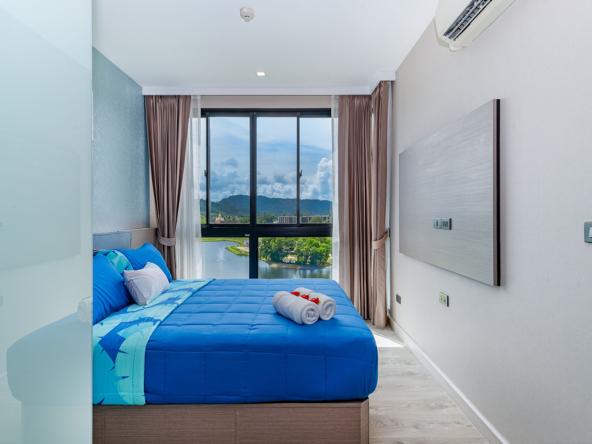
1 Bedroom Condo for Sale in Prime Location in Phuket From ฿3,707,488
Are you ready to talk to an expert.
Compare listings
Reset Password
Please enter your username or email address. You will receive a link to create a new password via email.
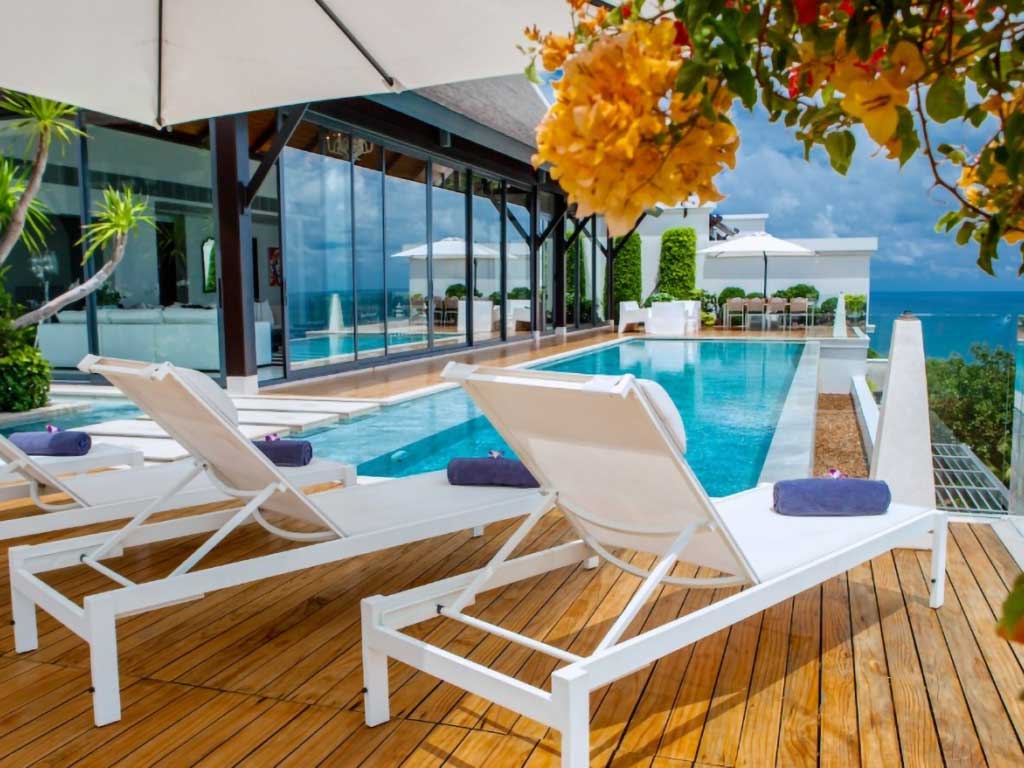
Get our latest properties and more straight to your inbox
Exploring Phuket Town: the Thai holiday island’s cultural capital

Jan 17, 2019 • 6 min read
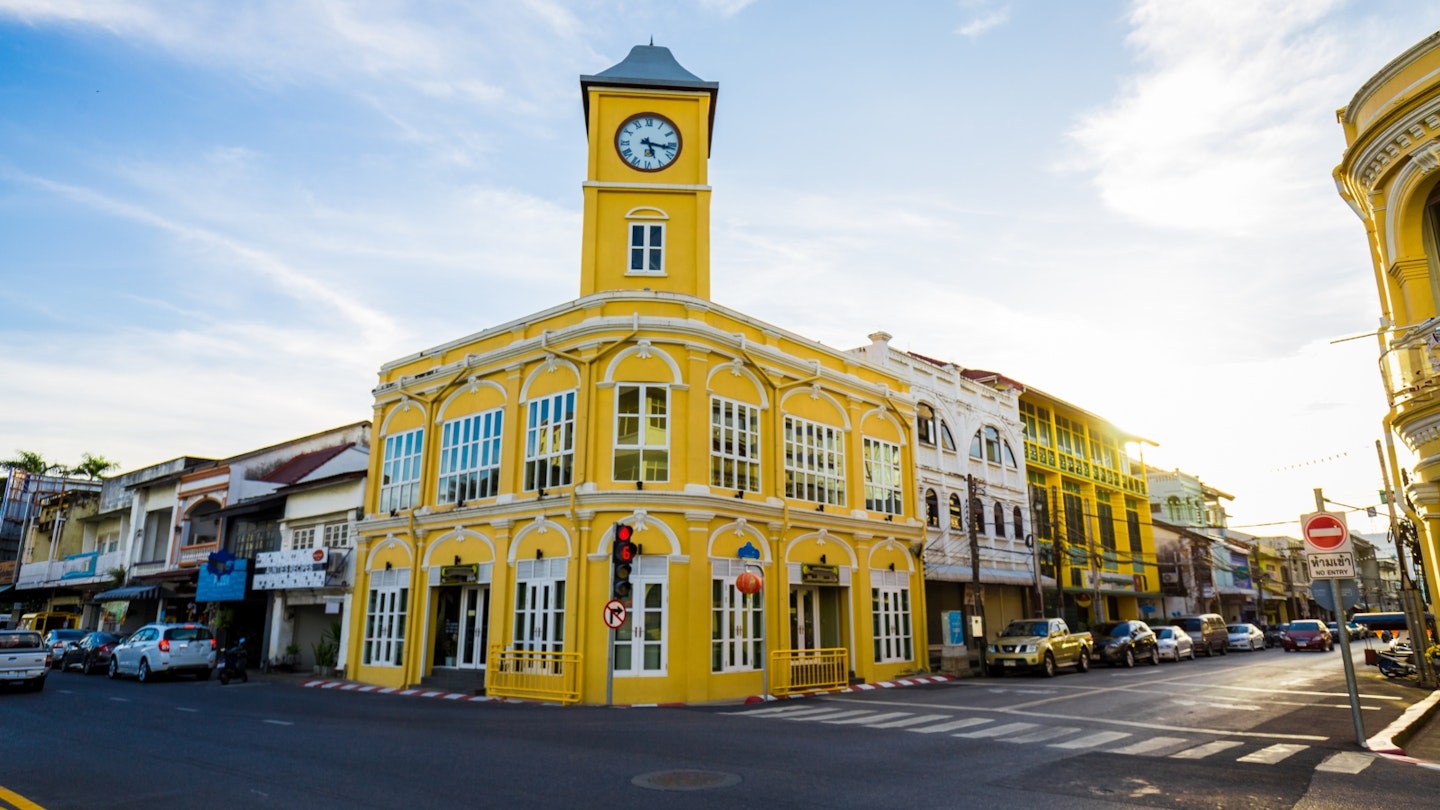
Explore Phuket’s diverse history displayed in its architecture, cuisine and more © Ruslan Kalnitsky / Shutterstock
Thanks to its strategic southern Thailand location and rich natural bounty, Phuket ’s backstory is a fascinating, multifaceted one. Europeans (Dutch, Portuguese, French and British) began to land on the Andaman Coast’s largest island from the 16 th century, but the greatest group of international arrivals were the Chinese, who flocked here to stake their fortunes on the 19 th -century tin-mining boom.
These workers married into Phuket ’s Siamese community, and the local Baba (Peranakan) culture was born. This distinctive cultural heritage is visible all over Phuket Town , from its architecture to its cuisine. Ditch the beach towel: Phuket Town whizzes you right back to the island’s roots.

Much more than a day trip
Plenty of travellers blitz through Phuket Town on a half-day visit, but stay a couple of nights and you’ll get to sample its busy nightlife (this is where Phuketians and local expats party), dig into its deliciously varied culinary world (Thai-style dim sum for breakfast?), explore its vibrant art scene (street art on every other corner), suss out an ever-growing number of excellent artisan cafes and experimental cocktail bars, and snooze in century-old hôrng tăa·ou (shophouses) transformed into boutique guesthouses.
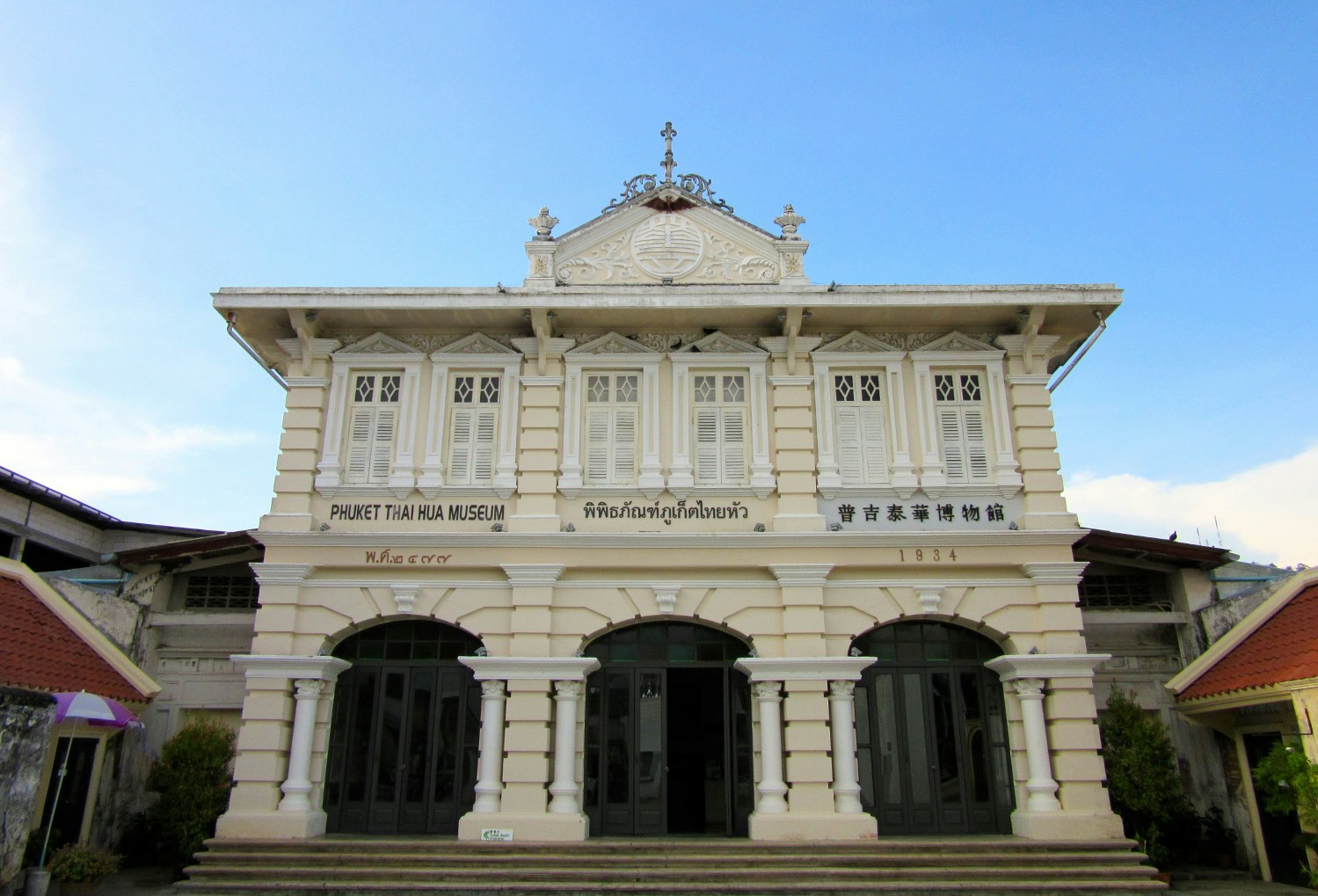
Sino-Portuguese architecture
Phuket Town's Baba inhabitants made their riches in tin-mining, then turned their attention to constructing majestic, European- and Chinese-inspired mansions featuring breezy terraces, elaborate wood-carved doors and central tile-floored courtyards. Others set up slim, multi-level shophouses, with louvered windows, upper terraces and elegantly arched ground-floor porches. Over the last decade, many of these buildings have been colourfully restored, some as cafes, restaurants, boutiques and guesthouses. A shining example is 1903 Chinpracha House off Th Krabi, still lived in by the six-generation descendants of its original owner.
A DIY walking tour of Phuket Town’s Sino-Portuguese highlights could begin at the mango-yellow Standard Chartered Bank , before meandering along vibrantly repainted Th Thalang and Soi Romanee , whose shophouses gleam with pastel-pink walls and stuccoed pillars under swaying Chinese paper lanterns. Check out the beautifully refurbished Phra Pitak Chinpracha Mansion (now the famed Blue Elephant Thai restaurant) and delve into local history at Phuket Thaihua Museum on Th Krabi.

Chinese shrines
Phuket’s cultural capital isn’t all tin-mining grandeur. Sprinkled amid the Sino-Portuguese storefronts are a number of serene Chinese temples still very much in use. One of the most enchanting is the elaborately carved, restored 1889 Shrine of the Serene Light , a Taoist shrine with intricate wall etchings, off Th Phang-Nga.
Visit in late September or October and you’ll see these hushed worship spaces burst into action for Phuket’s famously frenzied Vegetarian Festival . Expect thunderous firecrackers, vivid street parades, masses of vegetarian food, and skewer- and knife-pierced worshippers. This important local celebration invokes the nine emperor gods of Taoism through self-mutilating mediums (mostly men). Jui Tui Shrine and Bang Niew Shrine are major sites for festival activity.

Fabulous food
Phuket Town’s multicultural makeup means its cuisine is as diverse as it is celebrated. From super-fresh seafood to some of the best curries outside the Indian subcontinent, Phuket Town’s culinary creations, both traditional and inventive, are just as likely to be dished up on shophouse porches as inside early-20th-century mansions. Here, Chinese and Malay flavours mingle with southern-Thai cooking, producing a deliciously varied local microworld of Peranakan cuisine, with distinctive specialities seen only in this part of Thailand.
On Th Thalang, Kopitiam by Wilai is a great place to savour some soulful southern favourites; try the mee sua (sautéed noodles with egg, sea bass, prawns and squid). A few doors east, long-running Abdul’s Roti Shop doles out hotplate-fresh roti with sweet banana or savoury massaman curry, while Mee Ton Poe on the Clock Tower Circle is the place to go for hokkien noodles. At Cookie House , pick up boxes of Phuket’s signature cookies made from freshly pulverised almond paste, egg yolks and butter.
Long-established, antique-packed Sino-Portuguese townhouse Raya pulls in a loyal following for its well-priced Phuket specialties , such as mŏo hong (pepper-and-garlic-braised pork), mèe gaang pôo (crab-meat curry with noodles) and pàk miang (scrambled kale-like leaves). Just around the corner, sister restaurant One Chun works up a similarly enticing Phuketian menu. For Phuket favourites in a stylish setting, head to Tantitium or Tu Kab Khao , both inhabiting restored Sino-Portuguese buildings.
At the gourmet end of Phuket Town’s dining spectrum, Suay surprises with chef Noi Tammasak’s fantastic fusion fare – lemongrass lamb chops, braised-beef-cheek massaman curry, sweet-basil Shanghai noodles, and mango sticky rice with black-sesame ice cream.
For an in-depth culinary adventure with local Phuketian guides, track down Phuket Food Tours .
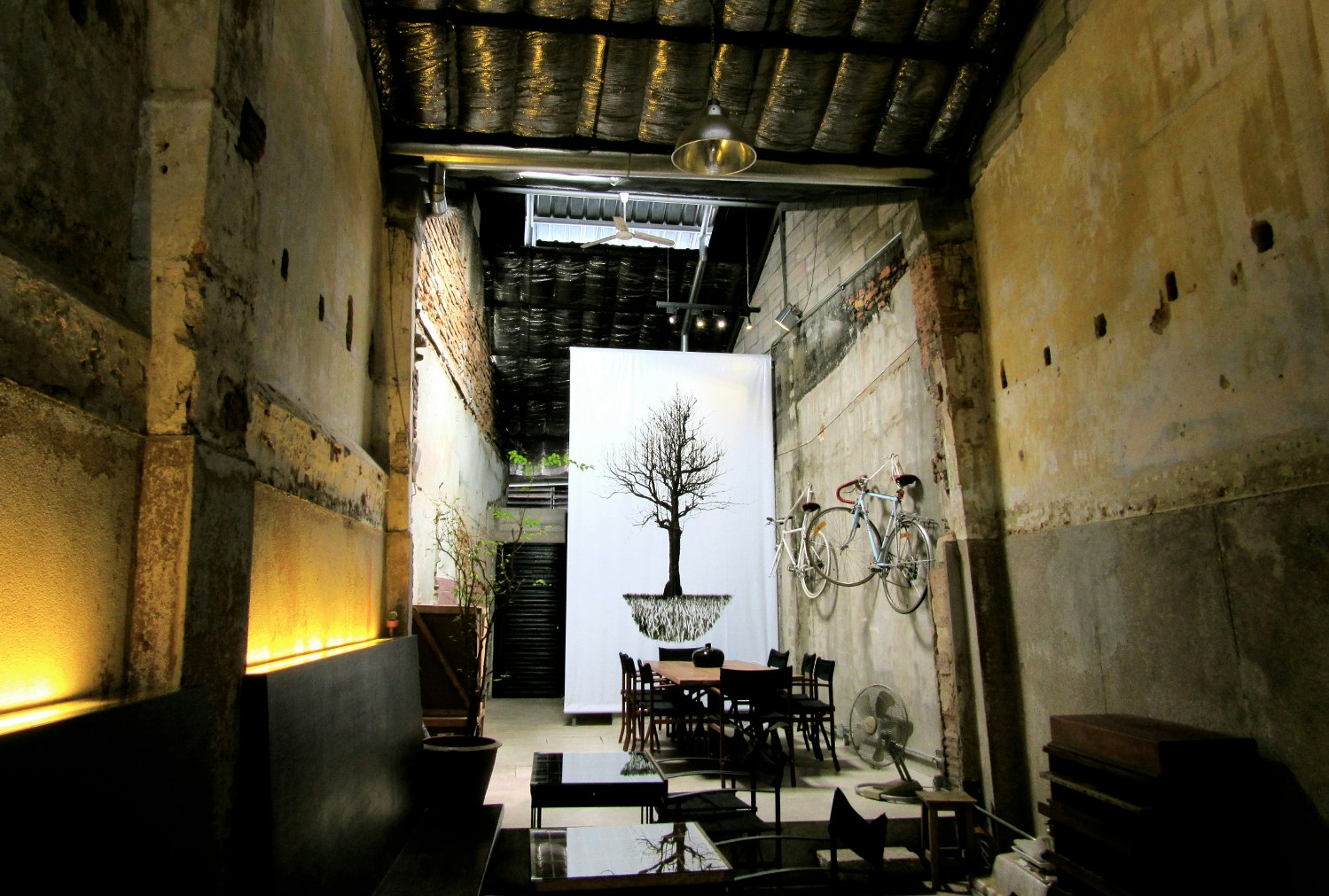
Crafted Coffee and Cocktails
Phuket Town’s coffee and cocktail scenes have exploded in the last few years, with Thai beans and local herbs fuelling menus and ambitious Phuketian baristas and mixologists taking charge.
There are plenty of urban-chic spots to get your caffeine fix in style, whether it’s an Aeropress latte, a nitro cold brew or a single-origin espresso. With exposed brick décor, wall mounted bicycles and a novel doubling as a door handle, Th Thalang’s cafe-gallery Bo(ok)hemian is the perfect example of Phuket Town’s creative buzz. Neighbour DouBrew , overlooking Soi Romanee, lures caffeine fiends for its inventive coffee and beautiful setting in the lobby of a renovated Sino-Portuguese home. On Th Dibuk, prize-winning Shelter Coffee is a popular yet laid-back hangout for artful brunchy bites and forward-thinking coffees, with a sweet back garden.
From beans to spirits, the Old Town’s artisan cocktail offerings have also sprung into the island spotlight. Moody Dibuk House , set inside a historical building, is the star of the show, with highly experimental liquid creations involving house-mixed gins. You’ll find more crafted cocktail sensations at Tantitium and Club No 43 , both a few minutes’ walk away.
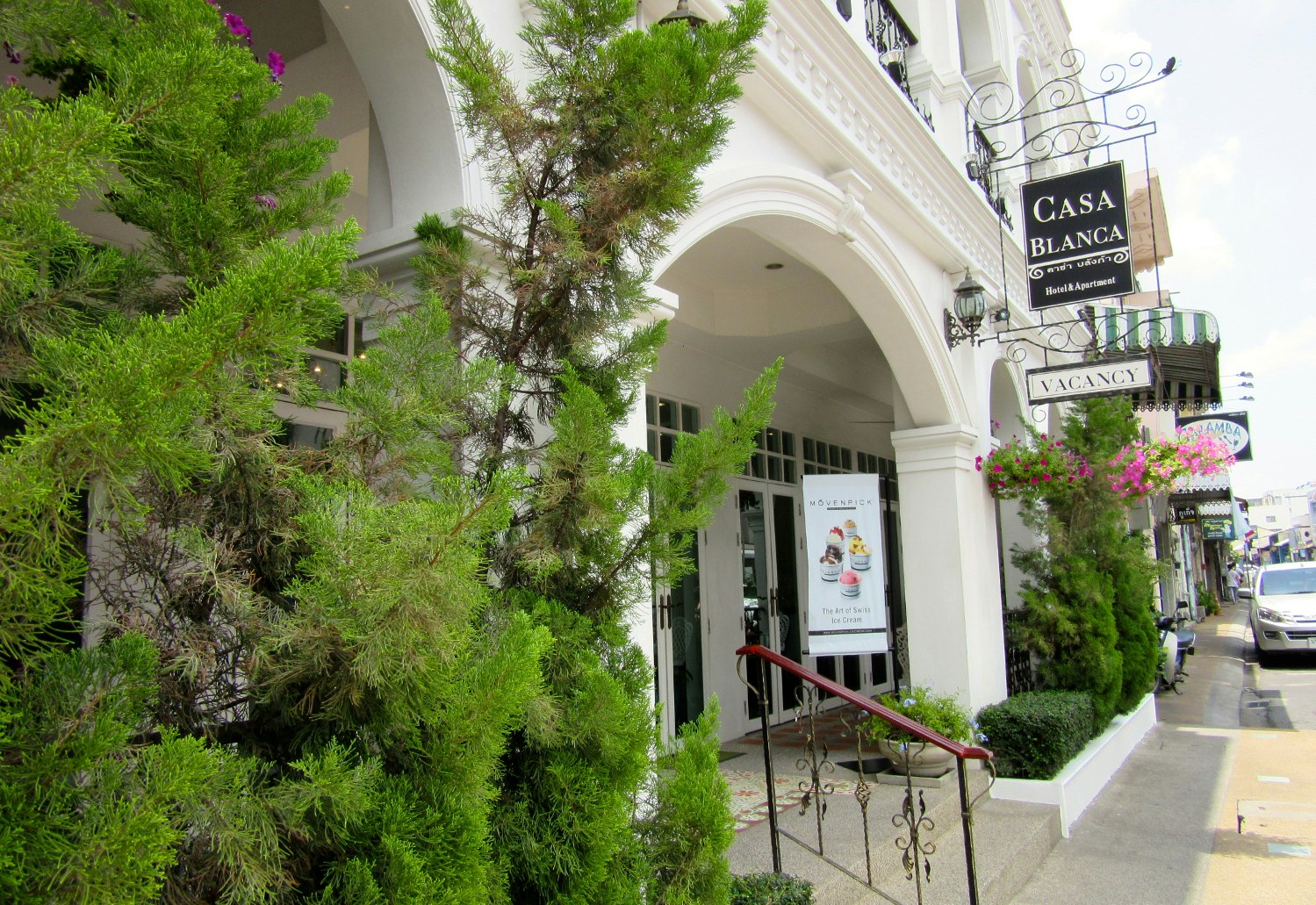
Boutique sleeps
Phuket Town has excellent-value lodgings, many of which are tucked into refurbished century-old buildings oozing historical charm. Cheap sleeps abound in characterful, contemporary hostel dorms, such as at Ai Phuket Hostel .
If you're on a flashpacker budget, bag one of four arty, polished-concrete rooms at boutique-chic The RomManee , which unravels behind a bright turquoise façade on Soi Romanee above DouBrew coffee shop. An exquisite upper-midrange choice is white-on-white boutique hotel Casa Blanca Boutique Hotel , complete with private pool, Spanish-inspired flourishes and Sino-Portuguese history.
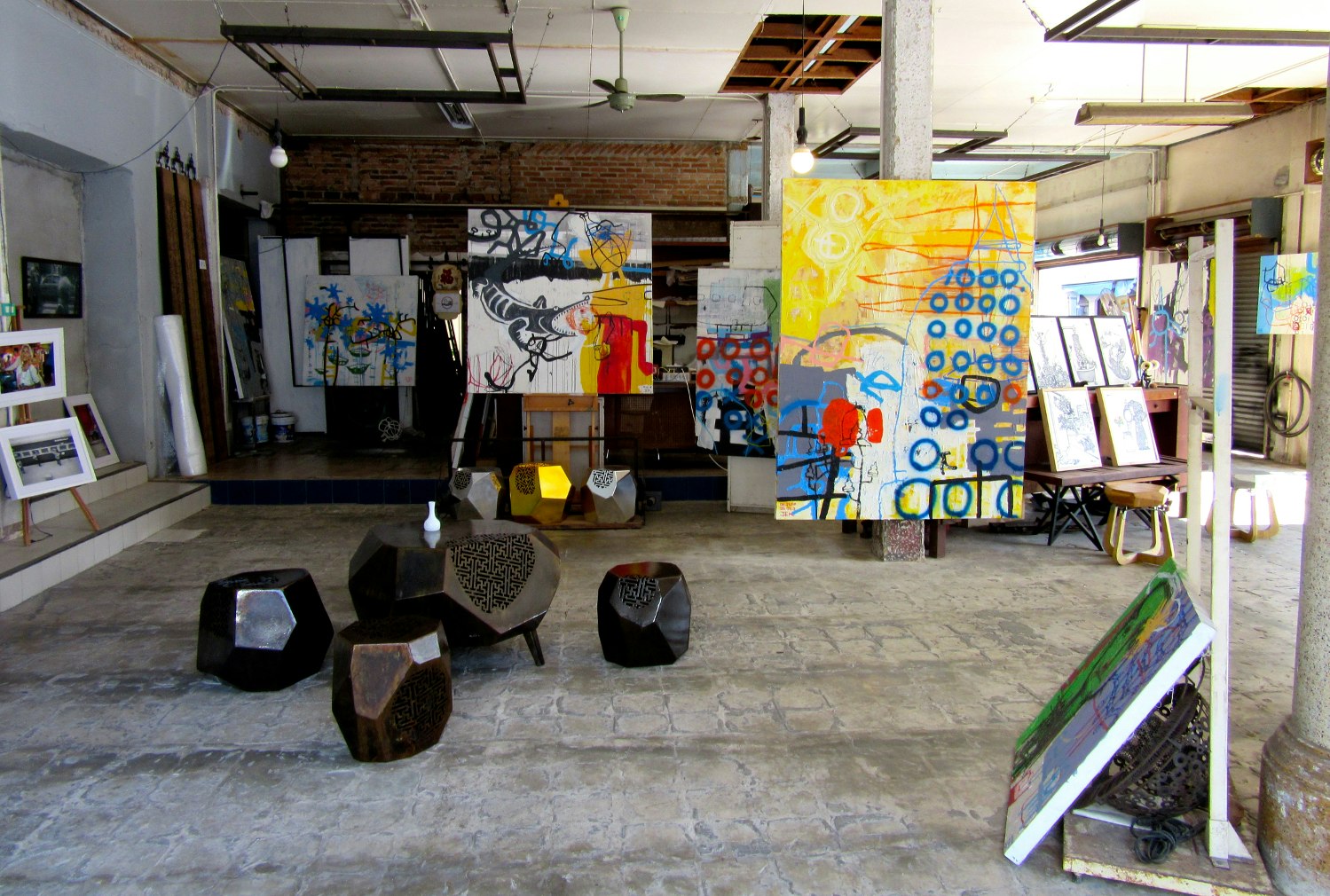
Art and fashion
Many of Phuket Town's historical shophouses house an eclectic bunch of boutiques and local artist-owned studio-galleries. Squeeze past antiquated stone Buddhas to find Thai-vintage-inspired women’s couture at Ranida , or sift through rainbows of fabrics at Ban Boran Textiles . With kaleidoscopic canvases, metallic furniture and soft-booming background bass, street-art-inspired Drawing Room is easily Phuket Town’s most original gallery.
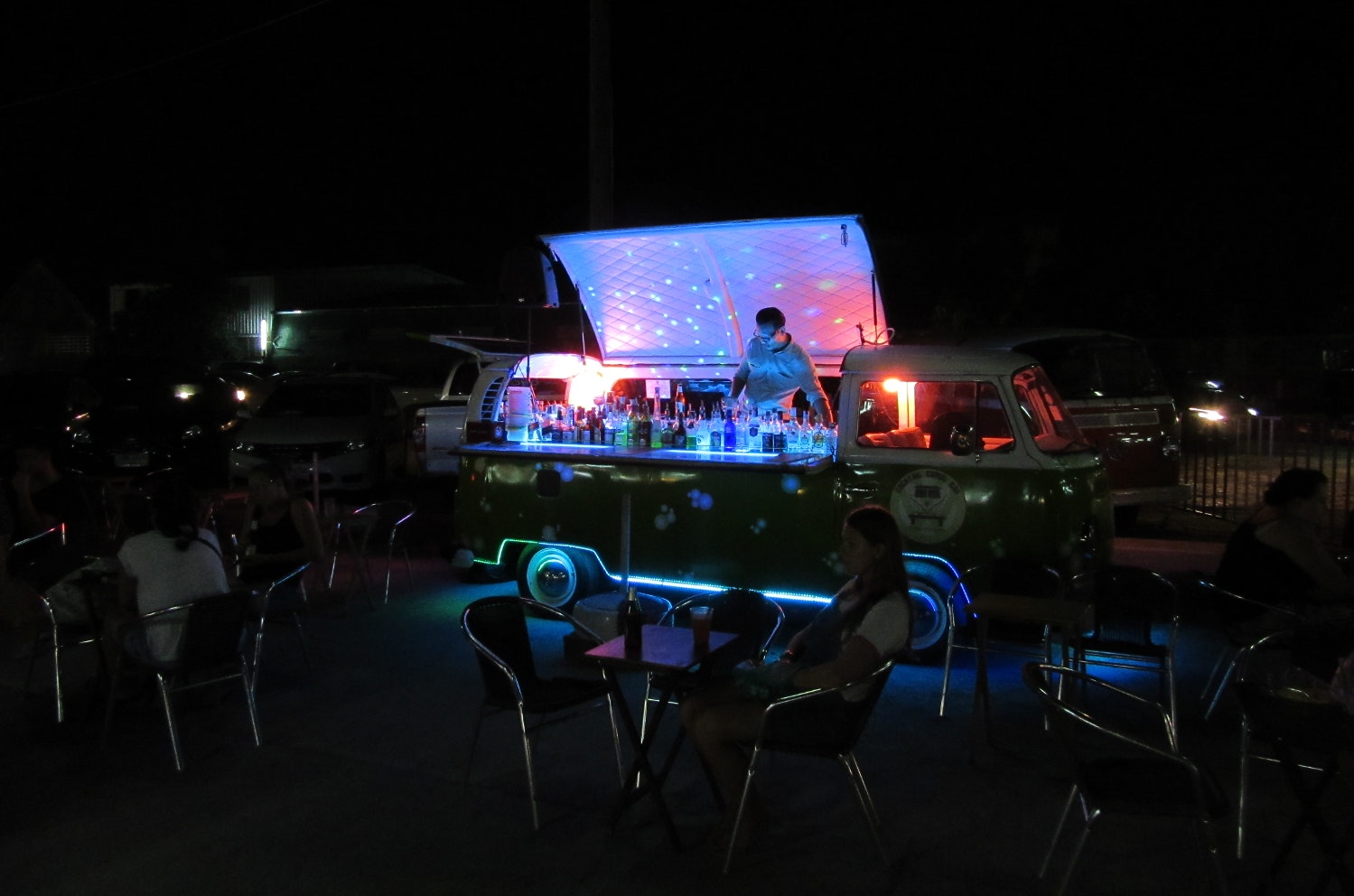
Market mania
There’s nothing like plunging into the depths of a local market to find Phuket’s pulse.
Phuket Town’s jam-packed Weekend Market , 3km southwest of town, is reminiscent of Bangkok’s legendary Chatuchak Weekend Market (but not as massive). On Sunday afternoon, an evening shopaganza unfolds at Th Thalang’s Walking St (from 4pm).
Make sure you're ready for anything with travel insurance from our trusted partners.
First published in September 2016.
Explore related stories
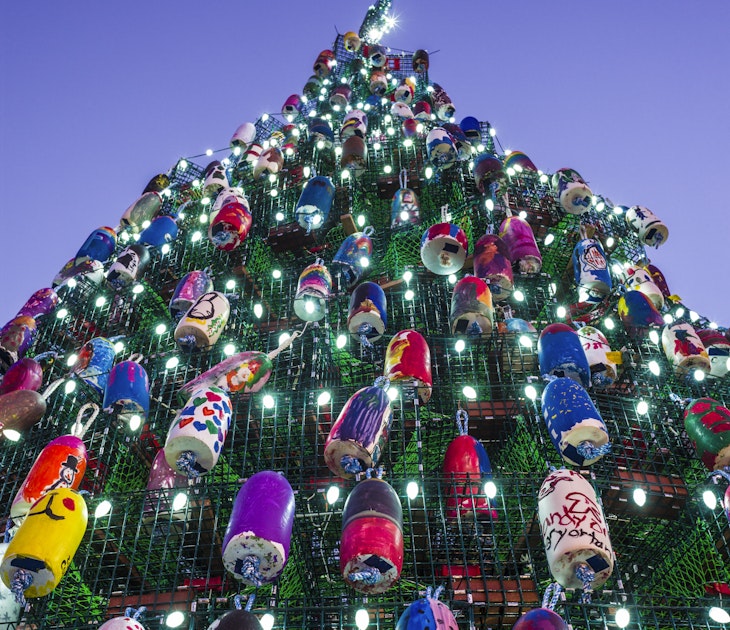
Dec 1, 2016 • 6 min read
Here at Lonely Planet we don’t like to trade our passports for mince pies when it comes to the Christmas season. Once all the gifts are bought and wrapped…
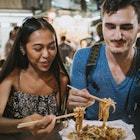
Feb 23, 2024 • 7 min read

Jan 3, 2024 • 5 min read

Dec 21, 2023 • 9 min read
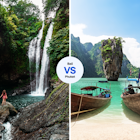
Apr 6, 2023 • 8 min read
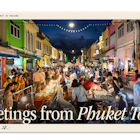
Dec 16, 2022 • 4 min read
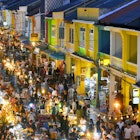
Dec 31, 2021 • 5 min read
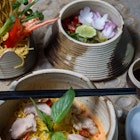
Dec 1, 2014 • 4 min read

Apr 29, 2011 • 5 min read
Sep 6, 2010 • 4 min read
History & Culture in Phuket
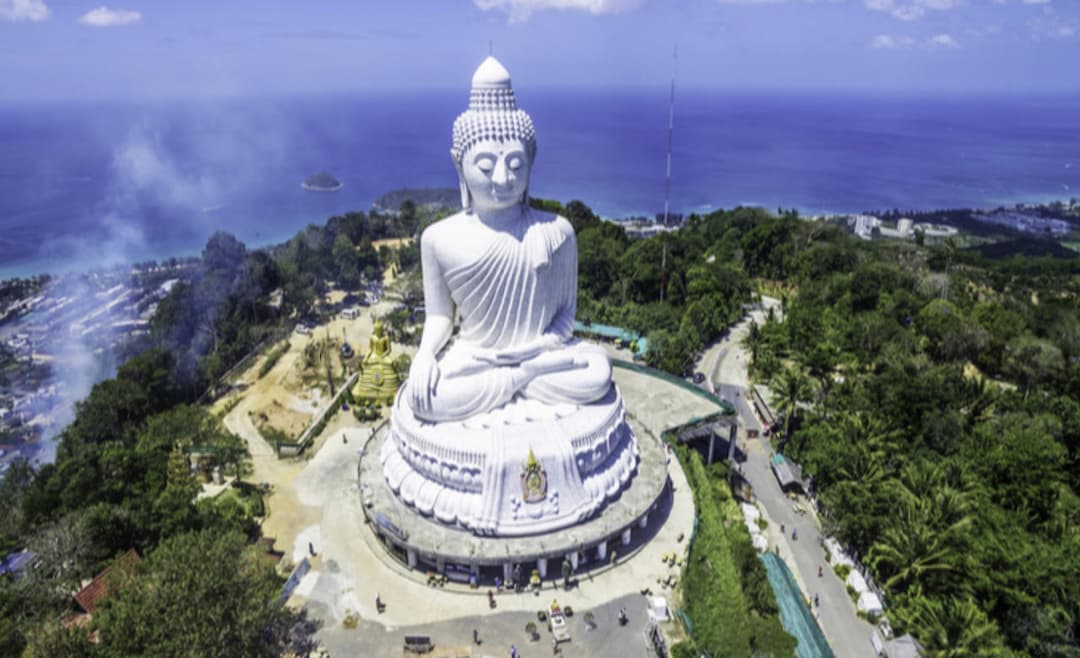
Happy Travellers
31st jan southeast asia tour.
Mr. Yayati Patel
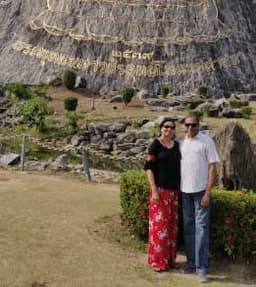
Singapore Malaysia Tour-21st Dec to 31st Dec
Mr. Chetan Gandhi

Hotel Food And Staff Services Was Very Nice
Mr. Shambahadur Thakur
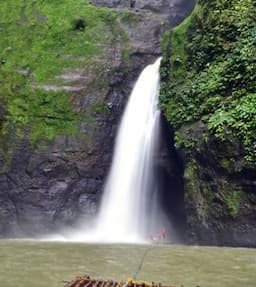
We Love Partnering With You On Our Travels!
Priyanka Desai
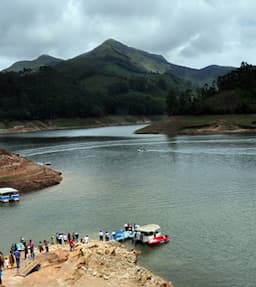
We Have Enjoyed Our Dubai Trip!
Mr. Rahul Bhasin

We Couldn’t Dream Of A Better Vacation Than This!
Mr. Neeraj Amin
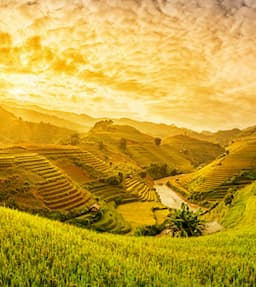
Thanks Flamingo Team To Make Our Dream Come True
Mr. & Mrs. Nehal Gandhi
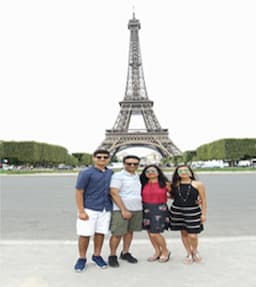
Thanks For A Memorable Trip To China!
Mr. Nirav Parikh

Appreciate Flamingo's Services And Travel Again!
Mr. Husein Sama
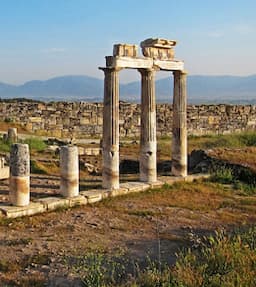
Thanks a Lot for Making Wonderful Trip!!
Mr. Chetan Talati
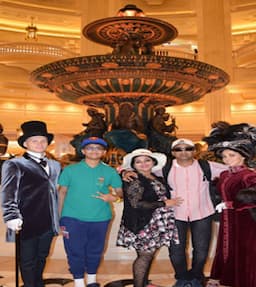
Trending travel articles

A New Wonder of the World: The Golden Bridge in Vietnam
An overnight internet sensation and thanks to Instagram - the Golden Bridge in Vietnam is at the top of the travel bucket list for many tourists. Since its opening day - it has topped the global architectural charts. Over the past few years, uniq
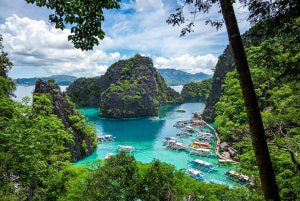
Top Maldives Alternatives to Explore Summer Vacation
Post-a-pandemic - thanks to the Bollywood celebrities - the Maldives has been in the travel spotlight. Yes, the Maldives is a surreal place to be - yes, it is the best short-distance foreign country to visit; yes, the Maldives travel experience
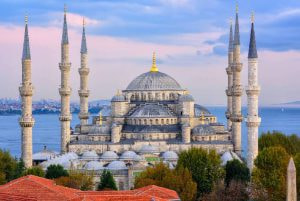

Explore the Majesty of the Blue Mosque in Istanbul
The iconic and famous mosque in Istanbul, the Turks call – the Sultan Ahmet Mosque, is known globally as the Blue Mosque. The Blue Mosque in Istanbul received this unofficial name based on the blue tiles that adorn this structure. The blue mosq
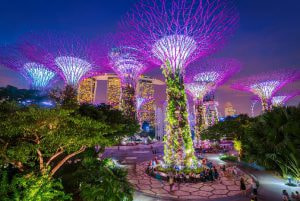
Find Out Everything You Need To Know About Gardens By The Bay In Singapore!
One of the most renowned and not to be missed features of Singapore tour Packages is to visit the Gardens by the Bay in Singapore. This garden is an integral part of Singapore Tourism. Your tour of Singapore is incomplete if you do not go to see the
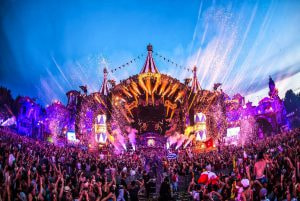
7 Festivals That Celebrate Life in Europe!
For most of us, Europe is synonymous with our summer holidays. Europe conjures images of snow-clad mountains, lush greenery, famous historical sites, and beautiful landscapes. There are infinite options for all – young and old, honeymooners and
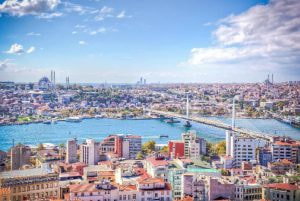
Grand Bazaar In Istanbul: All You Need To Know Before Visiting!
Turkey tourism is renowned for its mystical charm, stunning architecture, and rich culture, but your visit to this country will not be a full circle unless you visit the Grand Bazaar in Istanbul. The must-visit spot for any tourist while visiting Ist
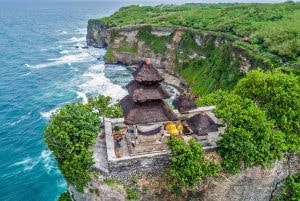
Uluwatu Temple Bali – A Guide to Visiting Bali’s Magnificent Sea Temple
Bali is renowned for its beaches, a destination apt for short breaks and honeymoons - but this island of Bali is also famous for its temples. We all know that Uluwatu Temple is one of the most famous temples in Bali. Instead, we could say that Bali
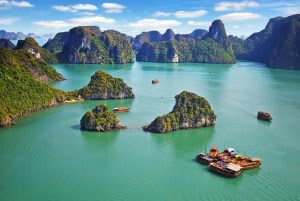
8 Famous Vietnamese Foods to Try On Your Trip!
What’s the purpose of visiting a new country if you don’t experience the local cuisine? The best approach to exploring the nation is to try the local cuisine. The cultural influences of that location are reflected in the food. Likewise to
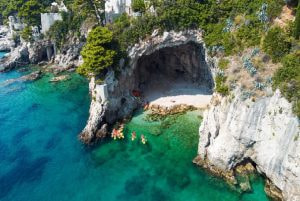
5 Best Beach Destinations in Europe: Beach Lovers, this one’s for you!
In Europe, you will find some of the most gorgeous cities on the planet. Millions of tourists visit Europe each year to discover its capital cities, like Paris, Barcelona, Berlin, Amsterdam, and Vienna, to mention a few. Europe Tourism is gifted with
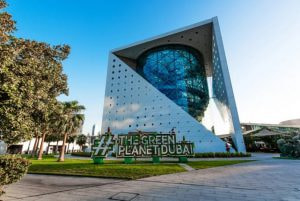
The Green Planet in Dubai – An Indoor Rainforest on the Arabian Desert
Dubai - you would have thought about uber-luxury, desert safari, very high temperatures, endless fun, and shopping. But, can you imagine a tropical rainforest in Dubai? On second thoughts - if Dubai can have a Miracle Garden, Ski World in the des
Find a branch near you :
201/202, Gala Business Centre, St. Xaviers College Corner, Off C. G. Road, Ahmedabad 380 009, Gujarat, India. | Monday to Saturday | Time : 10:30 AM to 07:00 PM Ahmedabad 380009 Gujarat India
Top Destination
- India Travel Guide
- World Travel Guide
- Video Gallery
- Testimonials
- Partner with Us
- Advertise with Us
- Retrieve Booking
- Payment Procedure
- Privacy Policy
- Terms And Condition
- Terms of Use

Phuket Tourism History
- Elephant Jungle Sanctuary
- Phuket Night Market
- Wat Phra Thong Temple
- AMaze Garden
- Wat Chalong Temple
- Phuket FantaSea
- Phuket Bird Park
- Tiger Kingdom
- Phang Nga Bay
- View all 18 places
- Things to do
- Best time to visit
- How to Reach
- Tourist Map
Phuket, Thailand: A Journey Through Tourism History
Phuket, Thailand's largest island, has long been a melting pot of vibrant cultures, dramatic landscapes, and a beacon for travelers seeking paradise. The history of tourism in Phuket is as colorful as its sunset-drenched beaches and as transformative as its mountainous jungles.
Early Beginnings
Historically, Phuket was an important trading post, with Europeans, Arabs, and Indians involved in tin mining and rubber production. However, tourism was not a significant factor in Phuket's economy until the 20th century.
The Birth of Phuket's Tourism Industry
It wasn't until the 1970s that tourism began to take hold in Phuket. Glimpses of its picturesque beaches started appearing in Western media, and soon, backpackers on the Southeast Asia trail began to trickle in, drawn by the island's natural beauty and laid-back atmosphere.
Phuket's Rise to Prominence
By the 1980s, Phuket had become a popular destination for sun-seekers from around the world. The growth of the tourism industry saw rapid development on the island, with resorts, hotels, and other tourist facilities sprouting up to cater to the increasing influx of international visitors.
The 21st Century and Its Challenges
The turn of the century brought new developments in Phuket's tourism sector, with luxury hotels and more sophisticated infrastructure enhancing its appeal. However, the island's idyllic image faced a daunting test with the 2004 Indian Ocean tsunami. Despite this tragedy, Phuket's resilient spirit and community saw rapid rehabilitation and reconstruction, restoring confidence among tourists.
Latest Tourism Trends in Phuket
In recent years, Phuket has embraced ecotourism and sustainable travel practices in response to the growing environmental concerns among travelers. The trend towards experiential travel has also grown, with tourists seeking authentic local experiences, from Thai cooking classes to community-based tourism.
The island has also seen the rise of digital nomadism, with more visitors looking to balance work and leisure in Phuket's serene setting. This shift has further diversified Phuket's tourism offerings, including co-working spaces and long-term accommodation options.
Health and wellness tourism has become another key trend. With its rejuvenating spas, yoga retreats, and detox centers, Phuket is positioning itself as a sanctuary for those looking to unwind and recharge.
Despite facing challenges like overtourism and environmental pressures, Phuket continues to evolve and innovate to meet the changing needs of global travelers, ensuring its place as a premier travel destination in Southeast Asia.
The Future of Tourism in Phuket
Looking ahead, Phuket aims to balance growth with sustainability, preserving its natural treasures and unique culture for future generations. With continued investment in responsible tourism initiatives and community engagement, Phuket's tourism history is poised to add new, exciting chapters that prioritize both visitor experiences and environmental stewardship.

Other Suggested Reads for Phuket
- About Phuket Tourism
- Places To Visit in Phuket
- Things to do in Phuket
- How to Reach Phuket
- Best time to Visit in Phuket
- Food in Phuket
- FAQS about Phuket
- Phuket Tourist Map
- Thing To Do in Phuket
- Phuket Unique Tours
- Phuket Thai Cooking Class
- Phuket City Tour
- Islands Tour From Phuket
- Phi Phi Islands Day Tour
- James Bond Island Day Tour
- Phuket one day tours
- Catamaran Day Tour
- Phuket half day tours
- Similan Islands Day Tours
- Minibus Rental + Driver
- Islands Overnight
- Phuket Tour Without Hotel
- Phuket Tour with Hotel
- Adenture and safari tours
- Romantic & Honeymoon tours
- Nightlife entertainment
- Phuket Boat Charter
- Boat Ticket/Phuket /Krabi/Phi-Phi Island/Lanta Island
- Phuket Muslim Packages
- Helicopter Tours
- Airport Transfer Service
- Thing to do in Krabi
- Krabi One Day Tours
- Phi Phi Islands Overnight
- Krabi Sunset Cruise
- James Bond Island
- Krabi Adventure Tour
- Muslim Packages
- Krabi Tour Package without Hotel
- Krabi Tour Packages with Hotel
- Krabi private boat charter
- Day Tour from Lanta Island
- Thing to do in Bangkok
- Bangkok half day tour
- Evening Tour Bangkok
- Bangkok Full Day Tours
- Hua-Hin Full Day Tour
- Ayutthaya Full Day Tour
- Tour Packages From Bangkok
- Khao Yai From Bangkok Tour
- Bangkok Muslim Packages
- Thing to do in Chiang Mai
- Chiang Mai Tours
- Chiang Rai Tours
- Chiang Mai Muslim Package
- Things to do in Koh Samui
- Koh Samui Day Tours
- Koh Samui Without Hotel
- Koh Samui With Hotel
- Boat Ticket /Koh Samui/Koh Phangan/Koh Tao
- Thing To Do in Satun
- Koh Lepih 2 days 1 night
- Thing To Do in Ranong
- Day trip from Ranong
- Myanmar Island Tour From Ranong
- Phuket History
- Krabi History
View Cart Checkout
- No products in the cart.
Subtotal: ฿ 0.00
Early History Phuket
Located on trading routes between India and China, Phuket was subjected to foreign influences long before many other parts of Thailand. Ships would anchor in the safe harbours of Phuket and wait for the northeast monsoon winds which would allow them to proceed to India.
The interior jungle was inhabited by indigenous tribes until they were displaced in the 19th century by tin miners. The coastal areas were inhabited by Chao Leh, sea-gypsies who made their living through piracy and fishing for pearls. Although threatened by development, Chao Leh villages can still be found along the coast of Phuket and neighbouring islands.
Phuket first became part of a Thai state during the thirteenth century when Thai armies from Sukhothai wrestled control of the island from the Srivijaya Empire based in Sumatra.
Tin & Rubber
Phuket is first mentioned as a major source of tin in the sixteenth century when the island became an important source of revenue for the Thai kingdom at Ayutthaya , as well as an important trading post. It was also during this period that the first Europeans arrived on Phuket.
Due to Phuket’s abundant supply of tin and its importance as a trading port, the island’s economy continued to prosper. The British secured a tin mining concession and nearly claimed Phuket as part of the British Empire, opting instead for Penang due to its safer harbours. Phuket’s streets were lined with handsome buildings constructed in the Sino-Portuguese style by the tin-barons, many of which can still be seen in older quarters of the town.
At the end of the nineteenth century, the island’s interior still remained relatively untouched. Much of it was still covered in ancient rainforest . However, at the beginning of the twentieth century, large areas of the island were cleared to make way for rubber plantations , irreparably altering the landscape of the island.
Tourism began on the island in the 1970s with the first beach bungalows at Patong beach. During this time Phuket was a haven for backpackers . Phuket’s idyllic tropical beaches and clear warm waters attracted travellers from all over the world to the island. This was facilitated by the building of an airport in the mid-1970s.
Today, tourism is by far the island’s biggest industry with over 3 million tourists visiting the island annually, making Phuket one of the most popular travel destinations in South-East Asia.

Origin of the Name “Phuket”
The name Phuket is derived from the Malay word bukit, meaning hill. The island was previously named Junk Ceylon on European charts, a corruption of the Malay Tanjung Salang meaning Cape Salang. Later it became known as Thalang, after the name of the main town on the island. The island did not come to be known as Phuket until quite late in its history when the administrative centre was moved to a mining town in the centre of the island called Phuket.
The Battle of Thalang
The most celebrated moment in Phuket’s history is when the people of Phuket (then called Thalang), drove away Burmese invaders who were laying siege to the island.
In 1785, Phuket was attacked by the Burmese as part of a wider campaign to invade Thailand (then called Siam). The wife of the recently deceased governor, Lady Chan, along with her sister Lady Muk, rallied the people and broke the Burmese siege.
On hearing of these valiant deeds, the king bestowed honorific titles on these two heroines . Today, their statues can be seen atop a monument at the roundabout a few kilometres north of Phuket City.
To learn more about the history of Phuket a visit to the Thalang National Museum is highly recommended.
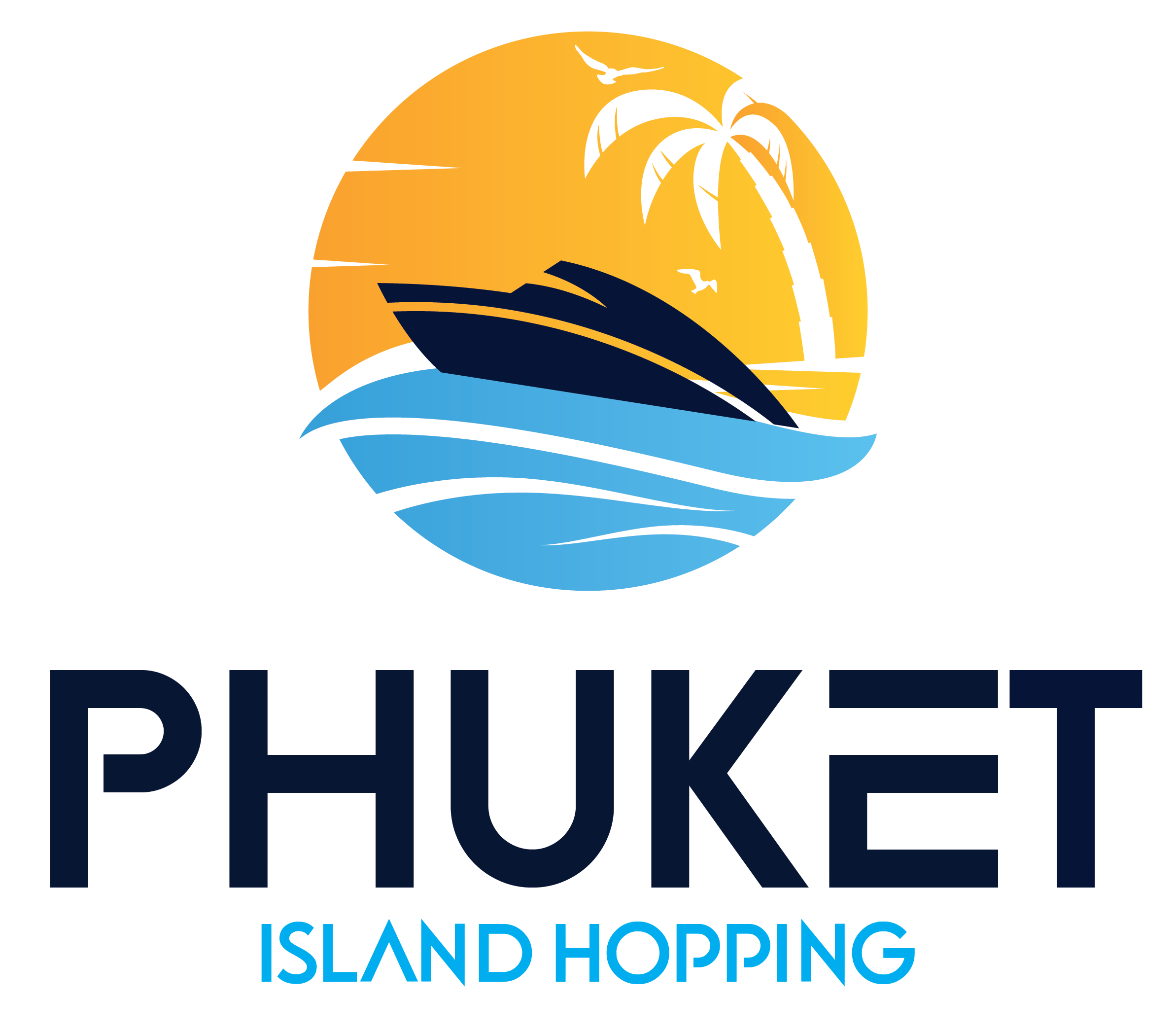
History of Phuket
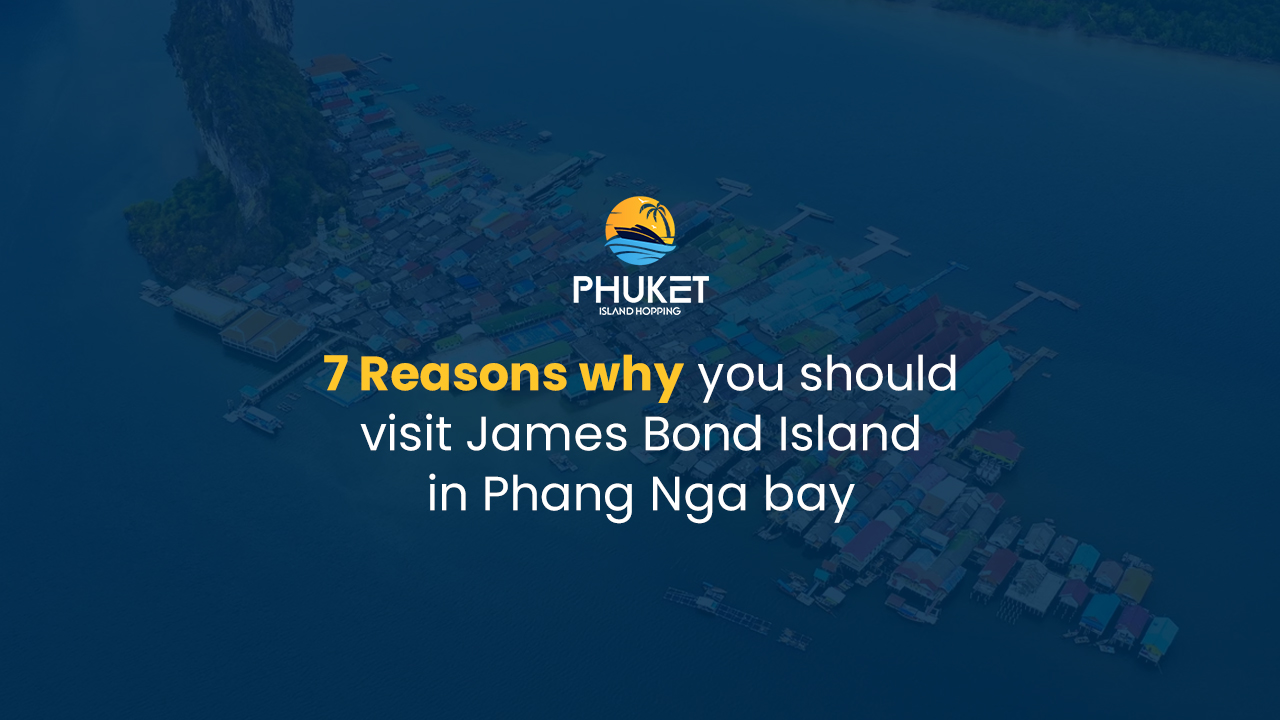
7 Reasons Why You Should Visit James Bond Island in Phang Nga bay
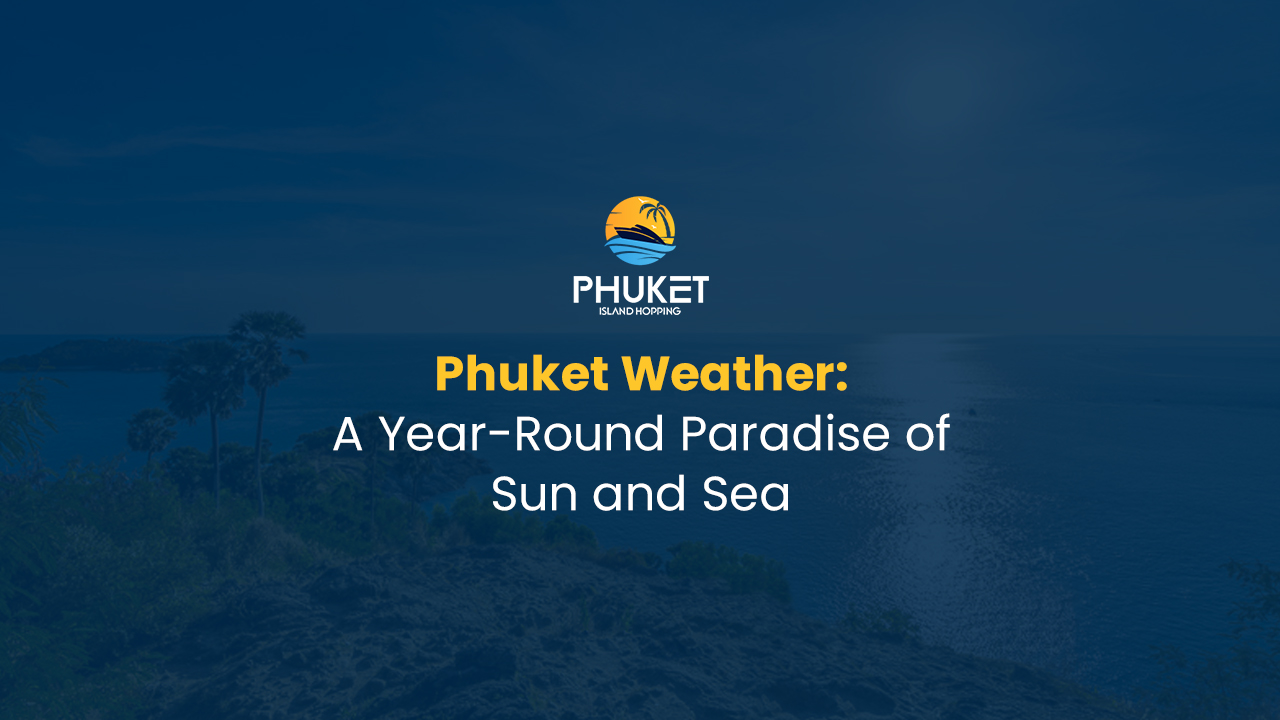
Phuket Weather
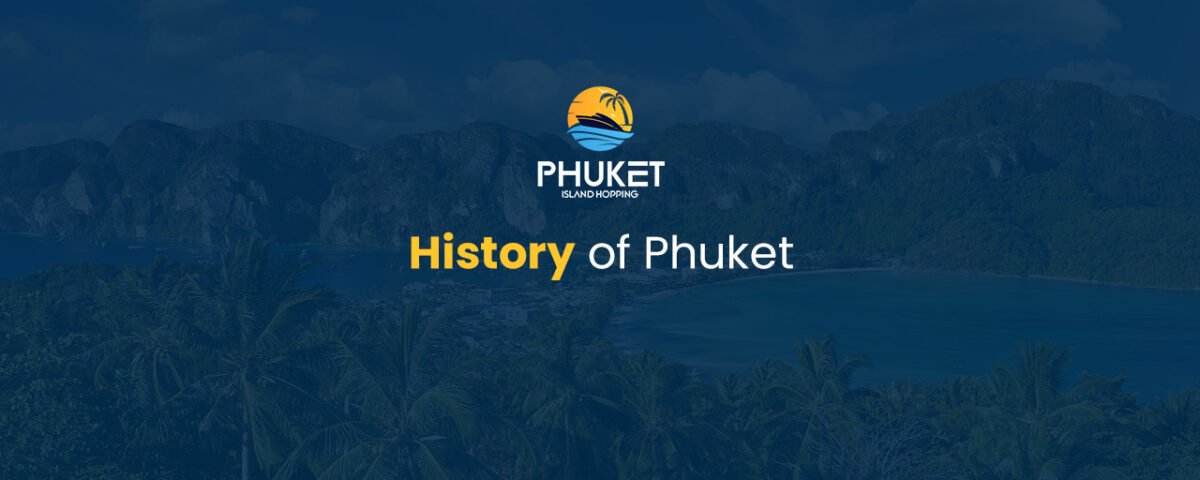
Welcome to the mystical island of Phuket, where history and paradise merge to create an enchanting destination in the heart of the Andaman Sea. With stunning beaches, vibrant culture, and a fascinating past, Phuket has captivated travelers for centuries. In this blog, we are on a journey back in time as we explore the rich history of Phuket and uncover the secrets of this alluring gem which is by far the most popular tourist destination in Southeast Asia.
Phuket's history can be traced back over a thousand years when it served as a vital stopover for maritime traders plying the ancient trade routes between India and China. Its strategic location and abundant resources made it a sought-after island by various empires and civilizations, including the Malay, Indian, and Siamese. The name "Phuket" is believed to have originated from the Malay word "Bukit," meaning hill or mountain, owing to the island's rugged terrain. Over the centuries, the island's inhabitants blended their cultures and traditions, resulting in the vibrant and diverse Phuket culture we know today.
The 19th century marked a significant turning point for Phuket with the discovery of tin deposits beneath its soil. This led to a tin mining boom, attracting a wave of Chinese immigrants to the island. The Chinese settlers brought with them their customs, religion, and architecture, shaping the island's unique heritage. Tin mining not only transformed Phuket's economy but also its landscape. The industry flourished for decades, leaving behind characteristic Chinese-style mansions, charming shrines, and townhouses, which continue to dot the island's towns and villages.
In 1785, Phuket's fate changed once again when it was incorporated into the Kingdom of Thailand (formerly Siam) during the reign of King Rama I. This integration into Thailand helped preserve the island's distinct identity while embracing the broader Thai cultural influence. The blend of Thai and Chinese traditions is evident in Phuket's architecture, religious festivals, and cuisine, creating a harmonious and colorful tapestry that attracts travelers from all corners of the globe. The early 20th century saw a decline in the tin mining industry, primarily due to the depletion of easily accessible tin reserves. The industry's decline resulted in economic hardships for the island, pushing many locals to seek livelihoods elsewhere. But, as one chapter closed, another opened with the emergence of rubber plantations.
While rubber played a crucial role in Phuket's economy, the true renaissance of the island came with the advent of tourism in the 1970s. Phuket's stunning beaches, crystal-clear waters, and tropical climate caught the attention of adventurous travelers looking to escape the crowds and explore the beauty of Southeast Asia. The Thai government invested in infrastructure, and Phuket's transformation into a world-class tourist destination began. Today, Phuket stands tall as one of the most popular destinations in the world, attracting millions of visitors each year. Phuket's history is a captivating tale of cultural fusion, economic metamorphosis, and resilience. From its early days as a stopover for ancient traders to the glitzy tropical paradise, it is today, Phuket's journey has been remarkable. With its vibrant culture, stunning natural beauty, and warm hospitality, Phuket continues to cast its spell on all who set foot on its shores. So, whether you seek a glimpse of its fascinating past or wish to immerse yourself in its breathtaking present, Phuket is ready to welcome you with open arms.

Shaun Stenning
Related posts.
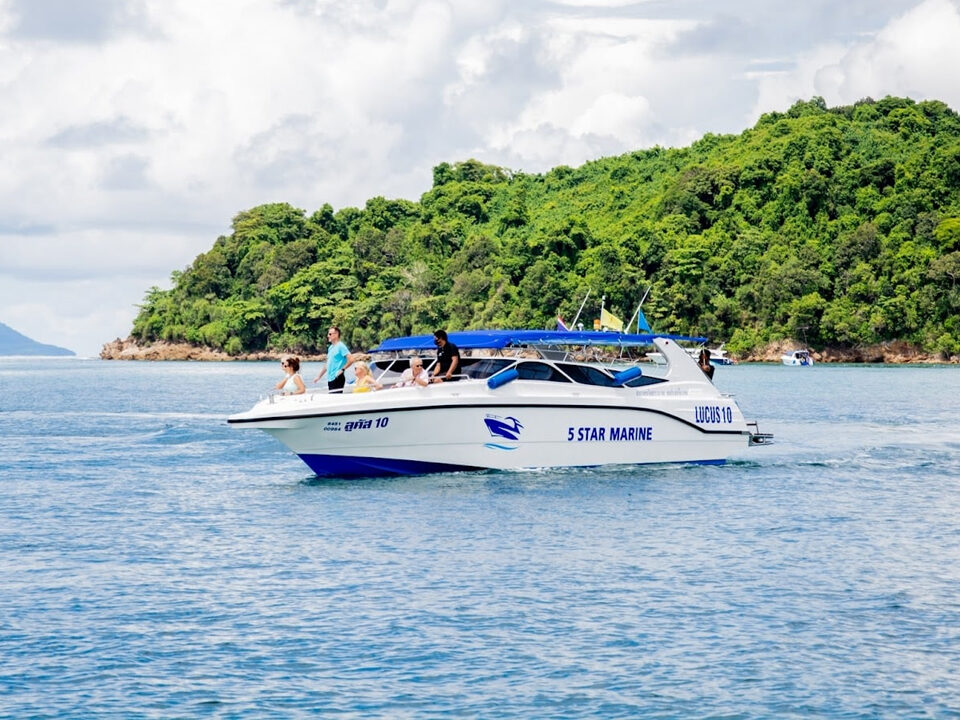
Exploring Phuket’s Hidden Gems with 5 Star Marine
WhatsApp us

My Thailand
A 25-year journey into Thailand

The Golden Era of Thailand Tourism: 1947-1979

The history of tourism in Thailand is a fascinating story about culture, technology and money. Exactly how did a poor country within a few decades go from a seldom visited backwater to one of the most visited countries in the world? Read on….
A Prelude: Maya Bay, Phi Phi Island
As I began my search through vintage photos, old airline schedules, and dusty old travel guides of Thailand in preparing this post, news came that the Thai government as of June 1st was temporarily shutting down Maya Bay on Ko Phi Phi Island. (The shutdown will now go on indefinitely.)
Maya Bay is the slice of paradise depicted in the 1980 movie Blue Lagoon starring Brooke Shields and Christopher Atkins.
Why? WAY too many tourists. The environmental degradation caused by mass tourism was killing the bay and its coral reefs. There had been rumors of a shut down of Ko Phi Phi for years and finally it happened. Thank God.

I was happy at the shutdown. Officials weren’t just going to do nothing as one of Thailand’s most precious gems-Ko Phi Phi-was trampled beyond repair in the name of mass tourism dollars.
But more cynically, the temporary shutdown is to preserve Maya Bay as a continuing revenue source for future tourist dollars.
This post will take you back to a time when Thailand was in its infancy of tourism. When the beaches of Phuket were truly deserted; The floating markets of Bangkok authentic; Before the sluttery of Pattaya; and a trip to upcountry Siam an adventure of a lifetime.
So hop into my Siamese time machine. We don’t have to travel back very far-not even a lifetime. And you might just better understand how you can still find “Old Siam” even in the era of mass tourism.
Thai Tourism: Facts First

In 2016, Thailand’s tourist revenue was a staggering $2.53 trillion baht ($78 Billion (US) which accounted for roughly 18% of Thai Gross Domestic Product (GDP). Most countries with a developed tourist industry average 9% of GDP from tourism.

In 2016, 32.5 million tourists visited The Kingdom. Compare that to 1967 when there were 336,000 tourists; or 1960 when there was just over 80,000.
In the 1950’s, between five and ten thousand tourists arrived (No records were kept back then). And prior to World War II, tourists numbered so few that annual stats could have been kept by chits at the Port of Bangkok.
Bangkok alone drew 21 million tourists in 2016-the most visited city in the world that year.
Last year, the top two most frequently photographed locations on Instagram were Suvarnabumi International Airport (Bangkok) and the Siam Paragon Shopping Mall in Bangkok. That pretty much says it all.

So what caused this massive explosion in tourism? The reasons are many:
- The Thai government realized in the 1920’s that their country could make a lot of money through tourism and they planned accordingly.
- The country and culture are perfect for tourism-beaches, exotic locales, food, etc.
- A skyrocketing Thai GDP that allowed the development of the needed infrastructure for mass tourism.
- Thailand is cheap for Western wallets.
- The Viet Nam War which brought hundreds of thousands of G.I.s and other foreigners to The Kingdom.
- James Bond’s The Man With A Golden Gun in 1974; Brooke Shields’s Blue Lagoon in 1980; The recent Chinese smash hit movie Lost in Thailand ; and of course the classic Bridge Over The River Kwai (1957); Miss Universe 1965-Apasra Hongsakula; The yearly Thai floats in the Pasadena Rose Parade; The 1960 world tour of the beautiful Queen Sirikit and dashing King Bhumipol Adulyadej; The world’s love affair with Thai food….
You could go on and on and on.
But, without long distance air travel, Thailand could never have become the tourism godzilla that it is today.
The Real Start of Thai Tourism: June 17, 1947

On June 17th, 1947 Pan Am Airlines began Flight #1. A DC-4 took off from San Francisco Municipal Airport and flew east to Honolulu-Hong Kong- BANGKOK -Delhi-Beruit-Istanbul-Frankfurt-London-New York.
Pan Am was the first airline to offer worldwide “clipper” service, named after the speedy clipper sailing ships of the turn of the century.

A ticket wasn’t cheap. The full around-the-world fare was $2300 (US) for a single seat; a couple could fly for $4,000 (US). In today’s dollars that would be the equivalent of $22,000 and $38,000 respectively.
Pan Am also began Flight #2 which originated in New York and ended up in San Francisco going in the opposite direction. Pan Am allowed you to get off at any stop and stay as long as you wanted-you just had to complete your journey within six months.

There were other airlines that were flying into Bangkok around this time, but nothing beat the ease and elegance of Pan Am clippers. And no other airline had the advertising budget to market these far away, exotic destinations, especially Siam.

KLM (Dutch National Carrier) was flying Amsterdam to Bangkok and on to Jakarta in 1945. BOAC, a precursor to British Airways, had service from London to Sydney with a stop in Bangkok in 1946. And believe it or not, one of Thailand’s first airlines-Pacific Overseas Airline of Siam-had a very short lived service from Bangkok to Los Angeles.
But it was Pan Am’s world clipper service which caught the imagination of the world. Beginning in 1947, if you had the cash, Pan Am had the flight. Bangkok was now a legitimate travel choice for a tourist.
Tourism Before 1947

A steady trickle of Westerners had been travelling to Siam (Thailand was called Siam until 1932.) since the 1850’s. President Ulysees Grant came in 1877. Joseph Conrad, the famous British author, stayed in Bangkok in 1888. Sommersat Maughnam in 1923. Thailand had no shortage of celebrities visit their far-off Kingdom prior to World War II.
There was a hodge podge of travelers to The Kingdom in the late 19th and early 20th centuries, but they were more adventurers than tourists. They all would have journeyed one to three months by ship to get here.
There was very little tourist infrastructure in Bangkok prior to World War II; Very few hotels or restaurants catered to Westerners. The world-wide depression of the 1930’s also retarded any tourism development that the government was trying to initiate.

The population of Bangkok at the turn of the century was about 400,000. There were very few roads. Travelling anywhere beyond the capitol was all but impossible unless you wore a pith helmet and commanded an expedition.

Almost all travel was done via water-canals through Bangkok (“The Venice of the East”), rivers and oceans. It wasn’t until 1920 that Bangkok was linked with Chiang Mai by rail.
But as mentioned before, the seeds of modern Thai tourism began in the 1920’s. In 1924, The State Railway of Thailand started the Tourism of Thailand (T.O.T.) bureau. This bureau was ahead of its time and clearly saw The Kingdom’s tourism potential. What little there was of tourism, they promoted.
Tourism After 1947

With convenient air travel came tourist infrastructure: hotels, restaurants, roads, upcountry airports, transportation services, etc.
Thailand’s expanding tourist infrastructure was a direct result of its expanding economy. If you lay a graph of Thai GDP over one of Thai tourism for the years 1947-1979, you’ll see an unmistakable correlation. The reason is simple: You can’t built infrastructure without money; and a country doesn’t have money unless it has a strong, growing economy.

In rapid development, Western quality hotels began to appear in Bangkok. The Oriental was no longer the only game in town.
In the 1950’s you could stay at tourist quality hostelries such as The Princess, The Erawan, The Royal, The Atlanta (still open today), The Trocadero, and later in the decade The Siam Intercontinental. Night clubs sprouted up-The Silver Palms in 1948; The Oriental’s Bamboo Bar in 1946; Bangkok’s Copa Cabana in 1957 and many others.

You could also travel outside of Bangkok. Pattaya now had tourist amenities and a decent road linked it to Bangkok. There was air service via Thai Airways to other parts of The Kingdom. You could travel to Ayutthaya without a pith helmet.
The 1950’s saw an estimated 10,000 tourists a year coming to Bangkok. And they were spending money, enough to make building hotels, opening restaurants, improving airports and roads a profitable endeavor.
Modern Thai tourism had taken root during the fifties and was off and running.
The 1960’s: The Jet Age Cometh

In 1960, 80,000 foreign tourist came to Thailand.
At the beginning of this decade, a fundamental technology change took place- jet aircraft -and Thailand was fully prepared to make the most of it. Airline tickets became cheaper and flight times shorter. Pan Am’s chunky propeller stratocruisers were retired for sleek, modern jets.
Getting to the far-off Kingdom got a lot easier on a jet.

But there was another crucial factor for Thai tourism that was happening. European, American, Australian economies were creating huge middle classes with enough disposible income and vacation time to afford a trip to a foreign destination. Again, Thailand stood ready to strike this jackpot of new tourist dollars.

Maybe the biggest cultural icon to come into existence in The Sixties was the tuk tuk. Samlors, a bicycled-styled rikshaw, had been banned from major Bangkok streets in the late 50’s. The samlors were clogging Bangkok’s growing traffic. In 1960 the first tuk tuks began to appear on Bangkok streets. A Thai cultural icon was born.
Thai Airways International

In the late 1940’s, Thailand had two airlines: Pacific Overseas Airline of Siam (POAS) and The Siamese Airways Co.
These two airlines competed with each other and therefore were not economically feasible. The Thai government took ownership of the two and made a single airline called Thai Airways Company (TAC) in 1951. But wait! This is not yet the airline we know today as THAI Airways International.
In 1960, the Thai goverment made a deal with Scandinavian Airlines (SAS) to start a joint airline called Thai Airways International. The Thai government owned 70% of this new airline and SAS owned 30%. This is essentially the THAI Airways we know today.

The joint venture was simple. SAS had all the operational, managerial, marketing and training skills needed to run a first class international airline successfully. Thailand didn’t. Thai officials knew this and so made another crucial and successful decision about the development of tourism.
The first revenue flight for the new Thai Airways was May 1st, 1960. By 1977, Thai airline officials had sufficient skills to operate the airline alone and so bought out SAS’s interest.
THAI Airways International became a key branding method for Thai tourism. Board a THAI flight anywhere in the world and you’re immediately greeted with a wai and a stewardess dressed in traditional Thai fashion. You’ve arrived in Thailand before you’ve even taken off.
The Viet Nam War

After World War II, Thailand became a strong ally of the United States and supported the Viet Nam war effort of the U.S. This had a profound and unseen effect on Thai tourism.
By the mid-60’s, approximately 40,000 U.S. troops were assigned to bases in Thailand. More importantly, the five-day R & R (rest and relaxation) given to U.S. soldiers fighting in Viet Nam was often conveniently spent in Thailand.

Hundreds of thousands of young G.I.s were coming to Thailand to get relief from the bloody fighting of Viet Nam. And blow off steam they did as only young men can.
They returned to the U.S. with tales of beautiful beaches, great food and nightlife from an exotic country that had given them a few days of comfort from war. Unfortunately, they also helped plant the seed of debauchery and the bar girl scene that would grow to a contagion in The Ninties and beyond.
Pattaya: A Casualty of Thai Tourism
Pattaya in the 1950’s was an almost completely undeveloped fishing village with a perfectly shaped crescent beach.
This isolated fishing village would become one of the first casualties of Thai tourism for two simples reasons: First, it was very close to Bangkok, only 150 kilometers south. Second, there was a decent road between Bangkok and Pattaya making it easy pickin’s.

Today Thai officials readily admit that mistakes were made with the development of Pattaya and they would do things differently if they only could. The current government has vowed to reign in the sex industry of Pattaya; but color me ever so cynical.
Onward & Upward: The Tourism Office of Thailand

The 60’s was a time of branding Thailand around the world. The old state railway bureau of Tourism of Thailand (T.O.T) was put under the office of the prime minister and its name changed to the Tourism Authority of Thailand (T.A.T.). It was given a healthy budget.
The T.A.T was and is the main branding machine of Thai tourism. They brought you the branding concept of the “Thai smile” with phenomenal results. Say what you want about the T.A.T. and mass tourism, but these people are very sophisticated marketers.
They opened an office in New York in 1965. They arrange for a Thailand float in the annual Pasadena Rose Parade. The World Expo in Montreal and the World’s Fair of New York (1964) featured a Thai pavilion. Miss Universe 1965 was Thai. The T.A.T. promoted Thai cuisine around the world as brand marketing.

The T.A.T had a winner and they ran with it. If Thai tourism were a craps game, these guys were rollin’ 7s. Thailand’s runaway tourism today is directly related to the marketing work of the T.A.T.
The Sixties began with about 80,000 tourist a year visiting Thailand. By decade’s end tourism had grown to almost a million annually. A 10-fold increase . Thai GDP increased from $2.7 Billion (US) to $7.1 Billion (US) over the same period.
Thai tourism was outpacing GDP growth and becoming more and more important to the Thai economy.
1970-1979: Solid Gold

Thai toursim in 1970 would stand at slightly under a million visitors and by 1982 climb to just over 2 million. The steep percentage climb of tourism in the 60’s was slowing, but in actual tourists and tourist dollars it rose during the 70’s.
The next explosive expansion of tourism would take place again starting in 1987 when Thailand changed its visa requirements and began issuing 30-day tourist visas on arrival. Tourists then would explode to 3.5 million annually and reach 10 million by the millenium’s end.
The 70’s is important to Thai tourism history. It was a decade of more infrastructure and further branding. More hotels were built; airports improved; interior transportation developed; and of course more and more Thai restaurants sprouted up all over the world as the The Kingdom’s leading brand ambassador.

The 70’s are maybe the best of the “Golden Age” of Thai Tourism. The beaches of Phuket remained deserted; Ko Phi Phi and Maya Bay undeveloped. The klongs (canals) of Bangkok were still picturesque and you could visit the National Palace without being trampled. While the sex industry had taken root, it wasn’t a dominating, obnoxious factor that it is today. Few visitors yet ventured out to the ruins of Phanon Rung, Phi Mai, Sukothai or even Ayuttaya. Chiang Mai was quaint.
A Thai vacation in the 70’s really was as carefree or adventurous as you wanted.
So why did the Golden Age end in 1979 A random year or a seismic event? In 1979, THAI Airways acquired its first fleet of 747 jumbo jets. The age of mass tourism had arrived.
A Personal Reflection

I first came to Thailand well after the “Golden Age of Tourism” had ended. And yes, I arrived on a 747 jumbo jet at Don Mueang International.
I did stay a couple times at the old Siam Intercontinental before it was torn down to make way for the Siam Paragon shopping complex. I would wander around it’s 40+ acre landscaped grounds that were smack in the middle of Bangkok. No one told me, but I knew the hotel was part of old Bangkok and its days numbered.
I’ve also stayed at the old Railway Hotel in Hua Hin (today it’s known as the Centara Grand Beach Resort ) built in the 1920’s and drank Bombay gin in its original Elephant Bar. Ambiance and good gin is everything.
I wrote this post from my wife’s family house out in the countryside of Lamphun Province. I only see tourists when I venture into Chiang Mai to buy wine.
My wife tells me stories of when she was a child growing up here in the 60’s. The road to Lamphun was unpaved and at most 3-5 vehicles might pass by in a day. A big enough event that would send her and her sisters scurrying out to the main road for a glimpse of just who had driven by.
Today the main road to Lamphun City is so busy that if you’re not careful before crossing you’ll get run over.
My wife also tells me the story of the family vacation to Pattaya in the mid-sixties. Her mom and dad packed everyone into the family truck (they were considered well-off by Thai standards) and drove from Lamphun to Pattaya. They ate seafood and slept on the beach. Just a few other Thai families there doing the same thing. The farang tourists hadn’t arrived yet.
I do know this for a fact. Thailand’s mass tourism is overwhelmingly self-restricted. Bangkok, the beach cities and Chiang Mai soak up almost all the tourists. There may be over 30 million tourists a year, but I rarely see any in Lamphun Province. Rarely in Lampang either. On my fabric safaris to Esaan I hardly see any.
Tourism is governed by the herd mentality. Thank god! So don’t let the staggering tourism stats scare you away from a visit to The Kingdom. There’s plenty of Old Siam to find if you care to look.
Share this:
22 responses to “the golden era of thailand tourism: 1947-1979”.
thanks pat my stuh innit bruv 😉
Hi Jeff: I was stationed at the American Embassy 1970-1972. My son had asked me to start writing a book and today I was writing about my time in Bangkok. I was offered an assignment between Kabul, Afghanistan or Ghana, Africia. Lucky for me, my assignment was changed to Bangkok. I loved Bangkok. What a place. I lived on Sukhumvit and Soi 3 across from I think it was the Prince Hotel. I lived in an apartment building with multiple folks from around the world. We stayed at the Grace Hotel on Soi 3 when we first got there. We had a two hour lunch so we would go out for lunch i.e. a place called the Three Sisters Bar, I don’t recall the area but there was also a very modern hotel next to it. You may have heard of the Thai Room, another place we’d go, but don’t remember the area. I remember there was a hotel on the Chao Phraya River that served a smorgasburg for $5. Never saw so much food from Prime Rib to Lobster, complete tables for each category of food. I knew about it but took a while before I actually checked it out. It’s a place one would want to go maybe once a month. I was a member of the All-Bangkok and All-Thailand fast pitch softball team. I was never into fashion and that kind of thing, but who couldn’t help but get into it when you could get everything tailor made. It think shirts were like two bucks. It was a time when the leisure suits for men were in, loved them. I was also a commissioner for American youth baseball and organized the Pine Wood Derby for scouts as well. We had our banquet for baseball at the Siam Intercontinental Hotel. It certainly was the most exclusive hotel I had ever seen. Had a great boss. Gave us a half a day off during the week, so, it was three days of golf. Each military Thai service had their own golf course the best of which was the Navy. Water hole on each one. There was also a railroad Club that we joined for 50 cents. Cadie’s for $2. Couldn’t go wrong there. It was truly a great experience.
Thanks for writing, Ross.
There’s still a Three Sisters Bar in Sukhumvit on Soi 3. Hmmmm…couldn’t be the same bar? I was lucky enough to stay at the old Intercontinental a couple times before it was torn down. The Intercontinental was the heart and soul of the Golden Age of Thai Tourism.
When you finish your book, let me know. I’d love to read it.
Hello, Thanks for the wonderful blog. I have a question re the “Never Miss Exotic Thailand” railroad poster. You mention it’s from the 1930’s. I’ve seen copies of that poster that appear to have the date of 1904. Is it possible that much earlier date aligns with Thailand’s tourism efforts? I’ve also seen the poster reissued in the 1960’s as well as new reproductions. I’d be interested in any additional information you might have about it.
Sa-wad-dee Robert,
Thanks for writing. Your question about the “Never Miss Exotic Thailand” poster just adds more mystery to this poster. I attributed it to the 1920’s or 1930’s because that’s when the Royal State Railway of Thailand began printing up for general circulation these types of posters. The artwork seems far older than their posters of the 1950’s and 60’s. (The poster right next to it on my post is commonly listed as being made in the 1920’s.) Therefore I attributed a 20’s or 30’s vintage.
I’m sure you know, at the bottom of the poster is the date ’64. Some collectors have therefore attributed the date of this poster to be 1964. Here’s one for sale for $2069 (US) that uses the 1964 date. At that price the seller must believe it’s the original.
But the “Never Miss Exotic Thailand” poster has the feel of the early posters from the 1920’s. Just because it has an annotation of ’64 at the bottom doesn’t necessarily mean that the poster was conceived then. It could be a reprint with some changes from an earlier edition.
Any info you have that may solve this question would be deeply appreciated. Yes, it is possible that this poster could be dated to the turn of the century. It’s one of my favorite Thailand travel posters.
-Jeff at mythailand.blog
Hi Jeff – your tourism post was very interesting to me. My experience with Thailand began in 1963-64 when I spent eight months in the (then) small village of Kuchinarai in Kalasin Province in the Issan region of NE Thailand. At the time I was a young U. S. Navy officer in charge of a group of Navy Seabees sent to teach modern construction methods to local Thai residents. We lived in a rented house in the village and made quite an impact on the local residents, most of whom had never seen a farang. This particular assignment was clearly one of the highlights of my 28-year Navy career.
In 2006, I returned to the area as a tourist with two of my adult children. What I found was truly mind-boggling. Clearly the modern world had found Kuchinarai, This became abundantly clear when I saw an ATM machine at a 7-11 convenience store on our drive into the village!
My son wrote a newspaper article about the visit, including my finding a couple folks from my long-ago time in Kuchinarai. I’ll attach that.
Sa-wad-dee Bob,
Sorry for the delay in responding as I just found your response. Thanks for writing!
I read your attached article, and I strongly recommend that everyone read it. Yes, Thailand has changed dramatically over the last couple of decades, let alone from the the early 60’s when you were there. But change can be a good thing. Those rural villages now have electricity, in-door plumbing and, as you mention in your article, paved roads.
I have never been to Kuchinarai, but I’ve been to Kalasin Province many times on my silk safaris. You might enjoy my blog post “ A Vagabond to Esaan ” where I write about my love for this part of Thailand. When I’m in Thailand, I live in the north which is where my wife was born and raised. But Esaan is special to me, especially the villagers.
Best of luck to you, -Jeff
A really fine article. I couldn’t stop reading it. Thank you for sharing the photos and what life was like in times gone bye. …if only we had access to a time machine to experience things first hand; yet your words are the next best thing! and are very much appreciated!
Great articles Jeff, I’m reading them a couple of years late. Imagine travelling months via boat to a far off exotic land – no way to research what it looked like before you got there – and no way back home if things went sour, sounds so exciting. Any chance of getting some of Pat’s ‘then and now’ images posted?
Hi Brett, Thanks for writing. You can upload photos to your comment, so if you have old photos of Thailand, I’d love to see them (or at least 1 or 2 to get a feel for the photos). Do you have a lot of old Thailand photos?
You may be interested in an essay on my own blog site as of today Feb 25 2021, which mentions your post. http://www.kendobson.asia/blog/tourism-is-unsustainable
Thanks for writing and providing a link to your article about Chiang Mai tourism. I read your article and recommend it. I think tourism will come back as soon as we defeat Covid.
Hey Jeff, I loved your article. I’m very interested in the topic of overtourism because I feel it’s happening across the world now. My country the Philippines is going through the same phase as Thailand. However in the Philippines there are still many hidden gems that are off the beaten path and still beautiful like going back in time. I know there’s a lot of places like that in Thailand, such as Koh Yao Yai and Chumphon among others. You should do more articles on the hidden gems of Thailand that not many tourists go
Hello Justin,
Thanks! That’s a great idea about writing about the hidden gems of Thailand. Thanks for the idea.
This is intended just as a message and not a comment on the above article.
I have plenty of old Bangkok photos from various sources and have taken new photos of the exact same locations, then put them side by side to create a ‘then & now’ series, which is still ongoing. I would love to show you a few examples as I think you’d like them. It’s just a hobby of mine.
Contact me at the email and I’ll happily send you an example. I’m sure you’ll like them.
PS. I am not selling them nor do I want renumeration if you want to post them. Like I say, it’s a hobby!
Hi Pat. Thanks for writing. Yes, I’d love to see the before and after photos. I’m also working on a story about The Mosquito Bar (long since closed) in Klong Toey. Hope to hear from you soon.
Excellent piece Jeff, not many articles like this online.
Thanks for the terrific history of Thai tourism. I love Thailand but I think it is certainly overrun with tourists. If people ask my advice I always tell them to visit Thailand but tack on Laos, Vietnam, Myanmar or Indonesia if possible.
Hi Jeff. Agreed. But keep in mind that most tourists go where other tourists go. So Bangkok, the southern beach towns, Chiang Mai, etc. are overrun with tourists, while the rest of the country is relatively tourist free.
Jeff hi I lived in Thailand in 1979-1980 and loved it. I am Canadian currently living in Markham Ontario. In January of 2018 I returned for 2 weeks with one of my daughters and it did not disappoint.
I love the information you have assembled here on Thai silk, pillows, culture, travel, etc etc. I too love Thai silk and cottons, and in the event that I should return, I am wondering do you know of any tours of the north-east to villages where silk is woven and the pillows are made?
Thanks Marguerite
Thanks for writing Marguerite. I’m not aware of any dedicated tours to the silk weaving villages of Esan. They’re very spread apart. I do see large tour buses at Ban Pohn (Praewa silk) and around Surin. Who the tour operators are I don’t know. (It could be private parties.) There are no tours (at this time) to the pillowmaking village near Yasoton. People do venture out to Yasoton, but in small groups via car.
I hope you and your family returns to Thailand and can see some of the rural silk and cotton weaving villages. My blog will definately give you the great destinations, but you may have to arrange for your own transportation. Best of luck.
Many thanks Jeff for getting back to me.
Leave a Reply Cancel reply
Your email address will not be published. Required fields are marked *
Attachment The maximum upload file size: 2 GB. You can upload: image , audio , video , document , spreadsheet , interactive , text , archive , code , other . Links to YouTube, Facebook, Twitter and other services inserted in the comment text will be automatically embedded. Drop file here
Best Time to Visit
Weather & Climate
Phuket International Airport Guide
Top Things to Do
Best Beaches
Best Dive Locations
Day Trips from Phuket
Food to Try
Best Restaurants
Nightlife Guide
Your Trip to Phuket: the Complete Guide
:max_bytes(150000):strip_icc():format(webp)/mike_borobudur-5b6d3ea446e0fb0025fcb683.jpg)
If you can only visit one place in Thailand, zero in on the island of Phuket. Set some 400 miles south of Bangkok, Phuket crams a near-excess of sights and activities within its coastline: gorgeous beaches, delicious food, amazing natural parks, and access to some of the Andaman Sea’s most breathtakingly beautiful islands.
Backpackers introduced Phuket to the tourism world. The first backpacker-friendly accommodations sprung up in Patong in the 1970s, presaging a steady rise in visitors that peaked at 14 million in 2018. Phuket’s present-day attractions have evolved with tourist tastes; beyond the beaches, visitors can now check out Phuket’s Michelin-starred restaurants, world-class theme parks, and luxury hotels fringing the sands.
For the first-time visitor to Phuket, the island can be a lot to unpack at first glance. Read on to make sense of Thailand’s most popular tourist destination, and how you can have the time of your life when you visit.
Planning Your Trip
- Best time to visit : Plan your trip between mid-October to mid-February; the “winter” months coincide with a cool, dry climate caused by northeast monsoon winds blowing in from Siberia.
- Language: Central (standard) Thai is widely spoken throughout Phuket, though southern Thai is the local mother tongue. A fair number of Phuket locals can manage basic English, but don’t expect them to manage sustained conversation. These are a few useful phrases to learn when traveling in Phuket.
- Currency : The Thai Baht (THB) is standard currency across the island.
- Getting Around: You can ride buses (songthaew), tuk-tuks, or motorbike taxis to get around Phuket. Songthaew commute between Phuket Town and resort areas like Surin, Karon, and Patong. Tuk-tuks and motorbikes can take you on a point-to-point basis for short distances.
- Travel tip: Phuket’s beaches are lovely to visit and swim in—but during the monsoon months between May and October, riptides and unpredictable swells make them positively dangerous for casual swimmers. Watch for red flags on the beaches, which warn against swimming when the conditions are too risky.
Things to Do
For an island just over 200 square miles in area, Phuket offers a surprising number of things to see and do. To be sure, its beaches are Phuket’s spotlight attraction, but there’s more to discover once you move beyond the coastline.
- Enjoy Phuket’s beaches . Each beach in Phuket offers a distinct appeal that caters to different folks—partygoers go to Patong Beach, couples to Karon, and nature lovers and plane-spotters prefer Mai Khao.
- Visit Phuket Town. In its heyday, Phuket Town was a key trading post for Thai, Chinese, and British colonial entrepreneurs. While the tin trade that drove local business has long since faded, the old town has retained its old-timey charm, its townhouses having been converted into museums, restaurants, and shops.
- Take in the nightlife. All nightlife adventures in Phuket begin at Bangla Road in Patong—a neon-lit thoroughfare with attached soi (alleyways) brimming with bars, live music venues, and street performers.
- Go island-hopping: The seas of southern Thailand offer some of the most breathtaking views, both above and underwater. Tours to Koh Phi Phi, Phang Nga, and Koh Similan can be easily booked from your Phuket hotel.
Explore more attractions with our full-length articles on the best things to do in Phuket , the best day trips from Phuket , and scuba diving excursions from Phuket .
What to Eat and Drink
Thanks to Phuket’s long history as a trade entrepot, the local culinary scene bears influences from all over—European fine dining, Southern Chinese home cooking, and Thai royal cuisine, among others. Foodies in particular swear by Phuket’s fusion of Thai and Chinese cuisines, the natural result of the island’s Chinese/Peranakan community centered around Phuket Town.
The local food scene has earned Phuket recognition as a "Creative City of Gastronomy" by UNESCO, owing to the variety of dishes and dining styles. High-end diners can take in a meal at one of the island’s Michelin-starred restaurants, while budget eaters can count on Phuket Town's hawker-style premises that resemble similar setups in Singapore and Malaysia . The street food scene in Patong helps balance out the town’s raucous nightlife, and many resorts offer in-house dining experiences overlooking the sea.
Learn more with our guides to foods to try in Phuket , Phuket's best restaurants , and Phuket's nightlife scene .
Where to Stay
The vast majority of hotels and resorts in Phuket are located around the west coast, as Phuket’s top beaches can be found there. One exception is Phuket Town, whose affordable hotels are offset by its considerable distance from the beaches.
The graceful Sino-Portuguese buildings, cheap food, and activities around Phuket Town make it an excellent choice for history nerds and foodies. Meanwhile, budget travelers and partygoers should look for accommodations around Patong, home to the island’s hottest nightlife scene and most affordable budget hotels. Hotels around Karon Beach offer a happy medium for tourists who like staying close to the beach, but abhor Patong’s congestion and party-happy atmosphere. The relaxed energy around Karon appeals to families, couples, and seniors.
For a selection of Phuket accommodation options, check out this list of Phuket’s top hotels.
Getting There
Some 16 million people fly into Phuket International Airport from all over Asia and Europe. Located at the northern end of Phuket, the airport sits over 20 miles from the island’s main tourist stretches. If you’re flying in during Phuket’s peak season, be aware that it will take over an hour to get to or from your Phuket resort, so plan accordingly.
Phuket is connected by bridge to the Thai mainland, allowing domestic travelers to take the bus from cities around Thailand to the island. Most cross-country buses arrive and depart to/from Phuket Bus Terminal 2 on Thepkasattri Road in Ratsada.
Despite Phuket’s relatively low crime rate, some risks remain for visitors to the island. The beaches hide dangerous riptides and jellyfish, whereas locals might also take offense to fighting words or undue talk about politics or religion.
When hanging around the beaches, keep the following threats in view.
- Beware of riptides. During monsoon season, Phuket’s beaches hide a nasty secret: deadly riptides that can pull you out to the open sea, or pull you under to drown. Patong, Karon, and Kamala beaches are notorious for these. If you see red flags flying on any Phuket beach, do not go into the water.
- Listen for tsunami warnings. The 2004 Boxing Day tsunami hit Phuket hard, killing over 5,000 people. Today, an advanced tsunami warning system watches over Phuket; warnings will be sent via broadcast media and SMS on local cellphones, giving you plenty of time to head to higher ground.
Thai locals are some of the most easygoing people on earth, but remember that their patience can be severely tested, too. Here’s how to stay on locals’ good side—and how to stay out of trouble otherwise:
- Never get angry or aggressive . Avoid conflict wherever possible. Thais do not go for pranks or humiliating jokes at their expense, and they also look down on Westerners picking fights. You should also avoid political talk—Thailand has a lese majeste law that penalizes insulting talk about their royal family, so steer clear of that topic in polite conversation.
- Don’t do drugs. Thailand has extremely punitive laws against drug trafficking and use. You can spend years in prison if caught with even a small amount of prohibited drugs, or get the death penalty at worst.
- Keep your eyes open for scams . Tourist locations tend to attract a fair number of scammers, and Phuket is no exception.
Money Saving Tips
Even as luxe hotels and Michelin-starred restaurants have taken over, they haven’t crowded the backpackers out yet—budget travelers can still find plenty of ways to stretch their dollar. Follow these simple rules to get the most value out of your Phuket trip:
- Eat the way locals do. Get a meal at a Patong food hall, or hunker down to street food in Phuket Town. The cheapest meals can be found at wet markets in your vicinity, where you can get rice, meat, and a drink for no more than 100 baht ($3.30).
- Use local transportation. Look up the songthaew routes around your hotel and your preferred destinations, and ride them whenever possible. Tuk-tuks and motorcycle taxis will also let you haggle the price down to a certain extent.
- Visit Phuket in the low season. Between May and October, Phuket gets the brunt of the monsoon season. Prices are at their lowest for both accommodations and transportation, though, which can save you money in what is arguably Thailand’s priciest town.
- Get a local SIM card for your phone. Assuming your phone is compatible with the local networks, buying a prepaid SIM card will let you surf the web and call home without breaking the bank. You have your choice of three brands: AIS , DTAC , and TrueMove . All are available at the airport, or at any convenience store on the island.
- Drink Thai-made beers. Chang, Leo, and Singha beers are much cheaper than Australian or European beers around Phuket—and they’re arguably just as good.
Phuket.net. "History of Phuket." 2021.
Channel News Asia. "Phuket already bursting at the seams but more tourists on the way." December 8, 2019.
The Phuket News. "History: Cultural History of Phuket Town." May 6, 2016.
UNESCO. "Creative Cities Network: Phuket." 2015.
Michelin Guide Global. "Phuket Restaurants." 2020.
The Nation Thailand. "Tsunami warning system finally ready, after 8 years." December 25, 2012.
The 17 Best Islands in Thailand
The Top 11 Things to Do in Phuket, Thailand
Your Trip to Bangkok: The Complete Guide
Is It Safe in Thailand?
The 11 Most Beautiful Beaches in Phuket
Vital Information for the First-Time Visitor to Thailand
The Best Time to Visit Phuket, Thailand
Nightlife in Phuket, Thailand: Best Bars, Clubs, & More
Getting Around Thailand: Transportation Options
12-Day Thailand Honeymoon Itinerary
How to Get to Koh Lanta
Koh Phi Phi: Planning Your Trip
Los Angeles: Planning Your Trip
The 9 Best Day Trips from Phuket, Thailand
Thailand's Top 10 Beach Destinations
Search Flights X
History phuket
Verify Your Moblie Number
An OTP (valid for next 15 mins.) has been sent to you on your Mobile number
If you have not recived OTP, call us on 1860 200 1800 to get expert advice
Get the best holidays planned by experts!
- international tourism
History of phuket

Take a Look
- Theme of Phuket [Beaches]
- You'll love Phuket for [Nightlife, Wellness services]
- Watchout for [Monsoon showers, Crime]
- Best Time To Visit December - March
- Altitude 1,061 ft. above sea level
Plan your travel to phuket
Holiday packages in phuket.
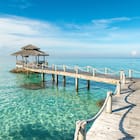
Holiday Themes In phuket

Popular International Destinations
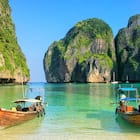
Popular International Countries
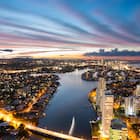
Popular Flights To phuket
- BOM Mumbai HKT Phuket
- Indigo 6E-1911
- 16:55 21:45 Non Stop
- 04h 50m Non Stop
- CJB Coimbatore HKT Phuket
- TIGER AIRWAYS TR-541
- 23:30 06:55 1 Stop
- 07h 25m 1 Stop
- BLR Bangalore HKT Phuket
- Indigo 6E-1077
- 06:10 09:45 Non Stop
- 03h 35m Non Stop
- COK Cochin HKT Phuket
- Indigo 6E-548
- 02:50 21:45 1 Stop
- 18h 55m 1 Stop
- MAA Chennai HKT Phuket
- Indigo 6E-5314
- 06:55 21:45 1 Stop
- 14h 50m 1 Stop
- AMD Ahmedabad HKT Phuket
- Indigo 6E-2046
- 07:40 21:45 1 Stop
- 14h 05m 1 Stop
phuket Travel Talk Sharing travel experiences - one story at a time
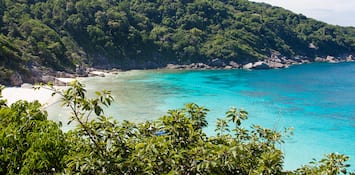
7 Awesome Experiences You Will Miss If Phuket Is Not On Your Thai Itinerary
This exotic ‘Pearl of the Andaman Sea’ is waiting to be discovered by you! And fascinating is the least of the adjectives, that describes it!

Shop Till You Drop in Phuket
Here’s a taking a sneak peek at the shopping haven that every year attracts millions of to

Must Packs for a Beach Honeymoon
There is a reason that honeymoon packing is different from that of any other trip. Fo

Frequently Asked Questions
- More About Us |
- Leadership Team |
- Our Products |
- Awards Won |
- Customer Testimonials |
- Press Releases
- Company Overview |
- Quarterly Earnings |
- Press Releases |
- Reports & Presentations |
- SEC Filings |
- Corporate Governance |
- Social Media Disclosure |
- Investor FAQs
- Travel Agent Sign Up |
- Become a Cab Vendor |
- Register Your Hotel |
- Register Your Homestay |
- Sell Holiday Packages |
- Sell Your Activities |
- List Your Bus Inventory |
- Advertise With Us
- Support & FAQs |
- Terms & Conditions |
- Privacy Policy |
- User Agreement
- Domestic Airlines |
- Domestic Flights |
- International Airlines |
- SriLankan Airlines |
- Emirates Airlines |
- Saudi Airlines |
- Nepal Airlines |
- Singapore Airlines |
- Malaysia Airlines |
- Indigo Flights |
- Air India Airlines |
- Go Air Airlines |
- Spicejet Flights |
- Airasia Flights |
- International Flights |
- Flight Schedule |
- Airline Flight status |
- Cheap Air tickets |
- Web Checkin |
- Domestic Hotels (In India) |
- Homestays |
- Yatra for Business |
- Yatra for SMEs |
- India Tourism |
- International Tourism |
- Domestic Holiday Packages |
- International Holiday Packages |
- Trade Fairs 2020 |
- Activities |
- Domestic Activities |
- International Activities |
- Bus booking |
- Bus Ticket |
- Indian Railways |
- Check Train PNR Status |
- Monuments of India |
- Taj Mahal |
- Qutub Minar |
- Yatra Android Mobile App |
- Yatra iOS Mobile App |
- Gift Vouchers |
- Dubai Visa |
- Thailand Visa |
- Thailand Business Visa |
- Thailand Tourist Visa |
- Sri Lanka Visa |
- Sri Lanka Business Visa |
- Sri Lanka Tourist Visa |
- Turkey Visa |
- Turkey Business Visa |
- Turkey Tourist Visa |
- Malaysia Visa |
- Hong Kong Visa |
- Vietnam Visa |
- Visa At Your Doorstep |
- Uk Visa At Your Doorstep |
- Delhi to Mumbai Flight |
- Delhi to Patna Flight |
- Delhi to Goa Flight |
- Patna to Delhi Flight |
- Pune to Delhi Flight |
- Bangalore to Varanasi Flight
- Retail Offices |
- Bug Bounty |
- Darjeeling |
- Resorts Near Me |
- Oyo Rooms Near Me |
- Interpack 2020 |
- Drupa 2020 |
- Connect with us :
Copyright © 2022 Yatra Online Limited, India. All rights reserved
Thailand World Adventure
traveling in thiland
Exploring the Historical Journey of Old Phuket Town
Are you ready to embark on a captivating journey through the rich history of Old Phuket Town? Prepare to be amazed as you delve into the fascinating transformation of this vibrant city in Thailand. Explore the intricate details of its historical architecture, wander through its bustling streets filled with charming cafes and boutique shops. Discover the true essence of Thai culture as you savor the mouthwatering flavors of local cuisine and soak up the sun on the pristine beaches. Join us on this historical journey and let the allure of Old Phuket Town transport you back in time.
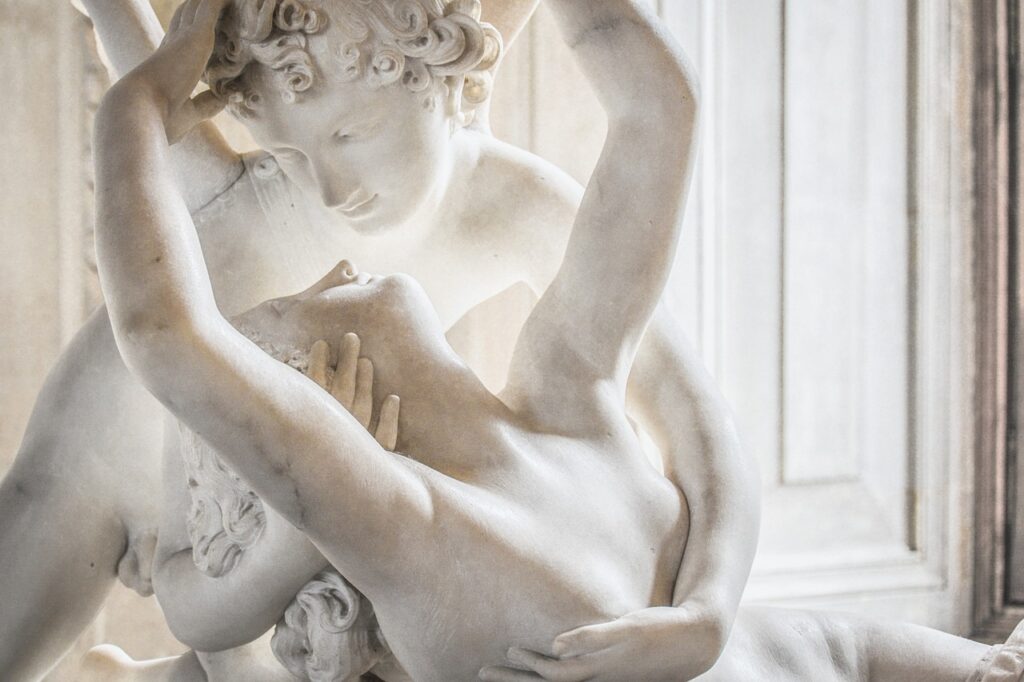
Table of Contents
The Founding of Phuket Island
Phuket Island, located in the Andaman Sea, has a rich and fascinating history that stretches back centuries. The island was originally home to small communities of sea gypsies, who built their homes on stilts along the coastline. These early settlers relied on fishing and trading with passing ships for their livelihood.
Early Settlers
As time went on, Phuket Island became an important trading post in the region. The island attracted settlers from various cultures, including Chinese and Portuguese traders. These early settlers brought with them their own customs, traditions, and architectural styles, which would have a lasting impact on the development of the island.
Influence of Chinese and Portuguese Cultures
The Chinese and Portuguese cultures had a significant influence on the development of Phuket Island and its architecture. The Chinese immigrants brought with them their rich cultural heritage, including their beliefs in Buddhism and Taoism. This can be seen in the numerous Chinese shrines and temples that are scattered throughout Old Phuket Town.
The Portuguese, on the other hand, introduced their own architectural style to the island. The Sino-Portuguese architecture combines elements of Chinese and European styles, resulting in a unique and distinctive aesthetic. This fusion of cultures can be seen in the ornate facades, colorful tiles, and intricate carvings that adorn many of the buildings in Phuket Town.
The Rise of Phuket Town
Phuket Town experienced a major boom in the 19th century, thanks to the discovery of tin in the surrounding hills. The tin mining industry attracted a large number of Chinese laborers, who came to work in the mines. As the industry grew, so did Phuket Town, with new buildings and infrastructure being constructed to support the mining activities.
Tin Mining Boom
The tin mining boom brought great wealth to Phuket Island and its residents. With the influx of money, Phuket Town began to transform into a bustling and prosperous city. The streets were lined with shops and businesses, and the town became a center of trade and commerce in the region. The tin mining industry brought economic prosperity to the island for several decades.
Development of Sino-Portuguese Architecture
During the tin mining boom, the Sino-Portuguese architectural style flourished in Phuket Town. Wealthy mine owners and merchants commissioned the construction of elaborate mansions and shophouses, showcasing the unique blend of Chinese and European influences. The Sino-Portuguese buildings were characterized by their elegant facades, intricate details, and a blend of vibrant colors.
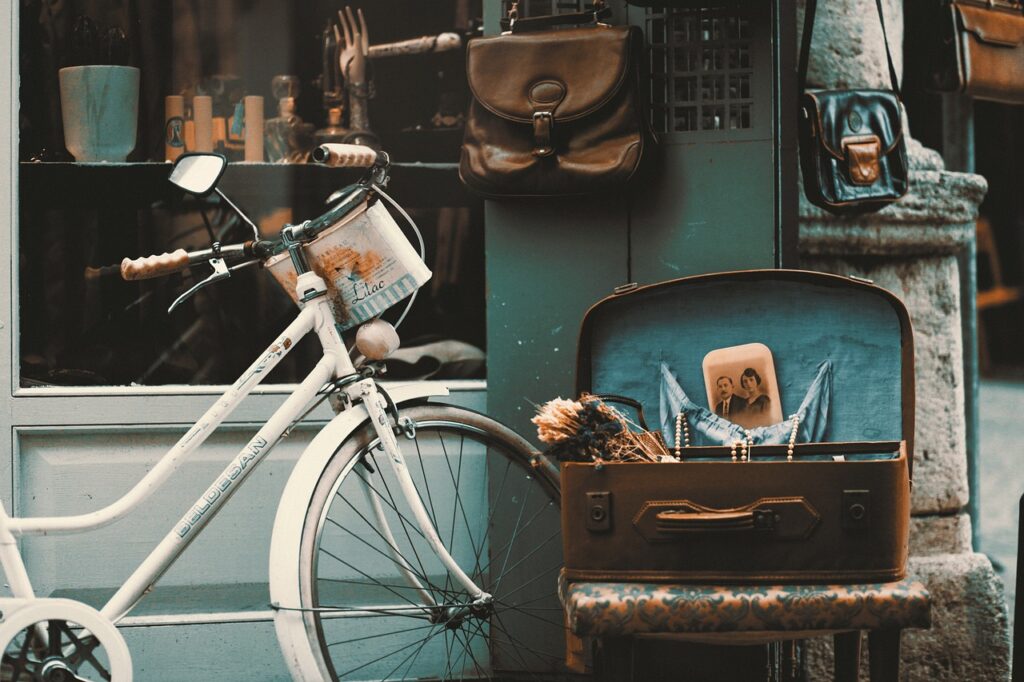
The Decline and Revival
The boom years of the tin mining industry came to an abrupt end with the outbreak of World War II. The war disrupted trade and led to the decline of the industry, leaving Phuket Town in a state of stagnation. The once-thriving city fell into disrepair, and many of the historic buildings were left abandoned.
Impact of World War II
World War II had a devastating impact on Phuket Town. With the disruption of trade and the decline of the tin mining industry, many people left the city in search of better opportunities. The once-prosperous city became a shadow of its former self, with crumbling buildings and a struggling economy.
Rediscovery and Preservation Efforts
In recent decades, there has been a renewed interest in the preservation and revitalization of Phuket Town’s historical buildings. Efforts have been made to restore and conserve the Sino-Portuguese architecture that defines the city’s identity. The preservation of these buildings has not only helped retain the cultural heritage of the island but has also become a major tourist attraction.
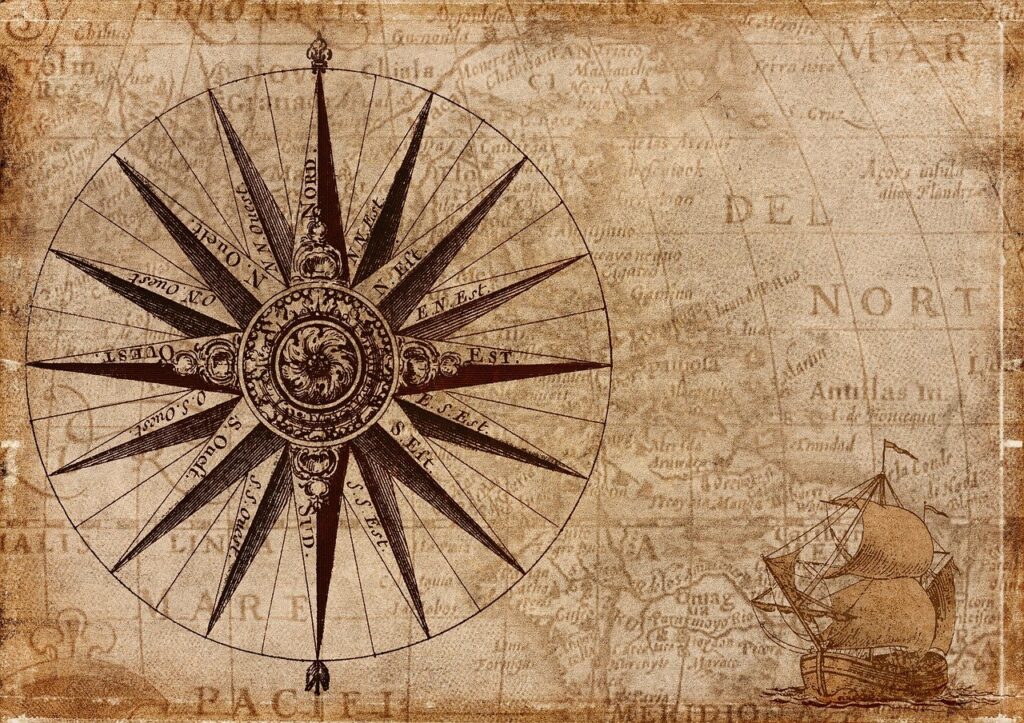
Exploring Sino-Portuguese Architecture
The Sino-Portuguese architecture in Phuket Town is a visual delight, with its unique and distinctive characteristics. The buildings are often characterized by their ornate facades, colorful tiles, and intricate carvings. The architecture reflects the fusion of Chinese and European styles, resulting in a visually appealing and culturally significant aesthetic.
Distinctive Characteristics
One of the main characteristics of Sino-Portuguese architecture is the use of brightly colored tiles. The facades of the buildings are adorned with vibrant tiles, often featuring intricate patterns and designs. Another distinct feature is the use of ornate carvings, which can be found on doors, windows, and balustrades.
Notable Buildings and Streets
Walking through the streets of Phuket Town, you will come across many notable buildings that showcase the Sino-Portuguese architecture. Thalang Road, in particular, is filled with beautiful examples of these buildings. The Old Phuket Town area is home to the iconic Thai Hua Museum, which offers a fascinating glimpse into the history and culture of Phuket Island.
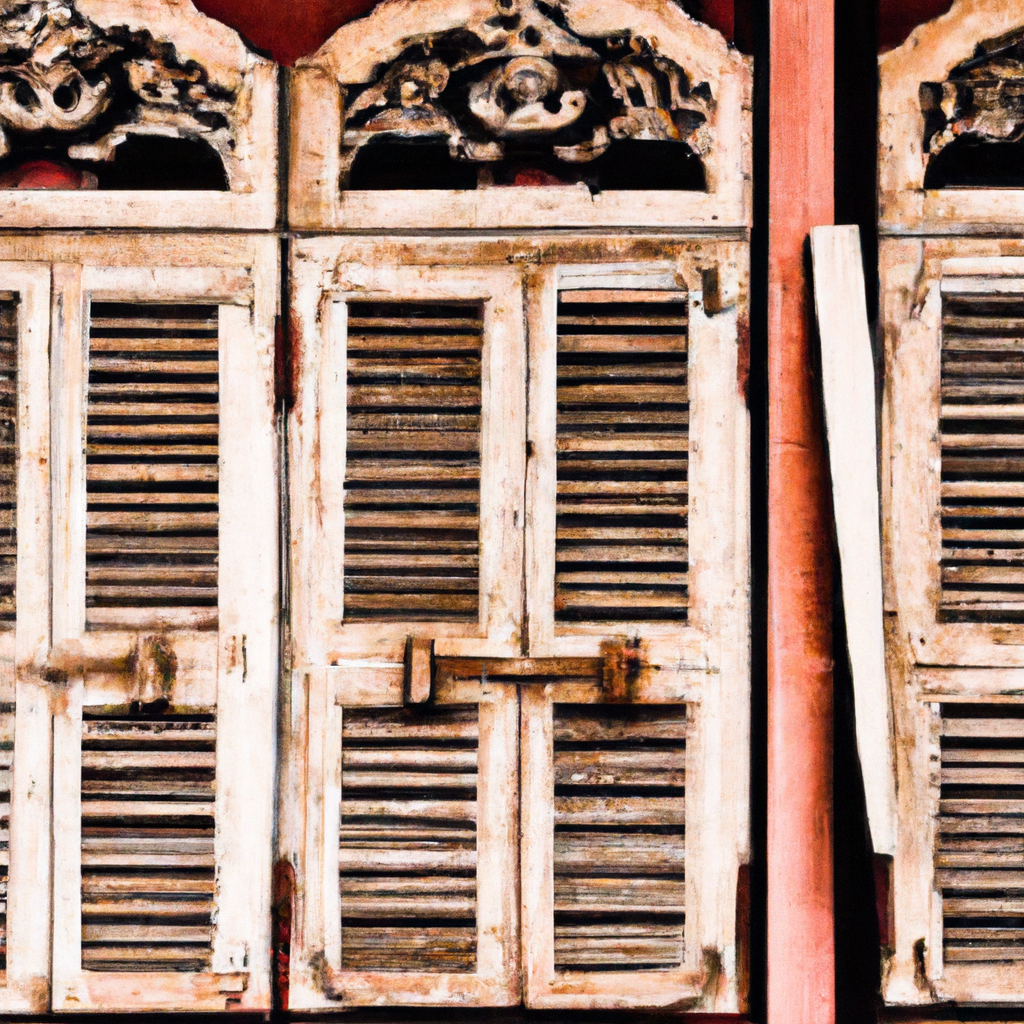
Cultural Heritage of Old Phuket Town
In addition to its architecture, Old Phuket Town is also rich in cultural heritage. The Chinese influence can be seen in the many shrines and temples scattered throughout the area. These places of worship are not only important religious sites but also serve as repositories of history and culture.
Chinese Shrines and Temples
The Chinese community in Phuket Town has a strong presence, and this is reflected in the numerous Chinese shrines and temples. These places of worship are beautifully adorned with colorful decorations and intricate artwork. They provide a tranquil space for worship and reflection and serve as a reminder of the island’s cultural diversity.
Peranakan Influence
Phuket Town also has a significant Peranakan community, which is a blend of Chinese and Malay cultures. The Peranakan influence can be seen in the food, language, and customs of the local community. The Peranakans have made significant contributions to the cultural fabric of Phuket Town and their heritage is celebrated and preserved.
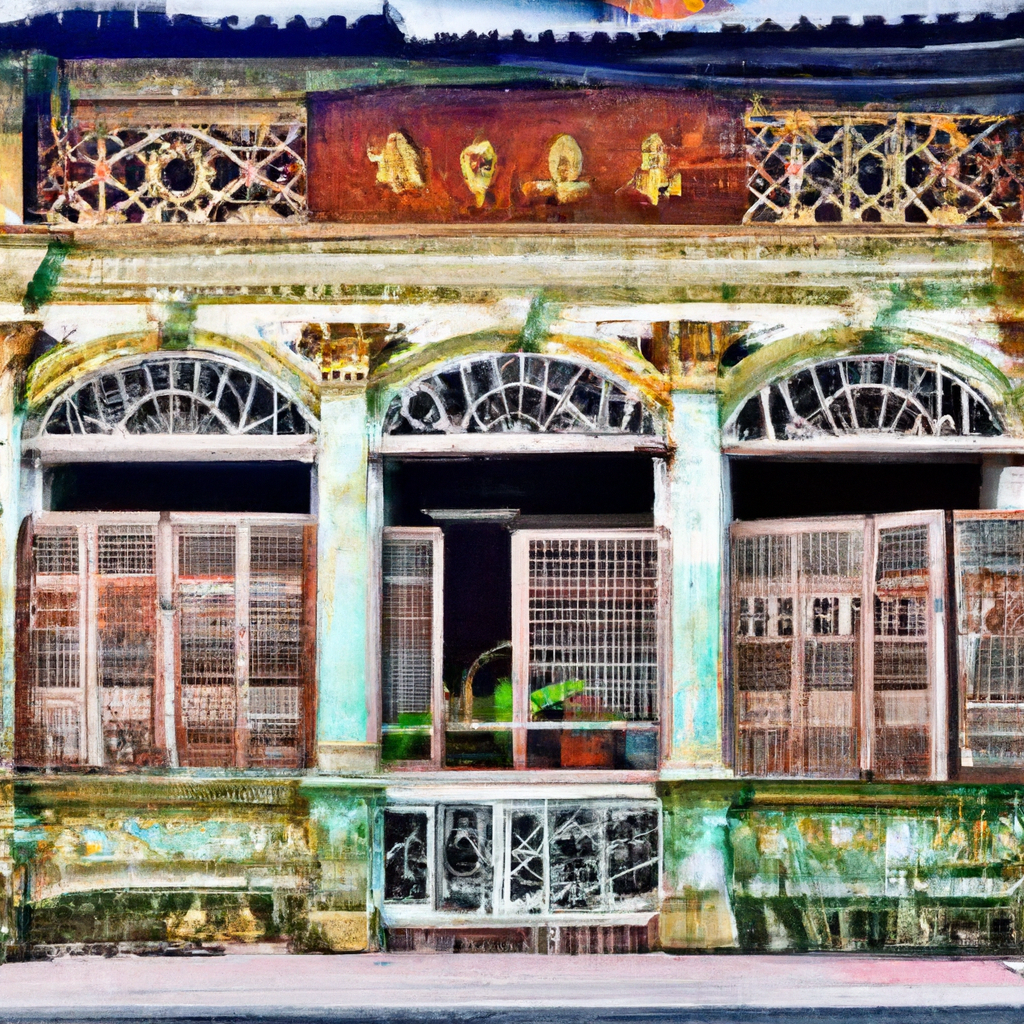
Uncovering Phuket’s Colonial Past
In addition to its Chinese and Portuguese influences, Phuket also has a colonial past that is reflected in its architecture. The Portuguese, who arrived in the 16th century, built forts and other structures that still stand today. These historic buildings provide a glimpse into the island’s colonial history and its connections to European trade and exploration.
Portuguese Forts and Buildings
The Portuguese left behind several forts and buildings on Phuket Island, which serve as a reminder of their presence. One of the most notable structures is the Fort Dumnoen, which was built to protect the island from pirates. The fort has been well-preserved and offers visitors a chance to step back in time and imagine life during the colonial era.
European Influences
Phuket’s colonial past also extends to other European influences, such as Dutch and British traders who visited the island. These influences can be seen in the architecture of some of the older buildings in Phuket Town. European-style elements, such as windows with shutters and balconies, add to the unique charm and character of the town.
Old Phuket Town Today
Today, Old Phuket Town is a vibrant and dynamic part of the city. The historic streets and buildings have been revitalized, attracting tourists from around the world. Walking through the narrow streets of Old Phuket Town, you will encounter a mix of art galleries, cafes, shops, and museums.
Walking Street Markets
One of the highlights of Old Phuket Town is the walking street markets that take place regularly. Thalang Road, in particular, comes alive every Sunday with vendors selling local handicrafts, delicious street food, and souvenirs. The markets provide a wonderful opportunity to immerse yourself in the vibrant and bustling atmosphere of Phuket’s cultural heritage.
Art and Cultural Festivals
Old Phuket Town also hosts a variety of art and cultural festivals throughout the year. These events showcase the rich artistic and cultural traditions of the island. From colorful street parades to traditional dance performances, these festivals offer a unique opportunity to experience the vibrant cultural tapestry of Phuket.
Preserving and Promoting Old Phuket Town
Efforts have been made to preserve and promote the historical and cultural significance of Old Phuket Town. Conservation projects have been undertaken to restore and maintain the Sino-Portuguese buildings, ensuring that they remain an integral part of the city’s identity. Local authorities and organizations have also worked to promote tourism and raise awareness of the importance of preserving the historical heritage of Phuket.
Conservation Efforts
Conservation efforts in Old Phuket Town have focused on restoring and maintaining the Sino-Portuguese buildings. The aim is to preserve the architectural heritage of the town and ensure that future generations can appreciate its historical and cultural significance. Local organizations and community initiatives have played a crucial role in these efforts, working hand in hand with government bodies to protect and promote Old Phuket Town.
Tourism and Economic Impact
The preservation and promotion of Old Phuket Town have had a positive impact on tourism and the local economy. The historic streets and buildings have become major tourist attractions, drawing visitors who are interested in the island’s rich history and cultural heritage. The influx of tourists has boosted the local economy, with shops, restaurants, and hotels benefiting from increased patronage.
Exploring the Tourist Attractions
Visitors to Phuket Island can explore a range of tourist attractions that showcase the history and cultural heritage of Old Phuket Town. From museums to historic streets, there is something for everyone to enjoy and learn from.
Phuket Thai Hua Museum
The Phuket Thai Hua Museum is a must-visit for those interested in the island’s history and culture. Housed in a beautifully restored Sino-Portuguese building, the museum offers a comprehensive collection of artifacts and exhibits that tell the story of Phuket. From ancient artifacts to contemporary artworks, the museum provides a fascinating journey through time.
Thalang Road
Thalang Road is the heart and soul of Old Phuket Town. This historic street is lined with colorful Sino-Portuguese buildings and is a hive of activity. Walking along Thalang Road, you will find a mix of shops, cafes, and galleries, offering a unique blend of traditional and contemporary experiences. The street also comes alive during the walking street markets, offering a taste of the local culture.
Experiencing Phuket’s Local Cuisine
No visit to Phuket would be complete without indulging in the mouthwatering local cuisine. The island’s diverse culinary traditions reflect its multicultural heritage, with influences from China, Malaysia, and India. From street food stalls to upscale restaurants, there are endless opportunities to savor the flavors of Phuket.
Unique Thai Dishes
Thai cuisine is renowned worldwide for its bold flavors and aromatic spices. From spicy curries to tangy salads, there is a wide variety of dishes to tickle your taste buds. Some must-try dishes include Pad Thai, Tom Yum Goong, and Green Curry. You can find these delicacies at local eateries or even try your hand at a cooking class to learn the secrets of Thai cooking.
Peranakan Fusion Food
The Peranakan community in Phuket has also contributed to the island’s culinary scene. Peranakan fusion food combines Chinese and Malay flavors, resulting in a unique and delicious cuisine. Don’t miss the opportunity to try dishes like Laksa, Nasi Ayam, and Kueh Chang. These mouthwatering delicacies are a testament to the island’s rich cultural heritage.
In conclusion, the historical journey of Old Phuket Town is a captivating exploration of a bygone era. The influence of Chinese and Portuguese cultures, the rise and decline of the tin mining industry, and the efforts to preserve and promote the cultural heritage are all part of the tapestry that makes Phuket Island an enchanting destination. Whether you’re strolling through the streets admiring the Sino-Portuguese architecture or indulging in the flavorful local cuisine, Old Phuket Town offers a unique and immersive experience that will transport you back in time.
By erez1333
erez1333 is the author behind ThailandDude.com - the ultimate digital companion for exploring Thailand. With the tagline "Thailand Traveling," this website provides comprehensive and up-to-date information about traveling in the Land of Smiles. From destinations and culture to adventure and activities, every aspect of the Thai travel experience is covered. They prioritize sustainable tourism and offer practical tips for smooth journeys. The website also fosters a community of fellow travelers. Let ThailandDude.com be your gateway to experiencing Thailand in all its glory. Plan your trip or reminisce about past travels with their expert guidance.
Related Post
How to get to don muang airport from bangkok, how many airports in bangkok, how to go grand palace bangkok, what terminal is vietjet in bangkok.
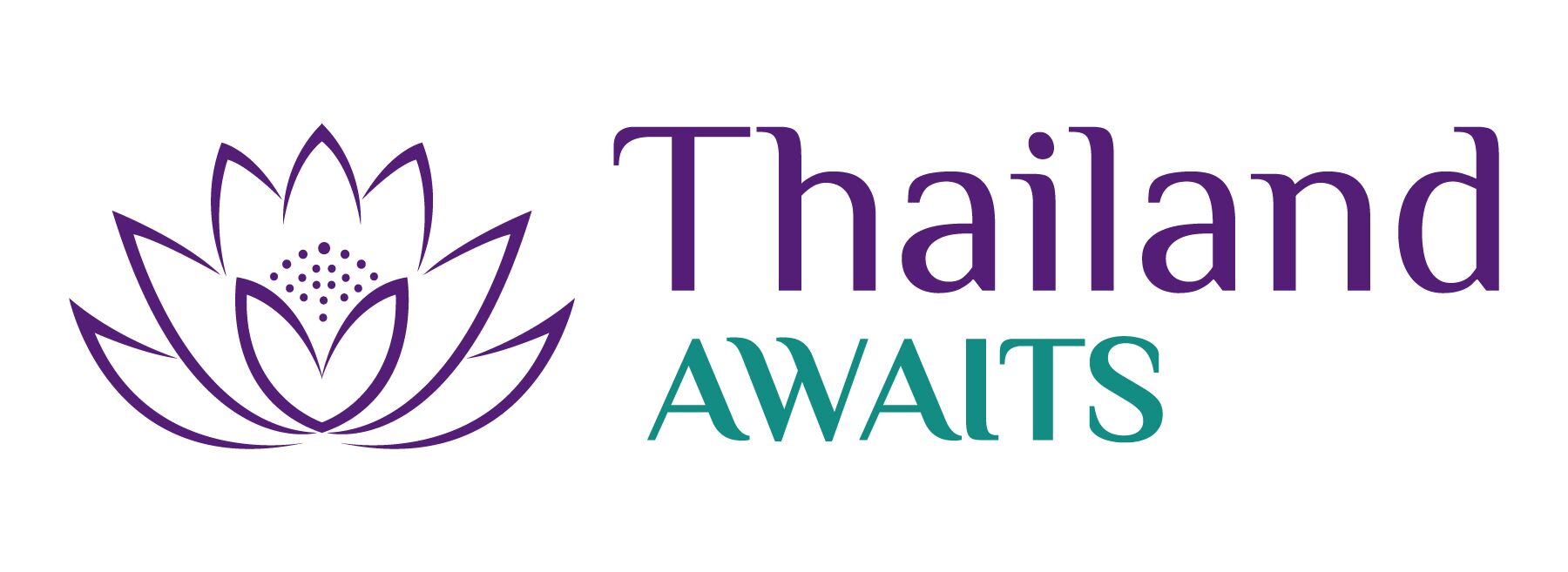
Phuket Old Town: From SHopHouses to Street Art [A self-guided walk]
Phuket Old Town is one of the most endearing places in Phuket , filled with vibrant colour, rich history, and food that make your taste buds dance with joy. Most visitors only make time for the Sunday market, but there’s a whole lot more to see and do here. We recently spent 3 nights based in the old town and fell in love with the beautiful Sino-Portuguese architecture and the ambiance found in its old streets.
Read on and see what we got up to – Trust me, this is a place you won’t want to miss !
A brief history of Phuket
The most important streets in phuket old town, thalang road, soi romanee, phang nga road, phuket road.
This page contains affiliate links. You can see our disclosure policy here .
The old town of Phuket is considered the island’s cultural soul, a great place to engage in the history and community of this popular southern Thai island.
The streets themselves have been transformed into living canvases, adorned with captivating murals that tell stories of Phuket’s rich heritage.
So tear yourself away from the stunning beaches and come and learn more about Thai food and culture on the streets of this pretty town.
You may wonder how this stunning Portuguese-style architecture ended up on an island in South East Asia. Well, perhaps it will help if we start with a quick history lesson.
The modern history of Phuket can be traced back to the early 19th century when the island was an important centre for tin mining.
At this time, the King of Siam, who governed the area, granted concessions to foreign companies to mine for tin on the island.
This saw an influx of Chinese immigrants, who brought with them their own culture and architecture. Resulting in Phuket Old Town’s blend of Sino-Portuguese and Thai styles of architecture and even food!
You may notice these streets seem rather uncluttered, that’s because the electricity cables that are a common eyesore across Asia are buried under the streets here.
Immigration continued through the late 19th and early 20th centuries, as the island’s position along the Andaman Sea made Phuket Old Town an important centre for trade and commerce.
Most of the key sights of the old town are found within a small grid in the centre of the city.
Within this compact, very walkable area is the most famous street in Phuket town, beautifully restored buildings, delicious street food, and plenty of coffee shops and restaurants.
Our self-guided tour covers the following streets:
- Yaorawat Road
- Phangnga Road
If you only have one day to explore old Phuket town, try to fit in as many of these streets as you can.
Phuket Old Town walking map
We have marked some of our favourite attractions on this map. Either visit them in order as we did or choose the spots that interest you.
Thalang Road is best known as the home of the Phuket Sunday Walking Street Market. This is likely the one Phuket market you will have on your list of things to do on the island well before you arrive.
Considered by many to be the best market on the island, you will find everything from clothing and handmade crafts to food stalls and street performances in this market.
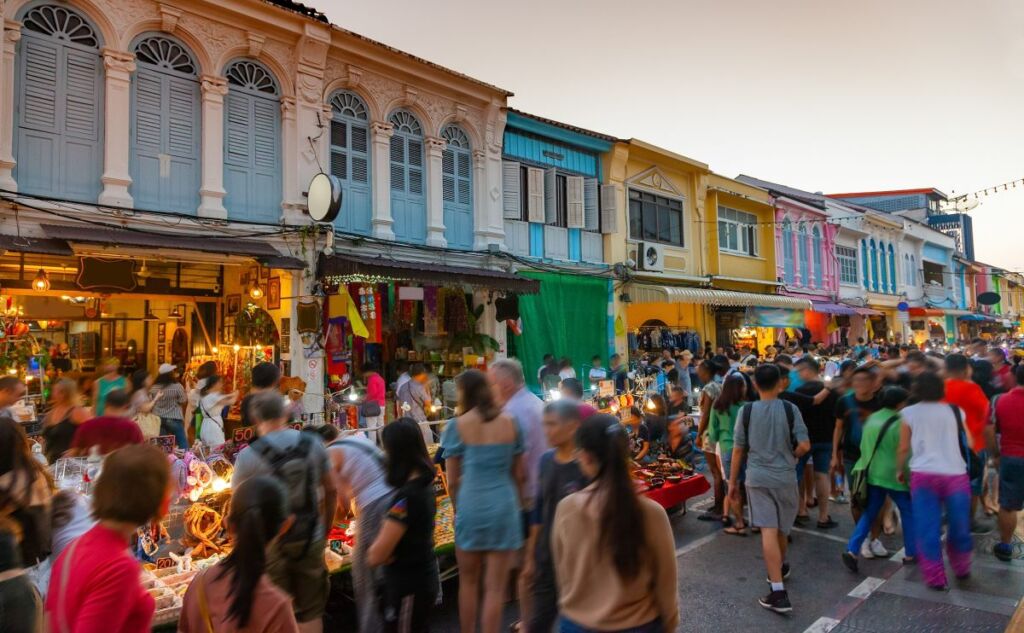
Tip: Try to arrive just before dark, the buildings look especially lovely in the light of golden hour.
Even if you don’t visit on a Sunday you will enjoy strolling Thalang Road and checking out the beautiful shop houses and cafes.
In fact, if possible, I think you should visit twice so you can see it with and without the market crowds.
There are plenty of places ready to tempt you to open your wallet here. We visited and chatted with a herbalist who sold us some ligament I put to good use after some hiking in Chiang Mai .
We also stocked up on crunchy sweet crackers from a small bakery.
Next up we treated ourselves to some sweet roti from Aroon Po Chana , it was so good we went back from breakfast roti the next day.
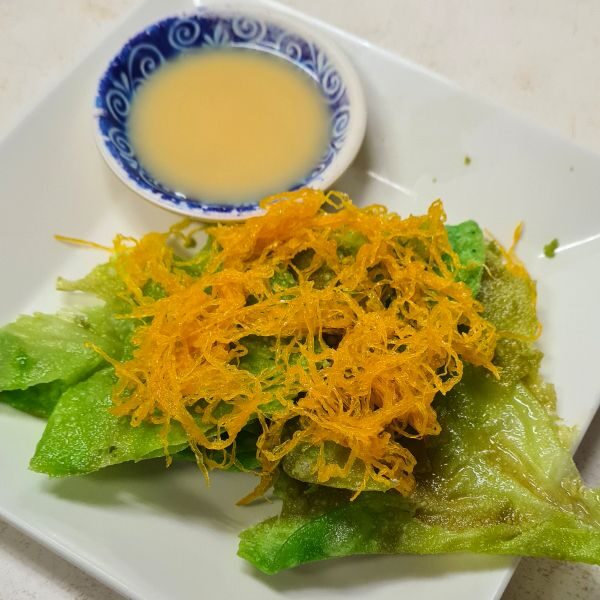
Along with the cafes, restaurants are plenty of shops that attract the locals, even a hardware store. It was nice to see the old town is still a functioning community centre and not just a tourist hot spot.
On the Monday morning of our visit, there seemed to be as many locals as visitors doing their shopping.
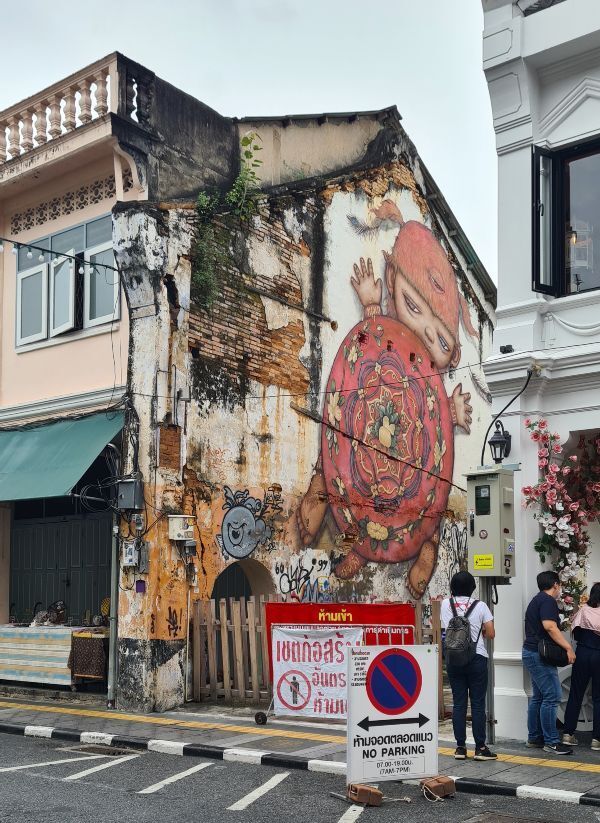
Don’t miss the Alex Face mural on the corner of Thalang Road and Soi Romanee. The artist is one of the best known Thai street artists and if you are visiting Bangkok I am sure you will come across his work again.
Eat: Aroon Po Chana – Best known for their roti, both the sweet and savoury ones are excellent. Open for lunch and breakfast I think it’s impossible to beat the Pandan roti with foi tong (egg threads), and condensed milk for a sweet treat. Drink: Coffee lovers will want to make a pit stop at Hé House Home Cafe for a modern Thai coffee experience. For a more traditional stop try China Inn.
Once famous as the red-light district of Phuket old town, today you will more likely find Soi Romanee packed with visitors snapping the perfect Instagram shot than people looking for love.
This small street is full of traditional Sino-Portuguese houses that are predominantly painted pink and have mainly been converted into shops or cafes.
The star of the show is Aung Ku on the corner- far from a hidden gem, this craft, and coffee shop is Insta-famous for its pink flower-draped exterior.
From mid-morning till early evening, people wait patiently to snap the perfect photo. Head inside for even more floral beauty and gift shopping.
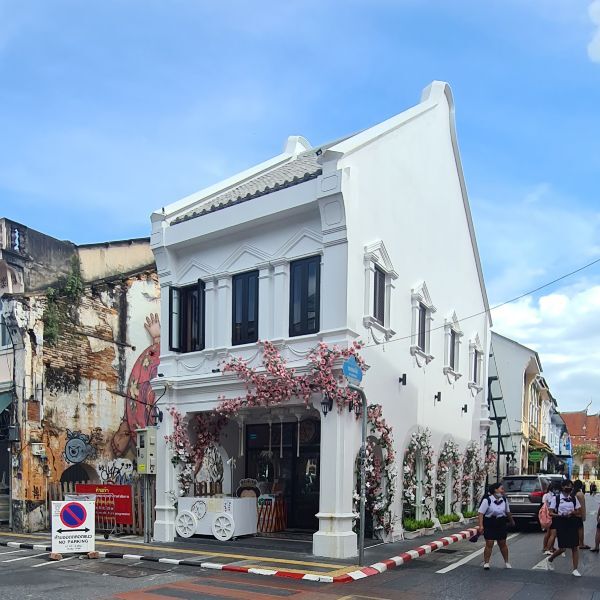
On the back wall of Aung Ku is some of Phuket’s best-known street art with two large-scale murals.
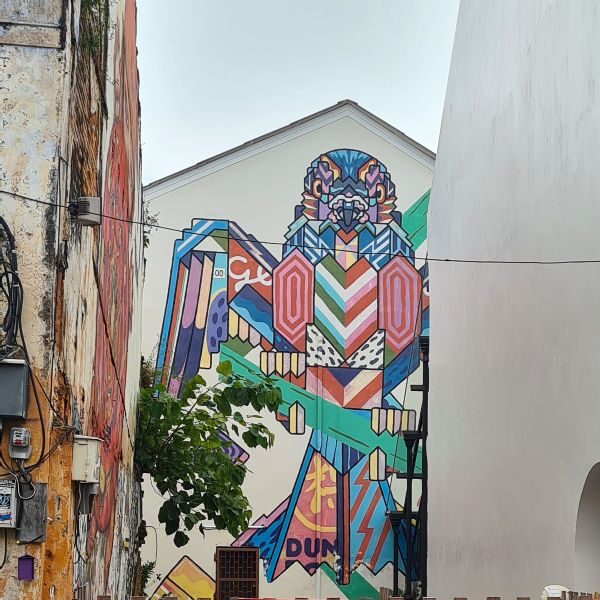
Other notable buildings on Soi Romanee include these pink shop houses which house everything from a post office to an ice cream store.
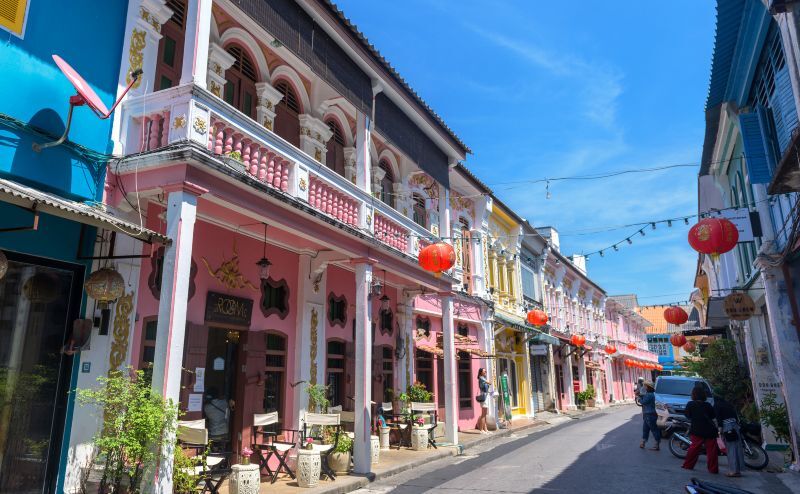
Drink: We grabbed a coffee at Rush Coffee but you could easily go cafe hopping along this small street with three excellent options. Eat: Pornthip Old Town does delicious traditional Thai desserts that are the perfect antidote to the heat. You can also pick up packaged Thai sweets to take home as souvenirs.
From Soi Romanee turn left into Dibuk Road…
Dibuk Road, which is parallel to Thalang Road, is home to several restored shop-houses, Wat Mongkhon Nimit, and at the western end of the road between Yaowarad Rd, and Satun Rd the famous strip of colorful properties featured across the internet.
On the corner of Dibuk Road and Yaowarat Road is another example of charming Sino-Portuguese architecture. This one is not open to the public.
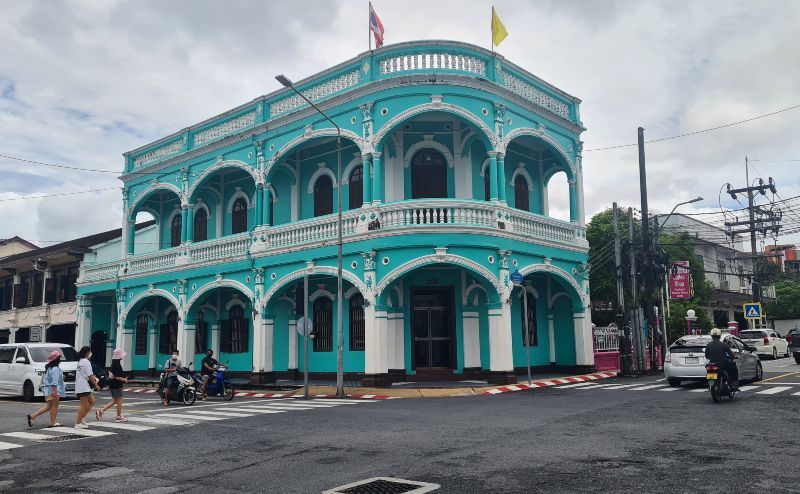
Our favourite stop on Dibuk Road, directly opposite the bright blue building above is a rather nondescript-looking food centre which turned out to be anything but!
We grabbed an early lunch here just before the locals arrived for the midday meals and it was one of our favourite Pad Thai dishes on the island. It’s not fancy, but it’s well-priced, and our three dishes were great.
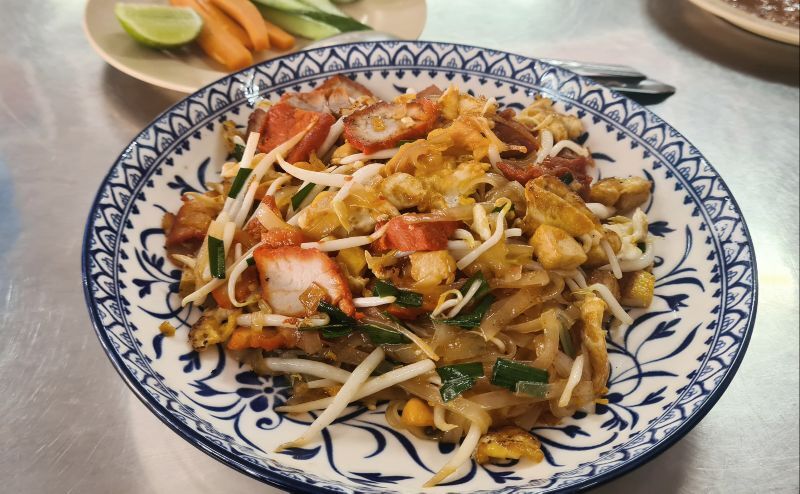
Continue down the street and you will come to a row of beautifully restored and painted shophouses.
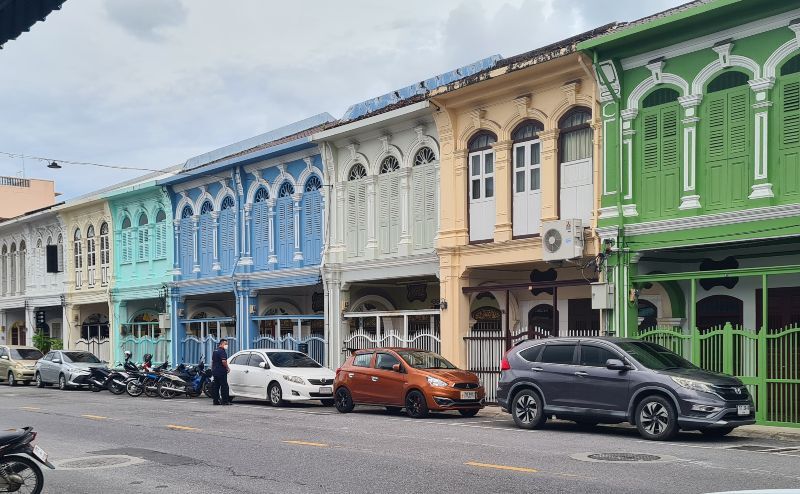
I also loved this old place, waiting for someone to come along and spruce it up… and hopefully not tear it down.
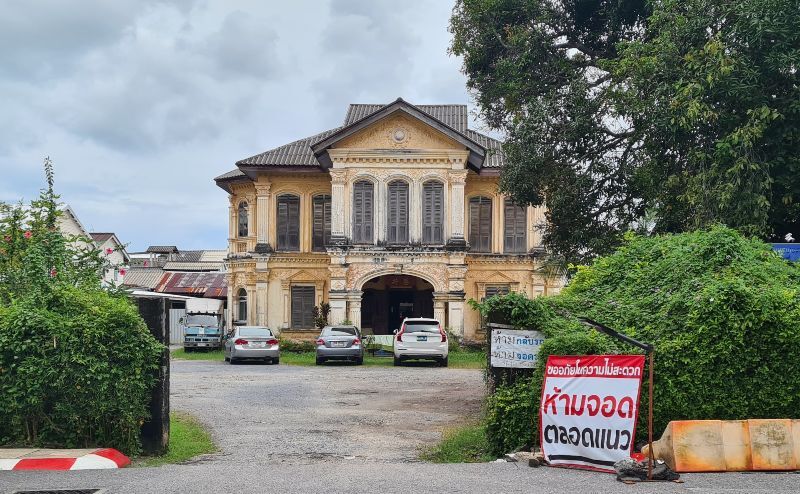
Along this stretch are several restaurants. We visited one that was run by three siblings who had been here for over 50 years.
Sadly I can’t remember the name but the pork soup we had here (below) was sensational. You will find it at 74 Dibuk Street.
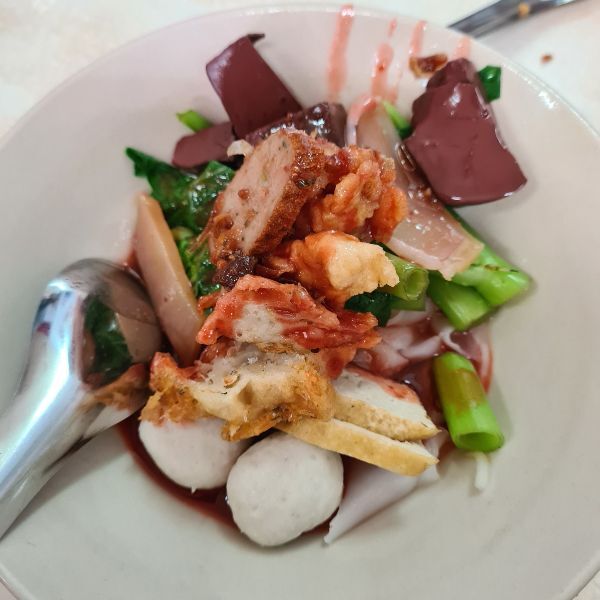
If you want to learn more about the cuisine of Phuket Island we highly recommend this old tour food tour we did while we were there. Just go with a very empty stomach, you will be eating for 4 hours solid.
Drink: Dibuk House is a cocktail bar, just a few steps from the corner of Yaowarad Rd Eat: Lock Tien – Phuket Local Food Centre, for over 50 years, they have been serving up some of the best food in the city.
Continue down Dibuk until you reach Satun and turn left.
As you come around the corner, you will see a gravel driveway almost opposite. Make your way along the driveway to the Blue Elephant Cooking School which is housed in one of the old town’s most impressive buildings that dates back to 1903.
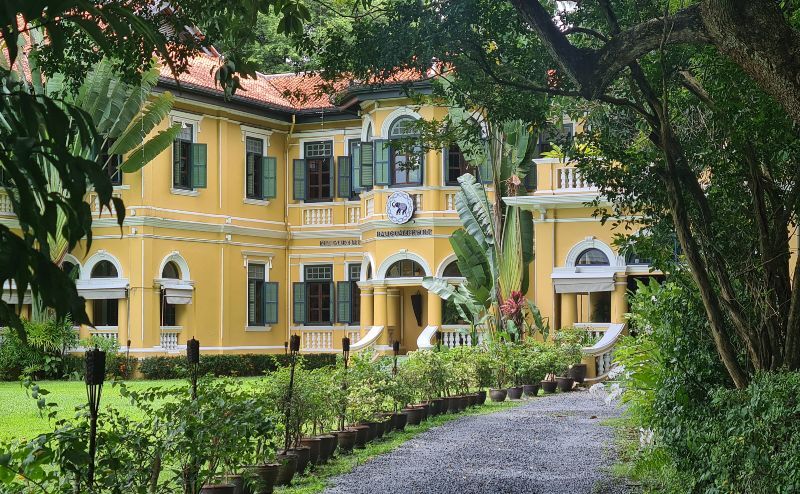
You can book to dine here or just pop into the onsite shop and buy some souvenirs for a chance to glimpse the inside of this gorgeous property.
Our last stop is Chin Pracha House, which is right next door. A historic mansion that is considered the first example of Sino-Portuguese architecture in the whole of the Phuket province.
The property has been home to the same family since it was built in 1903. The Chinprachas family were wealthy merchants and tin miners.
The house was restored by the great-granddaughter of the original owner and opened as a museum in 2003.
You can explore the mansion’s many rooms, including the grand reception hall, the master bedroom, the dining room, and the kitchen. You may get lucky and be shown around by a family member. A tour will cost you approx 150฿.
As you turn into Phang Nga Road from Yarowat Road you will find this lovely artwork on the wall just a few metres before the Giant Lobster.
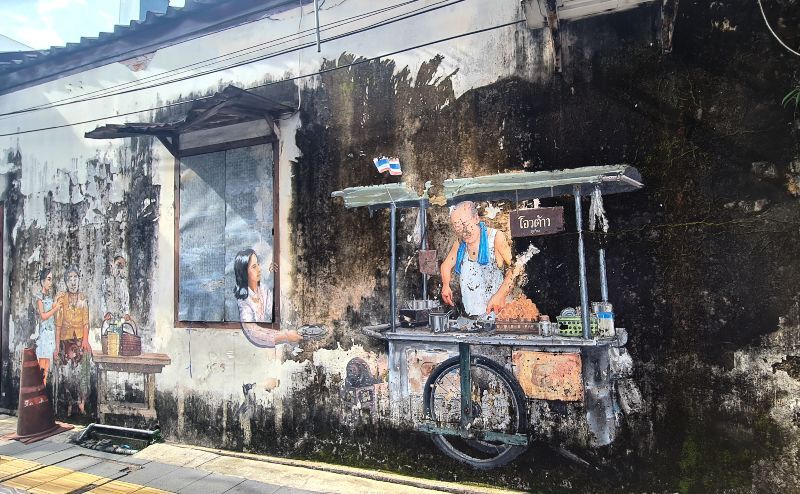
The lobster is outside Tu Kab Khao restaurant and you will see it as soon as you turn into the street.
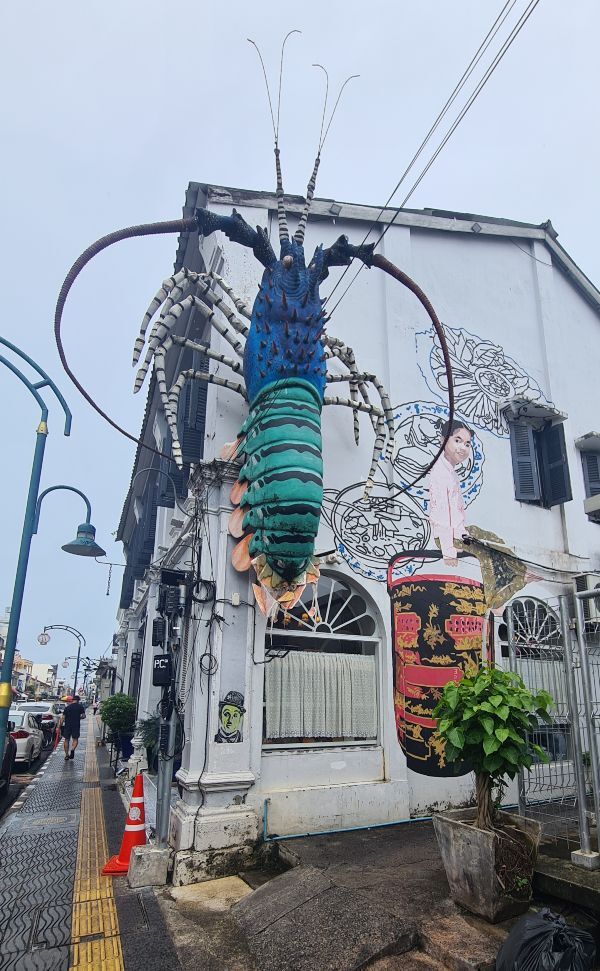
While the lobster draws everyone’s attention, don’t miss what’s sitting right next to it. A very sweet little girl sitting on a tiffin box. These were traditionally used to carry your lunch to work.
We didn’t eat here but have heard it is one of the best places in Old Town to eat lobster, a dish the town is famous for.
The next thing that we came across was this restored building post office box in an alcove of the Kasikorn Bank Building (14 Phang Nga Road).
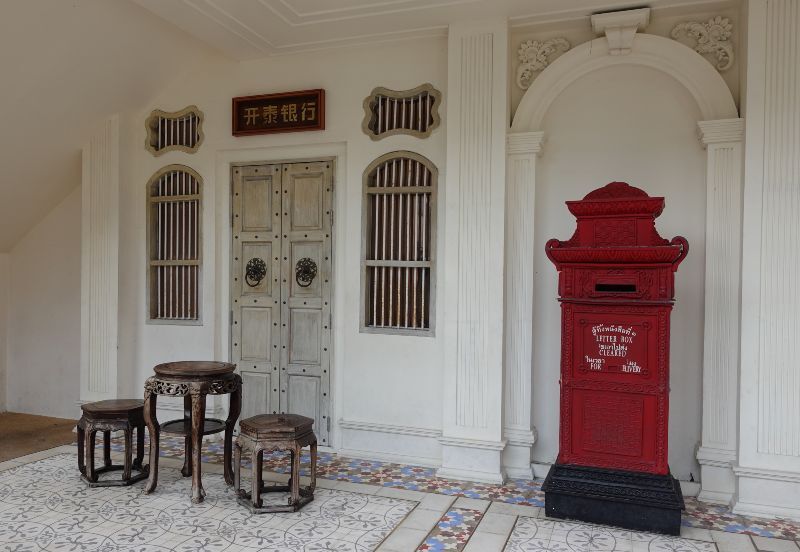
Just across the road is the On On Hotel which featured in the film The Beach.
Opening in 1927 this was the first hotel in Phuket and these days seems like a cross between a hotel and a museum with lots of really interesting objects displayed around the common areas.
It’s a great choice if you want to stay in Old Town.
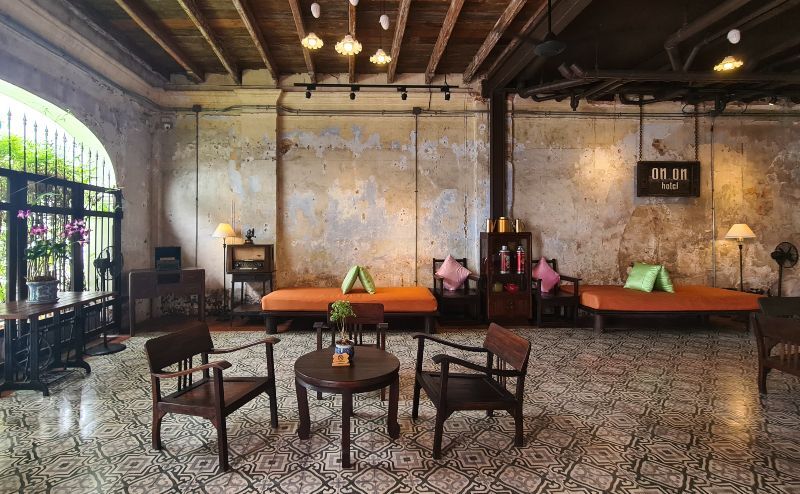
On the side wall of Khun Jeed Yodpak Restaurant just a few doors along you will find another fabulous mural by Alex Face but we will leave that one for you to discover for yourself.
At the end of Phang Nga Road you will come to Phuket Road.
Phuket Road forms one boundary of the old town. On the corner of Phuket Road and Phang Nga Road you will find two bright yellow buildings, the Phuket Baba Museum and directly opposite Museum Phuket (Phuket Nagara).
These two traditional buildings are a popular stop for photos.
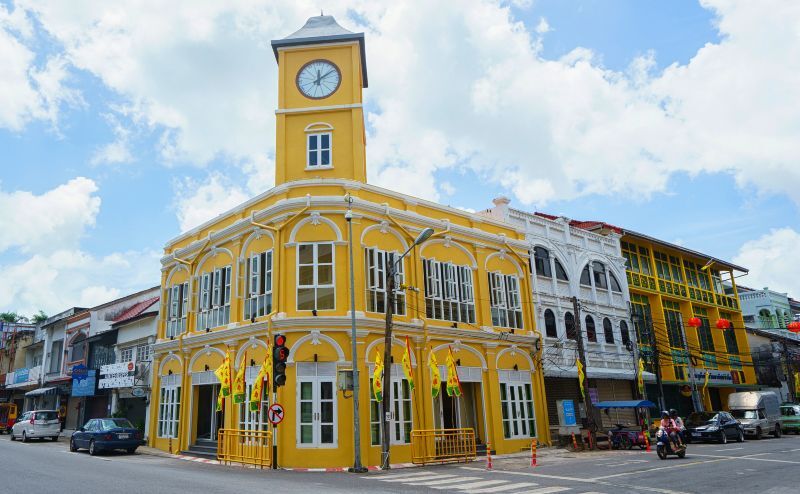
If you only have time for one museum in Phuket the Baba Museum is our pick, with a bonus of free entry. Inside you will find a timeline detailing the history of Phuket, from the early years right up to today.
On the second floor is a virtual reality experience that looks that the influence of Chinese immigration on Phuket town.
Phuket Road is a good place to head for an evening meal with several restaurants and two bars to choose from.
On our last visit, we stayed at Casa Blanca Hotel , a gorgeous, well-priced boutique property in a very central location. It was perfect for exploring the entire old town on foot.
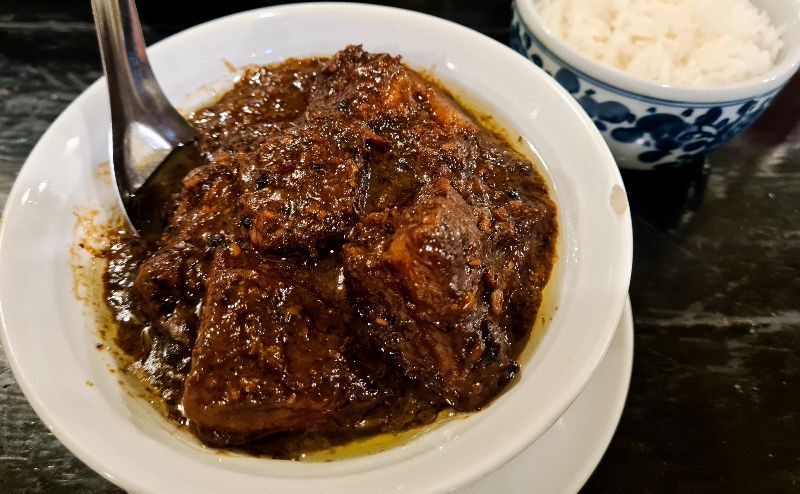
Our favourite dinner was a Michelin Bib Gourmand-rated dish we chose from the Phuket Michelin Guide , Moo Hong Phuket Style, which is a braised pork dish pictured above. It made our top 10 list of things we ate in Thailand last year.
If you are hanging out for a Western meal Papaluza has a Middle East/Mediterranean-style menu and a couple of great house bands. We spent happy hour here a few nights in a row and really had a lot of fun singing along.
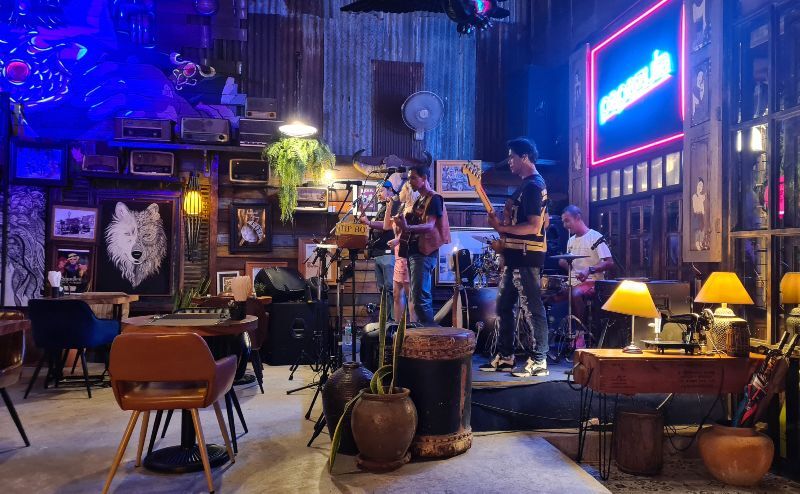
Eat – One Chun Cafe & Restaurant – Michelin listed, their signature dish – the slowly steamed pork belly in pepper and garlic sauce still lingers in my memory every time I think of Phuket Old Town. Drink : Papazula – the party starts at 7 pm with live music several nights a week. We enjoyed a light dinner here one night after a 5-hour food tour at lunchtime saw us too tired to move further afield. Great fun for a bit of a singalong and a friendly team.
Be prepared to fall head over heels for Phuket Old Town. Its captivating architecture, colourful streets, and mouthwatering flavors will weave a spell around you, leaving an planning your next visit before you have reached the airport.
Explore more of Phuket Island
- Night Markets in Phuket
- Phuket diving holidays
- Where to find Phukets best sunsets
- Phuket or Koh Samui – which is right for you
- A Phuket Island Hopping Itinerary
- Phuket Waterfalls
About the author: Paula Morgan has been travelling to Thailand since the mid-1990s and has fallen in love with the people, culture, and of course, the food. These days she visits as often as she can and is planning an extended stay in the country in 2024.

IMAGES
VIDEO
COMMENTS
Tourism. Tourism began on the island in the 1970s with the first beach bungalows at Patong beach. During this time Phuket was a haven for backpackers. Phuket's idyllic tropical beaches and clear warm waters attracted travellers from all over the world to the island. This was facilitated by the building of an airport in the mid-1970s.
The old town of Phuket, with its well-preserved Sino-Portuguese buildings, stands as a testament to this vibrant cultural heritage. Emergence of Tourism: The turning point in Phuket's history came with the rise of tourism in the latter half of the 20th century. The island's pristine beaches, crystal-clear waters, and lush landscapes ...
February 12, 2020. • 8 min read. Phuket, Thailand's lush and mountainous island, glimmers like a polished emerald in the Andaman Sea. Thousands of years before vacationers discovered the sugar ...
Phuket is a beautiful and vibrant island in southern Thailand, famous for its beaches, culture, and hospitality. However, beneath its modern façade lies a rich and complex history that has shaped the island's identity and character. In this article, we will take a journey through Phuket's past, from its early settlement to its rise as a global tourist destination.
Tourism Transformation. Phuket's modern history took a significant turn in the latter half of the 20th century with the rise of tourism. The simplicity of the island's natural beauty attracted global attention, turning Phuket into a renowned tourist destination with the help of the likes of Anantara Mai Khao Phuket Villas.
Phuket history is a tapestry woven with threads of diverse cultures, bustling trade routes, and significant historical events. Let's dive into Phuket's history! ... In the mid-20th century, Phuket began to emerge as a tourist destination. The stunning beaches, vibrant culture, and accessibility attracted visitors, leading to the establishment ...
1 Bedroom Condo for Sale in Prime Location in Phuket From ฿3,707,488. 3,707,488฿. Details. 1. 2. 3. Explore Phuket's rich history, from prehistoric times to modern tourism. Uncover the island's past in trade, indigenous culture, and Thai sovereignty for a deeper, more meaningful visit.
Phuket, Thailand. The island's surface area is mostly level land but is dotted with isolated hills that reach a height of 1,700 feet (520 metres). It was settled as early as the 1st century bce. The island was part of various Tai states from an early time and was incorporated into the Ayutthaya kingdom about the 16th century.
Exploring Phuket Town: the Thai holiday island's cultural capital. Thanks to its strategic southern Thailand location and rich natural bounty, Phuket's backstory is a fascinating, multifaceted one. Europeans (Dutch, Portuguese, French and British) began to land on the Andaman Coast's largest island from the 16th century, but the greatest ...
Phuket History & Culture - Know about Phuket's history, culture, people, tradition, food, climate, language and more. ... Turkey tourism is renowned for its mystical charm, stunning architecture, and rich culture, but your visit to this country will not be a full circle unless you visit the Grand Bazaar in Istanbul. The must-visit spot for any ...
Ancient Phuket History. The island has been established in as early as the first century BC, when Indian settlers arrived to the island. Located along the paths that link China and India, the island served as the shelter and reprieve of foreign traders. In the third century AD, famed Greek geographer Ptolemy managed to arrive at the harbor ...
The history of tourism in Phuket is as colorful as its sunset-drenched beaches and as transformative as its mountainous jungles. Early Beginnings. Historically, Phuket was an important trading post, with Europeans, Arabs, and Indians involved in tin mining and rubber production. However, tourism was not a significant factor in Phuket's economy ...
Tourism. Tourism began on the island in the 1970s with the first beach bungalows at Patong beach. During this time Phuket was a haven for backpackers. Phuket's idyllic tropical beaches and clear warm waters attracted travellers from all over the world to the island. This was facilitated by the building of an airport in the mid-1970s.
The development of Phuket's tourism sector began in earnest in the 1980s, with the west coast beaches, notably Patong, Karon, and Kata, emerging as key tourist destinations. ... This participation signified a new chapter in the club's history and its evolving presence in regional football. Attractions
The Thai government invested in infrastructure, and Phuket's transformation into a world-class tourist destination began. Today, Phuket stands tall as one of the most popular destinations in the world, attracting millions of visitors each year. Phuket's history is a captivating tale of cultural fusion, economic metamorphosis, and resilience.
Kata Noi Beach, Phuket today (Photo attribution unknown) The 70's are maybe the best of the "Golden Age" of Thai Tourism. The beaches of Phuket remained deserted; Ko Phi Phi and Maya Bay undeveloped. The klongs (canals) of Bangkok were still picturesque and you could visit the National Palace without being trampled.
The Phuket Merlin hotel, then known as a five-star hotel in Phuket Town, suffered damages worth 50 million baht. The government declared a state of emergency in the province and forty-seven people were arrested. Phuket's transition from a tin mining center to a world class tourism hot spot has taken place over these few decades.
Backpackers introduced Phuket to the tourism world. The first backpacker-friendly accommodations sprung up in Patong in the 1970s, presaging a steady rise in visitors that peaked at 14 million in 2018. Phuket's present-day attractions have evolved with tourist tastes; beyond the beaches, visitors can now check out Phuket's Michelin-starred restaurants, world-class theme parks, and luxury ...
History of phuket. Phuket's history dates back to 1025 AD when it was merely used as a stopover by the ships sailing between India and China. In the 16th century, the central and northern regions were ruled by the Thais and the rest of the island was turned over for tin trade. Later, there was a trading post established by the Dutch on the ...
Visitors to Phuket Island can explore a range of tourist attractions that showcase the history and cultural heritage of Old Phuket Town. From museums to historic streets, there is something for everyone to enjoy and learn from. Phuket Thai Hua Museum. The Phuket Thai Hua Museum is a must-visit for those interested in the island's history and ...
Phuket has a rich history, it all began because Phuket was Located on trading routes and China, foreign influences had an effect on Phuket way earlier than those same influences effected any other parts of Thailand. Back in the old days beautiful trading ships that were used to carry and transport all the goods for trading, would anchor in the many safe harbors off the Phuket coast line, and ...
A brief history of Phuket. The modern history of Phuket ...
The official site of Tourism Authority of Thailand. Amazing Thailand, Travel information, Travel guide, maps, hotels, accommodation, attractions, events & festivals, food, culture, shopping information to help you plan your Thailand vacations.
In the first three months of this year, 366,095 Russians arrived at Phuket International Airport, almost double the same period of 2023 and transforming the island's commercial and social life.